


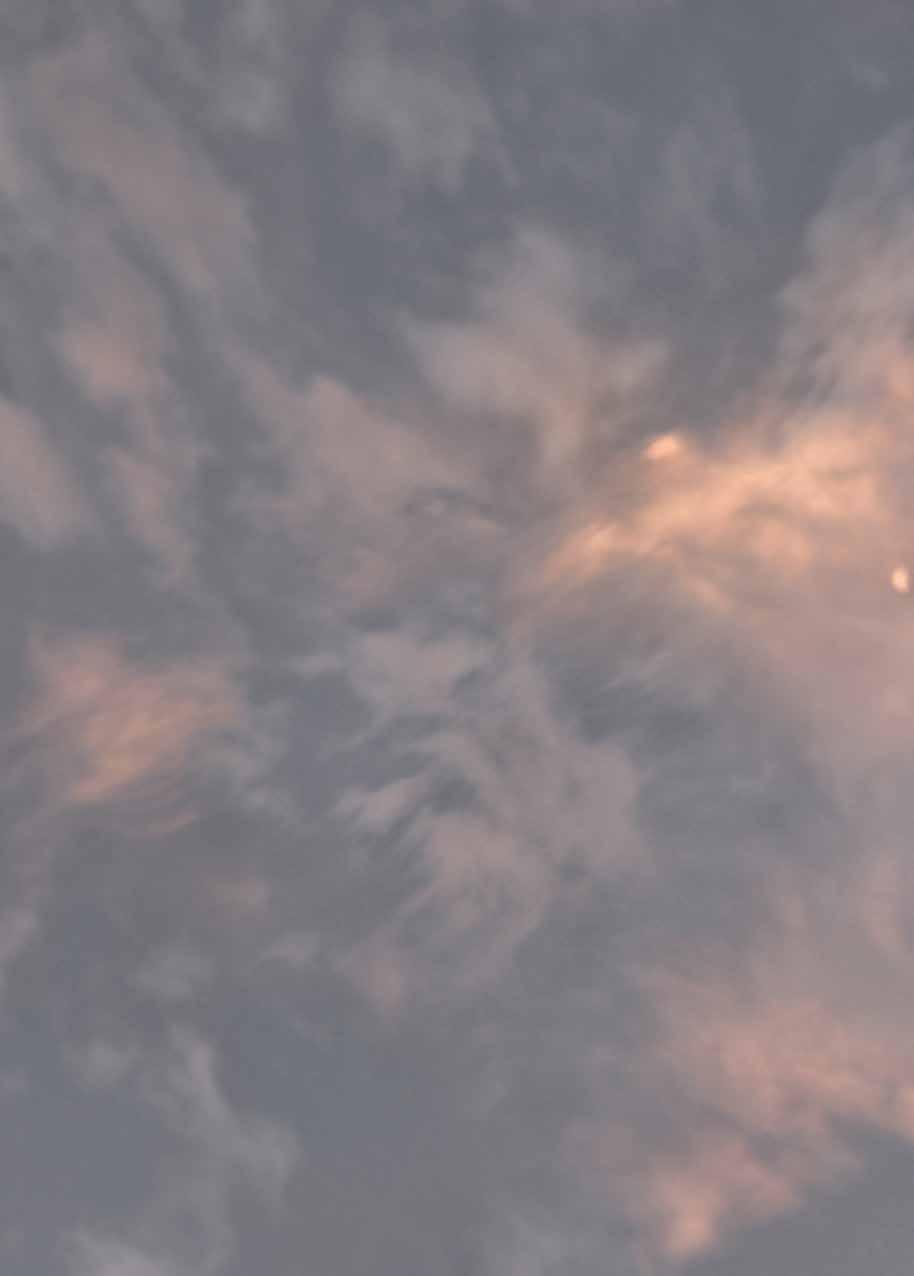




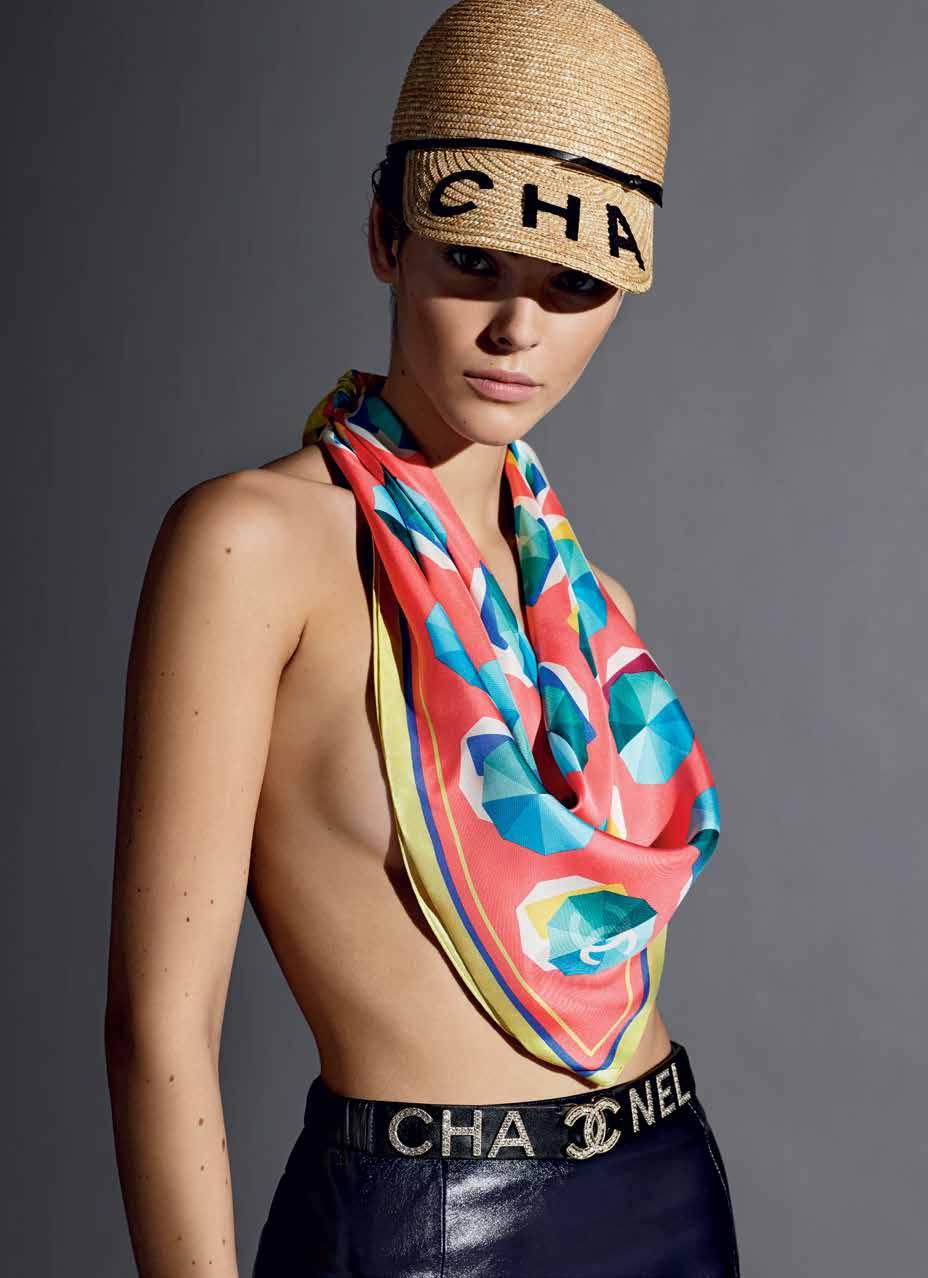
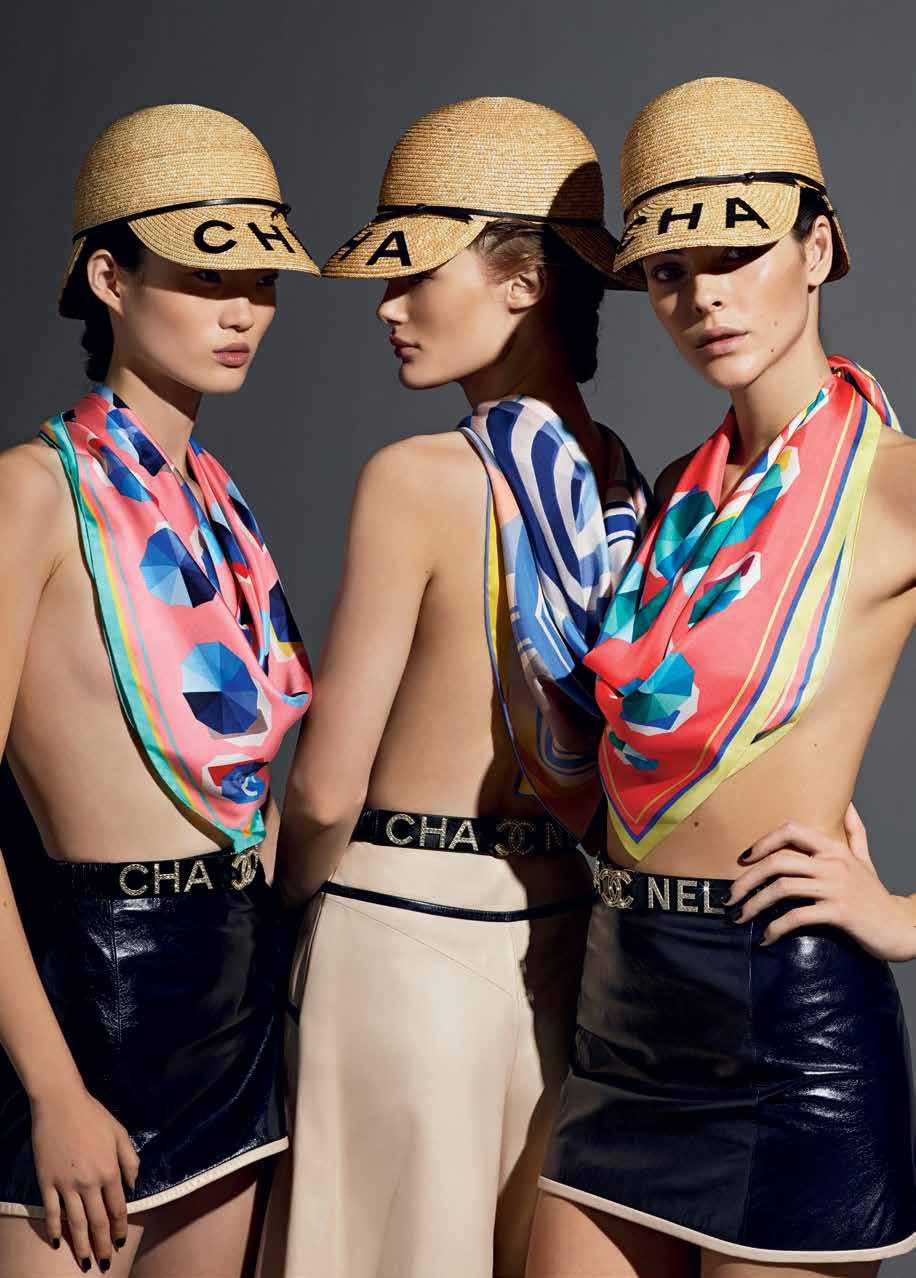


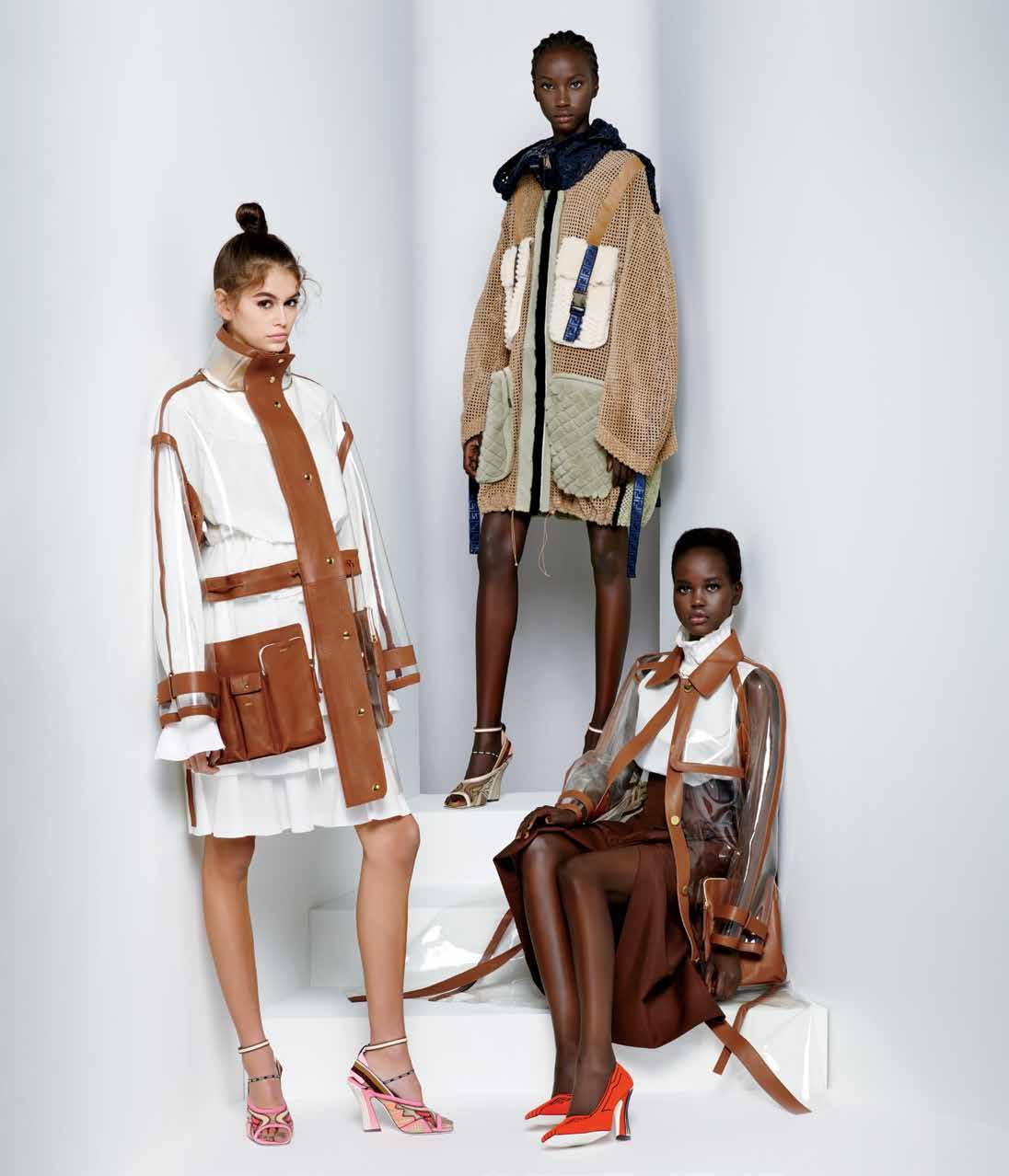
ROYAL HAWAIIAN SHOPPING CENTER ALA MOANA CENTER F EN d I . COM



scan with the fendi app to see exclusive content
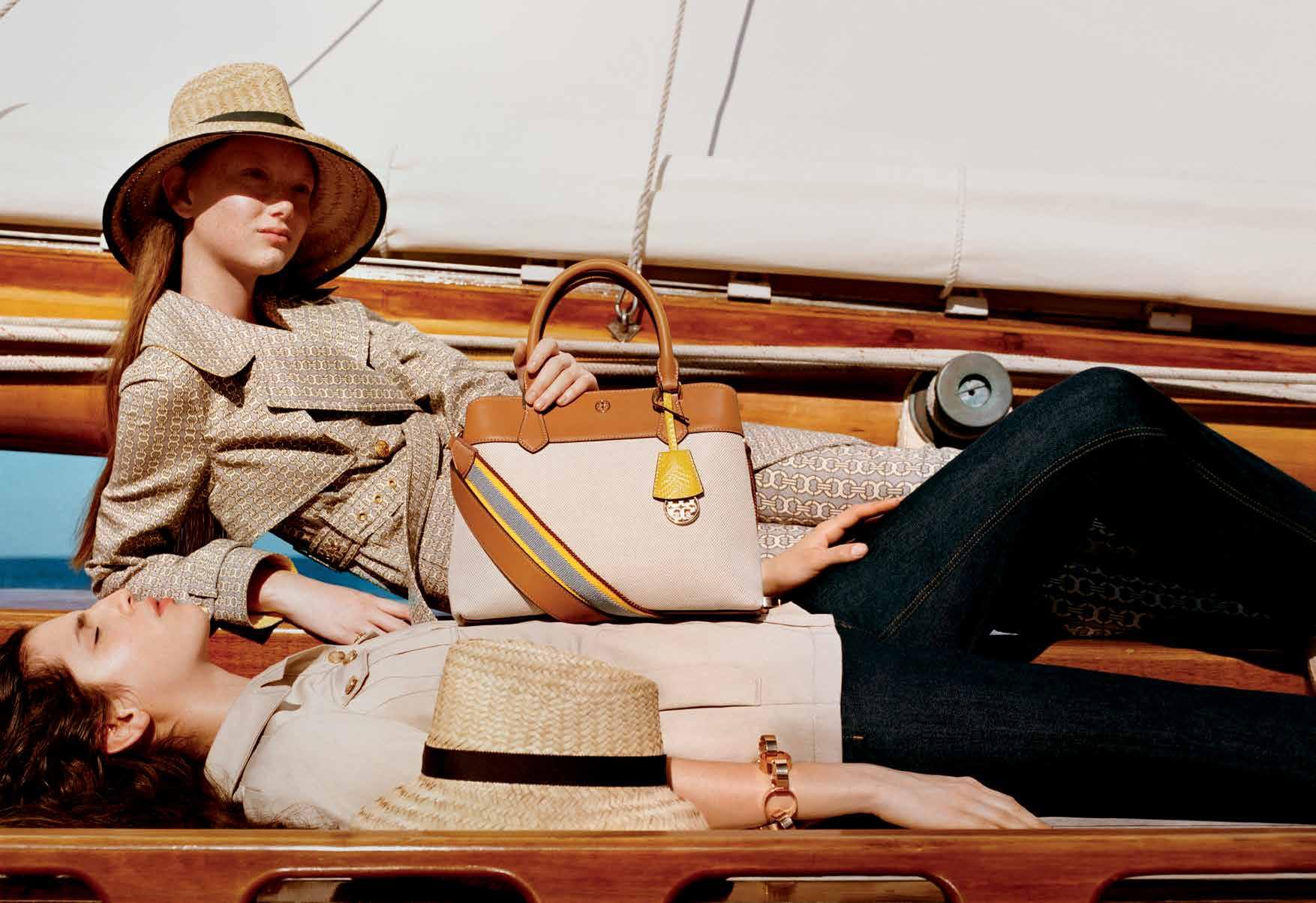
ALA MOANA CENTER ROYAL HAWAIIAN SHOPPING CENTER

In the islands of Hawai‘i, there has long been a deep understanding of a power known as mana that can be found here in our own terrain. It’s a concept not restricted to the material, but includes the spiritual and unknowable.
Mana is derived from the unique richness of Hawai‘i’s natural surroundings and the sense of belonging from the genuine connections we build with others. It’s a sentiment reflected within the residences by The MacNaughton Group and Kobayashi Group, in which we strive to create living spaces that pay tribute to the beauty and strength of Hawai‘i’s natural surroundings and communities.
In this edition of Palm, we celebrate all of the ways that this unknowable mana manifests in the fabric of everyday life. Feel the phenomenal force of nature inspired by Hawai‘i’s volcanoes skillfully captured by a mosaic of historic artists. Gaze at the celestial bodies governing our skies—the same stars that have guided ocean voyagers to Hawai`i. Empathize with the kinship between fathers and sons as they breathe life into their trades, the longing for liberation at the turn of the century, and the crafts that imbue feelings of cultural and musical unity.
To our community of homeowners, we hope that you are inspired by the generous energy and exuberance of this place that we are fortunate to call home.
しかしここハワイでは、人々はこの土地そのものが持つ力を「マ ナ」と呼び、古くから深く理解していました。それは形あるものに 限定された概念ではなく、精神の領域と、知ることの不可能なも のごとをも含む力です。
マナは、ハワイ独特の豊かな自然環境と、私たちが互いの 間に築く真摯なつながりから生まれる帰属の意識から立ち現れ てくるものです。ザ・マクノートン・グループとコバヤシ・グループ が開発したレジデンスにも、そうした感覚が息づいています。私 たちが目指しているのは、ハワイの素晴らしいコミュニティの力と 美しさを体現するような住空間なのです。
今号の『Palm』マガジンでは、ハワイの日常生活の中にあ らゆる形で姿を現す、知り尽くすことのできないマナを讃えてい ます。ハワイの火山が持つ自然の力にインスピレーションを受け たアーティストたち。太古の航海者たちを導き、今も変わらず夜 空を統べる満天の星々。仕事を通して築かれていく父と子の絆。 20世紀初頭の解放運動。そして文化と音楽の統一を感じさせる アート。
私たちの家<ホーム>であるハワイのエネルギーと活力に 溢れた物語が、ホームオーナーの皆様にもインスピレーションを もたらすことができれば幸いです。
14 LETTER From the Developer


ALA MOANA CENTER FERRAGAMO.COM
CEO & PUBLISHER
Jason Cutinella
CHIEF CREATIVE OFFICER
Lisa Yamada-Son lisa@nmgnetwork.com
CREATIVE DIRECTOR
Ara Laylo
EDITORIAL DIRECTOR
Matthew Dekneef
ASSOCIATE EDITOR
Anna Harmon
PHOTOGRAPHY DIRECTOR
John Hook
TRANSLATIONS Japanese Yuzuwords
Korean AT Marketing
CREATIVE SERVICES
Tammy Uy VP Creative Development
Shannon Fujimoto Creative Services Manager
Gerard Elmore
Lead Producer
Kyle Kosaki
Video Producer
Shaneika Aguilar
Video Editor
Mitchell Fong Designer
Aja Toscano Network Marketing Coordinator
ADVERTISING
Mike Wiley VP Sales mike@nmgnetwork.com
Chelsea Tsuchida Marketing & Advertising Executive
Helen Chang Marketing & Advertising Executive
Kylee Takata Sales Assistant
OPERATIONS
Joe V. Bock Chief Revenue Officer
Francine Naoko Beppu Network Strategy Director
Gary Payne VP Accounting
Courtney Miyashiro Operations Administrator
PUBLISHED BY: NMG Network
36 N. Hotel St. Ste. A Honolulu, HI 96817
PALM is published exclusively for: The MacNaughton Group & Kobayashi Group © 2019 by Nella Media Group, LLC. All rights reserved. No part of this publication may be reprinted without the written consent of the publisher. Opinions are solely those of the contributors and are not necessarily endorsed by NMG Network.
16
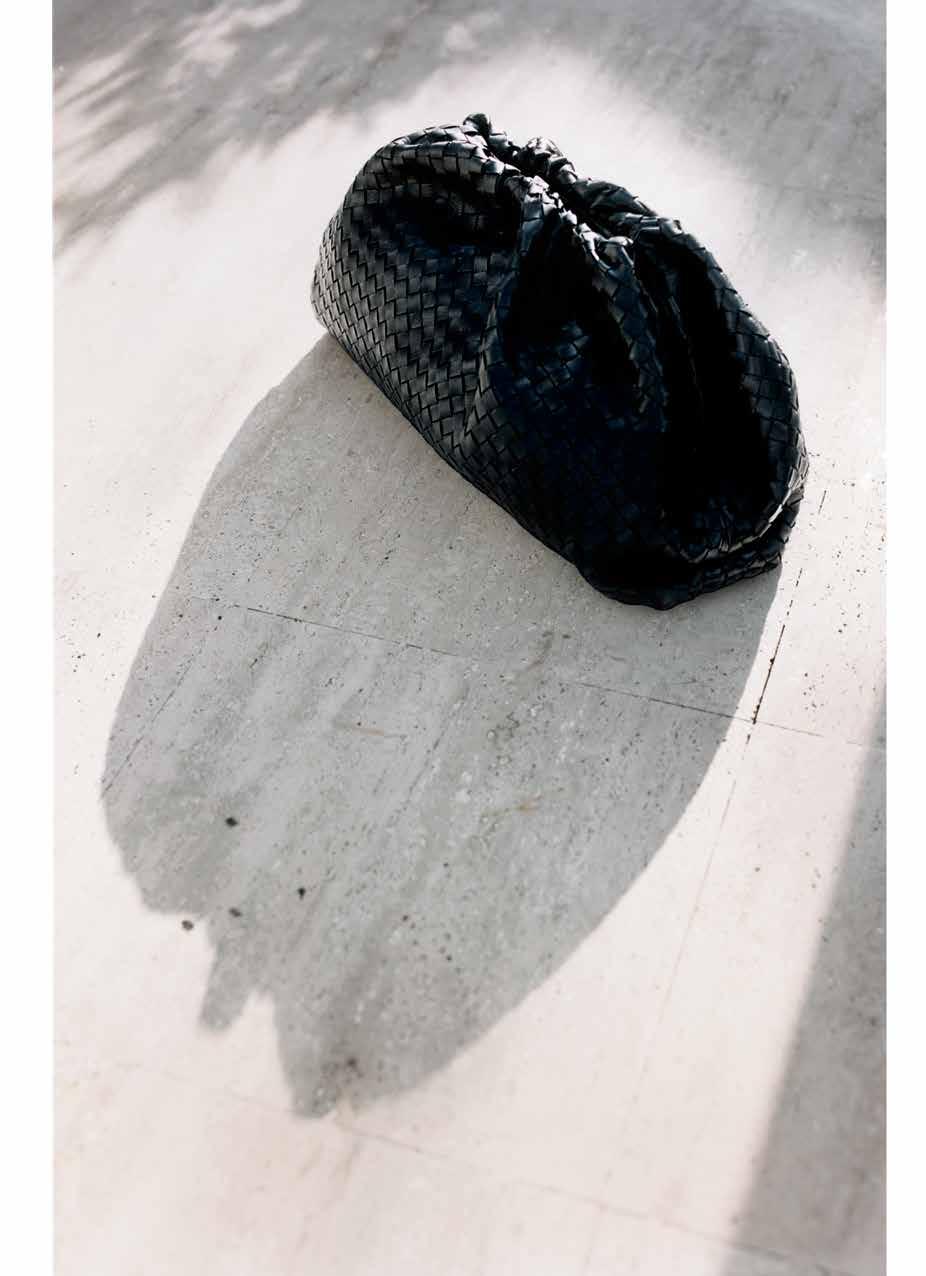


18 TABLE OF CONTENTS ARTS 24 School of Fire 34 Like Father, Like Son CULTURE 48 Where Sky Meets Stone 64 Mana Wāhine DESIGN 76 All Keyed Up 86 Floating in Space 98 Sound & Vision 110 Fashion: In Praise of Shadows ESCAPES 128 Among the Mesas 140 An Island Unto Itself 110 128 ON THE COVER
At the entrancing Snyder House featuring model Nalani Sato, photographed by Mark Kushimi.

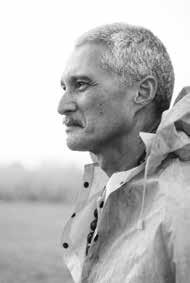
表紙
撮影場所:スナイダー・ハウス
モデル:ナラミ・サトウ
撮影:マーク・クシミ
父と子の絆
文化
力あるワヒネ デザイン
音楽のビジョン 110
ファッション:陰翳礼讃 エスケープ 128
自然体の島

20 48 86 目次
24
34
アート
ボルケーノの画家たち
48
星と岩から学ぶ古代の教え 64
76
86
タイプライターの復権
余白の発見 98
メサに囲まれて 140



















































ALA MOANA CENTER . HONOLULU . 808 951 5600
Visual that amplify
notions
AR TS
A PALM アート
CUL TU RE
of place that A sense fosters the human spirit
the soul of the city
PALM PALM A
23
School of Fire
ボルケーノの画家たち
Text by Sonny Ganaden
文 = ソニー・ガナデン
Images courtesy of Honolulu Museum of Art
画像提供 = ホノルル美術館
24 A ARTS Volcano School PALM
 Jules Tavernier. The Volcano at Night , c. 1885-1889. Oil on canvas.
Image: 19 ¾ x 36 ⅝ in. (50.2 x 93 cm). Frame: 25 ¼ x 41 ¼ in. (64.1 x 104.8 cm). Gift of Mrs. E. Faxon Bishop, 1959.
Jules Tavernier. The Volcano at Night , c. 1885-1889. Oil on canvas.
Image: 19 ¾ x 36 ⅝ in. (50.2 x 93 cm). Frame: 25 ¼ x 41 ¼ in. (64.1 x 104.8 cm). Gift of Mrs. E. Faxon Bishop, 1959.
In the late 19th century, painters lured by the majesty of earth being born anew made journeys from near and far to Hawai‘i Island.
19世紀、大地を新たに生み出し続けていたキラウ ェア火山の荘厳な風景に惹かれて、長い船旅の末 にハワイ島を目指した画家たちがいました。
The painters of the Volcano School, 14 in total, produced hundreds of works in the 19th and early 20th centuries. Most painted eruptions of Kīlauea, a volcano on Hawai‘i Island that has been active since it first emerged from the ocean floor more than 200,000 years ago. Revered by Hawaiians for a millennium, this volcano has long had periods of explosive activity and effusive lava flows. The latter state is what was witnessed by the Volcano School artists, who also but less often painted Mauna Loa. These two volcanoes, along with three others in stages of extinction, dormancy and activity, form the largest island in Hawai‘i.
예술가들은 1세기 이상 하와이 화산에서
영감을 받고 유혹되어 왔다. 그것들은 캔버스부터 사진까지 모든 종류의 매체로 되어 있다. 화산학교 구경하기 킬라우에아를 묘사한 최초의 인물이었던 세기의 변천기 미술가들의 움직임 그녀의 불같은 모습을 그리다
Volcano School members hailed from the Pacific, North America, Europe, and Asia. Ogura Yonesuke Itoh made his paintings in his 20s after he jumped ship in Honolulu as a Japanese sailor. Jules Tavernier, who was from France, painted from close observation, his works rendered nearly entirely in black and crimson. As a whole, Volcano School creations are otherworldly. Most border on the surreal even though they were painted realistically, capturing the unearthly drama of eruptions in the blackness of night. They display lava that looks like rivers and waterfalls, fire and embers replacing the cool hues of rivers and the sea.
19世紀、「ボルケーノ派」と呼ばれる14人の 画家たちが何百枚もの作品を残しました。彼 らが主な画題としたのは、20万年以上前に 海底から現れて以来活発な活動を続けてい るハワイ島のキラウェア火山でした。1,000 年以上にわたりハワイの人々の崇拝の対象 であり続けているキラウェア山は、さかんに 溶岩を吐き出す噴火期と休止期を何度も繰 り返しています。ボルケーノ派の画家たち は、当時活発に溶岩を噴出していたキラウェ ア山を目の当たりにしたのです。キラウェア 山に加え、マウナロア山も画題となりました。 この2つの火山に加え、それぞれ死火山、休 火山、活火山である3つの山がハワイ諸島最 大の島、ハワイ島を形作っています。
ボルケーノ派の画家たちは、太平洋、北 米、欧州、アジアの各地からハワイ島へやって 来ました。その一人、オグラ・ヨネスケ・イトウ は、20代の時に日本人水夫として働いていた 船から逃走した後で絵を描きはじめました。 フランス出身のジュール・タヴェルニエは、詳 細な観察に基づき、画面のほとんどが黒と真 紅で構成された作品をいくつも制作しまし た。全体に、ボルケーノ派の作品は異世界を 描いたかのような趣きを備えています。写実 絵画であるにもかかわらず、漆黒の闇夜に広 がるこの世のものとも思えない噴火の情景を 描いた作品の多くは、シュールレアリズムのよ うな印象を与えます。彼らが描いたのは、冷 たい色の水の代わりに燃えさかる炎とくすぶ る熾き火が流れる溶岩の川や滝でした。
Lionel Walden. Volcano , c. 1915. Oil on canvas. 31 ½ x 47 ½ in. (80 x 120.7 cm). Gift of Frances Damon Holt in memory of John Dominis Holt.
26 A ARTS Volcano School PALM
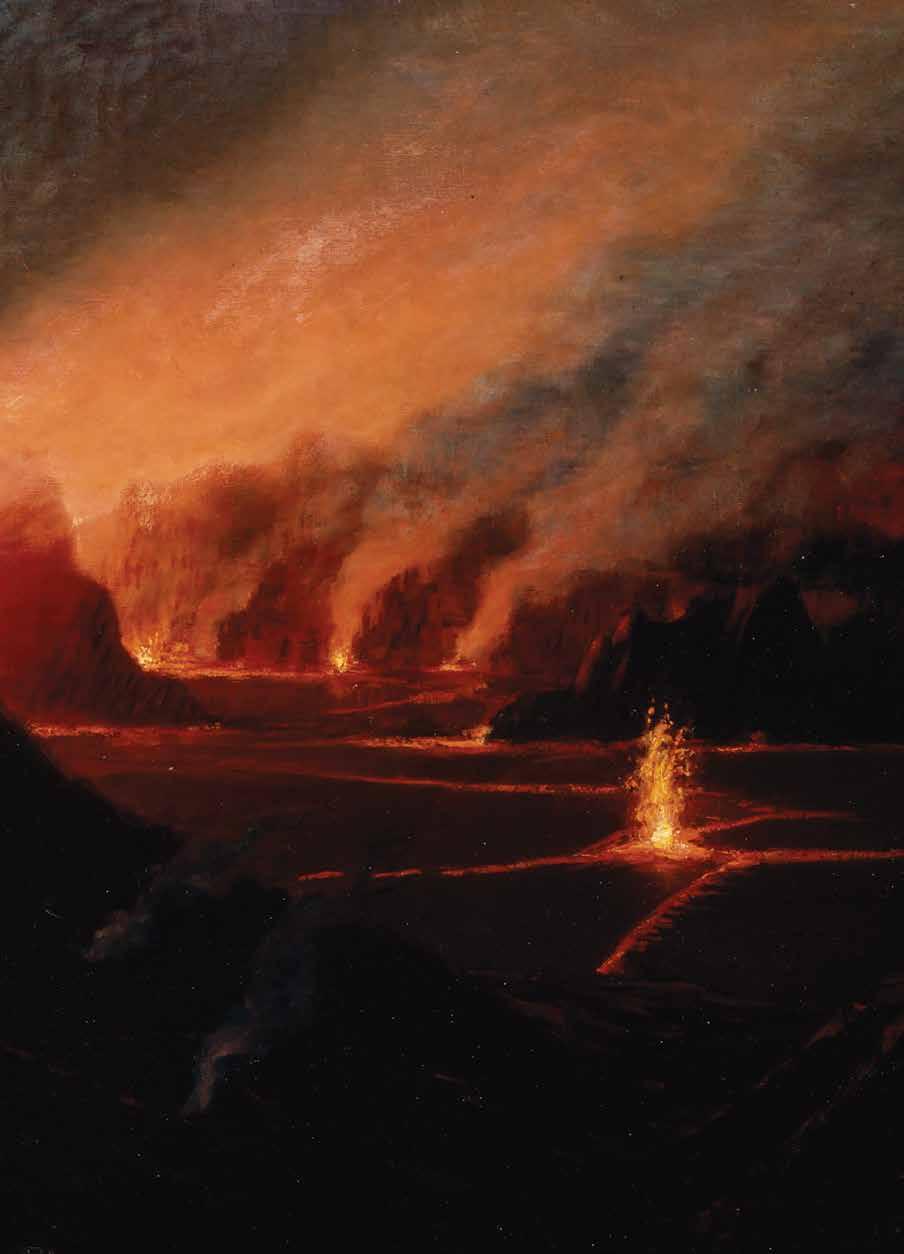

Charles Fumeaux, American, 1835-1913. Untitled , 1888.
Oil on canvas, mounted onto masonite. Frame: 43 ½ x 66 ½ x 3 in. (110.5 x 168.9 x 7.6 cm). Made possible by support from the William Harrison & Mary Sophia Rice Acquisition Fund, Michael & Linda Horikawa and from the Collection of Harry Miura, 2013.
In January 1873, British naturalist and writer Isabella Bird also went to see the volcanoes for herself. “Suddenly, just above, and in front of us, gory drops were tossed in the air, and, springing forwards, we stood on the brink of Hale-mau-mau, which was about 35 feet below us,” she wrote in a book about her journey. “I think we all screamed, I know we all wept, but we were speechless, for a new glory and terror had been added to the earth.” Her descriptions remain unparalleled. “Everywhere through its vast expanse appeared glints of fire—fires bright and steady, burning in rows like blast furnaces; fires lone and isolated, unwinking like planets, or twinkling like stars … an incandescent lake two miles in length beneath a deceptive crust of darkness, and whose depth one dare not fathom even in thought.”
1873年、英国の地理学者でありナチュ ラリストでもあったイザベラ・バードが、この 火山をひと目見ようとハワイを訪れました。 バードはその旅行記でこう書いています。「突 然私たちの目の前で、宙空に血の塊のような ものが噴き上がった。私たちは大急ぎで駆 け寄り、11メートルほど下のハレマウマウ火 口の縁に立った。私たちは皆、大声で叫び、 感動の涙を流していたが、この大地に新しく 生まれた荘厳さと畏怖すべき力を目の当たり にして、誰もが言葉を失っていた」。今日でも バードの描写を超えるものはないでしょう。 「広大な視界のすべてが、炎の輝きを帯びて いた。明るく、絶えることのない燃焼はまる で高炉のようだ。ぽつぽつと孤立した炎には 惑星のようにまたたかないものも、星のよう にきらめくものもある。灼熱の湖はさしわた し3キロにおよび、闇の下に隠されている。そ の深さを推し量ることは誰にも到底かなわな いだろう」。
28 A ARTS Volcano School PALM


702 SOUTH BERETANIA STREET, HONOLULU, HI 808.543.5388 | CSWOANDSONS.COM
 D. Howard Hitchcock. Halemaumau Eruption at Night , 1917. Oil on canvas Image: 18 x 40 in. (45.7 x 101.6 cm). Frame: 23 ½ x 45 ¼ in. (59.7 x 114.9 cm). Gift of Aaron G. Marcus, 1978.
D. Howard Hitchcock. Halemaumau Eruption at Night , 1917. Oil on canvas Image: 18 x 40 in. (45.7 x 101.6 cm). Frame: 23 ½ x 45 ¼ in. (59.7 x 114.9 cm). Gift of Aaron G. Marcus, 1978.
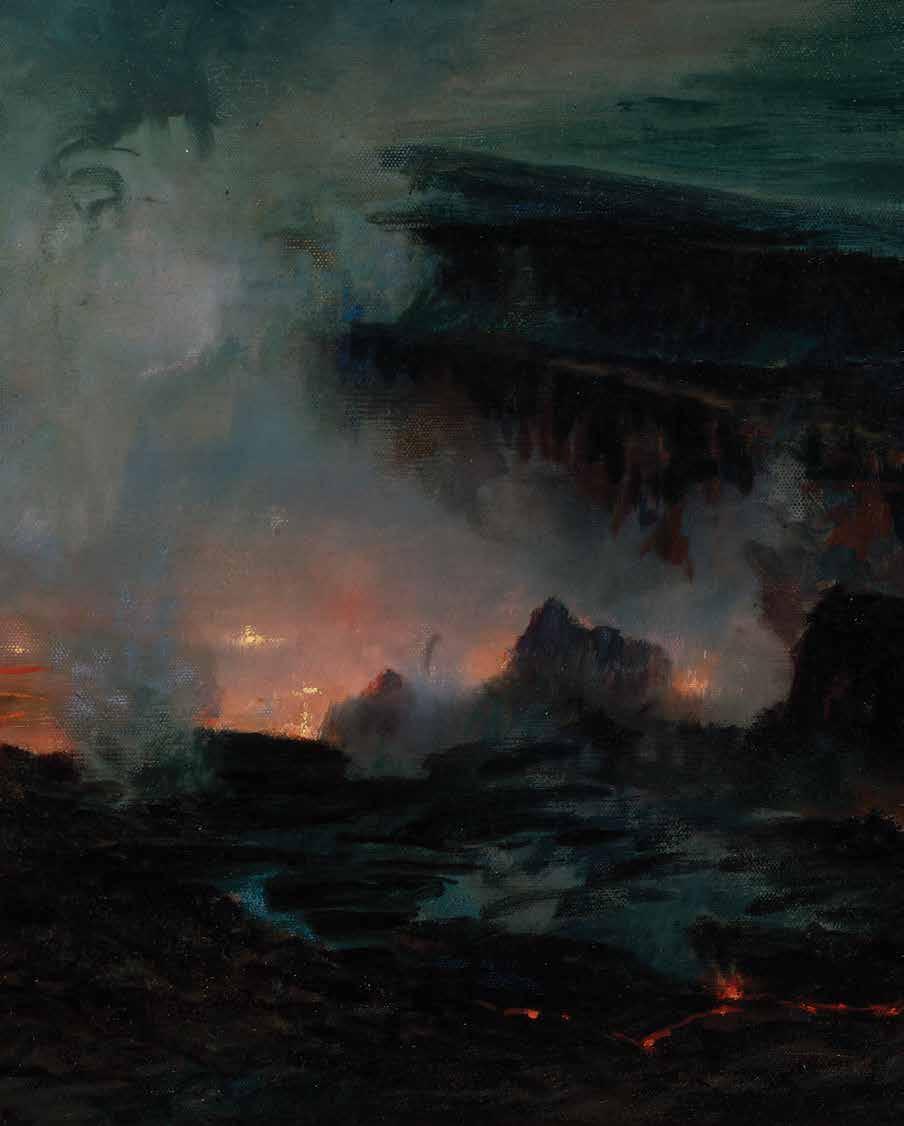
Much has changed since Bird’s writings: Kīlauea is now within the jurisdiction of the United States, and Hawai‘i Island has grown in mass. Remnants of past flows are evident across the eastern flanks of Mauna Loa and Maunakea. But the volcano’s eruptions are as alluring as ever. When Kīlauea erupted again from May to August of 2018, the news and footage enraptured people around the world.
Many Volcano School paintings are in the collections of the Honolulu Museum of Art and the Bernice Pauahi Bishop Museum. In 2016, the Honolulu Museum of Art debuted a piece by one of the school’s luminaries, Charles Furneaux, which it had acquired and carefully conserved. This untitled oil painting shows a milky cloud of vapors encircling a lone lava geyser amid a lake of lava so still its surface reflects the surrounding volcanic outcropping.
Volcano School artists were inspired by religious wonder, transcendentalist views on the purity of nature, and Manifest Destiny. Their paintings also played a functional role, capturing the dramatic light of the sublime better than drawings or cameras, which were flooded by the radiance of molten lava, their plates easily overexposed and ruined. Now, from the depths of museums, the paintings of the volcanoes’ eruptions glow on.
バードが旅行記を書いた時代から、キ ラウェア山を取り巻く環境は大きく変わりま した。キラウェア火山は今では米国の領土 となっています。火山活動によってハワイ島 は引き続きその大きさを少しずつ増してお り、過去の噴火の痕跡は、マウナロア山とマ ウナケア山の東側の斜面にも顕著に残され ています。そして噴火活動はこれまで以上 に人々を魅了し続けています。2018年の5 月から8月にかけてのキラウェア山の噴火の ようすは広く報道され、その映像は世界中の 人々の目を釘付けにしました。
ボルケーノ派の絵画の作品の多くは、 ホノルル美術館とビショップ・ミュージアム に収蔵されています。2016年、ホノルル美 術館はボルケーノ派を代表する画家の一 人、チャールズ・フルノーの作品を展示に加 えました。この無題の作品は同美術館が以 前に購入し保管していたもので、乳白色の蒸 気がプカ(穴)の上に渦を巻き、その下から 溶岩流が覗く光景を描いています。
ボルケーノ派の画家たちは、宗教的な 畏怖の念、超越主義的な思想で解釈した自 然の純粋さ、そして西部開拓の標語であった 「マニフェスト・デスティニー」思想にインス ピレーションを受けていました。また、ボル ケーノ派の油彩画は、ドラマチックで荘厳な 光景をスケッチや写真よりもずっと巧みに捉 えるという役割も果たしていました。当時の カメラでは輝く溶岩の発する光で写真は露 出過多になってしまったからです。今でも美 術館のほの暗いギャラリーの奥に、絵画が 捉えた噴火のようすがあかあかと輝いてい るのを見ることができます。
Constance Fredericka Gordon Cumming. Crater of Kilauea, c. 1879. Ink, ink wash, and white heightening on paper
5 ⅞ x 8 ³/₁₆ in. (14.9 x 20.8 cm). Mat: 14 x 18 in. (35.6 x 45.7 cm). Purchased with funds derived from the 1992 Academy auction, 1992.
PALM 32 A ARTS Volcano School

Like Father, Like Son
父と子の絆
Text by Rae Sojot 文=レイ·ソジョット
Images by John Hook 写真提供=ジョン·フック
Artists draw inspiration from myriad sources. Here, we catch up with a trio of local watermen—a painter, a photographer, and a DJ—whose creative tendencies run in the family.
アーティストは無数の対象からインスピレーションを得るもの。 家族からクリエイティブな素質を受け継いだハワイの3人のウォーターマンたち (それぞれ画家、フォトグラファー、DJでもあります)をご紹介します。
34 A ARTS Creative Kinships PALM
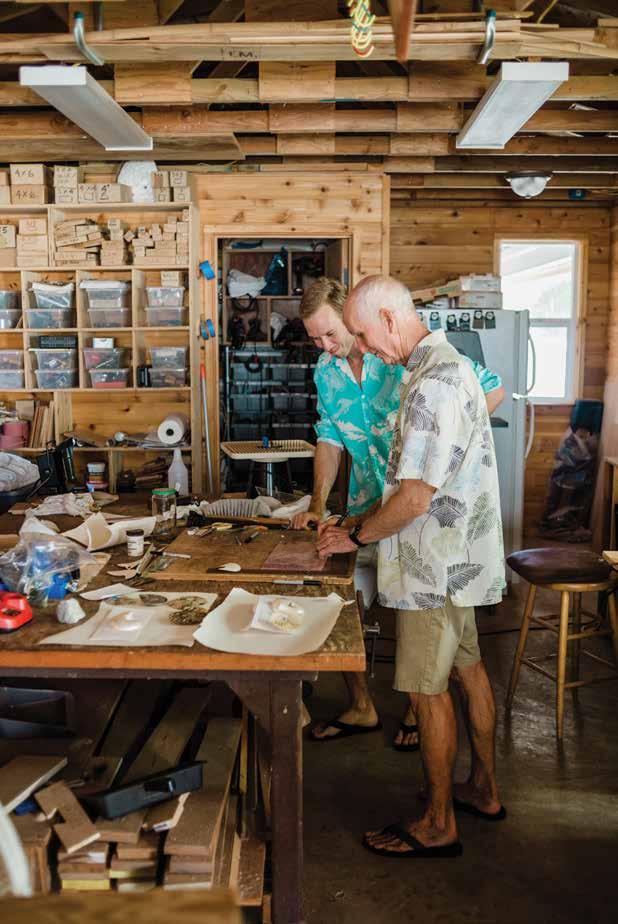

그림, 사진, 음악에서, 세 아들과 아빠들은
그들 일의 몸 뒤에서 영감을 논한다. 바다
주변에 형성된 그들의가족간의 유대감은 이
부모들과 아이들을 하나로 묶는다.
THE COLES
Tall and lithe, artist Peter Shepard Cole cuts a striking figure against the backdrop of Rocky Point, a prime surf break along O‘ahu’s North Shore. Ducking into the cozy, makeshift art studio attached to the beachfront redwood house where he grew up, he rifles through a painter’s miscellany: blank canvases propped up against dusty storage bins, tapered brushes gathered neatly atop a strip of cardboard, an assortment of glass paint jars.
A piece in progress rests on an easel. It’s a seascape, the latest in Cole’s body of work paying homage to a prescient presence in his life: the ocean. On the canvas, shifting tones of turquoise rise along the face of a cresting wave, their hues backlit by a midday sun. A triangle of cerulean sky peeks out from behind. The water looks exuberant and playful, capricious and preternaturally real. Some of Cole’s more turbulent seascapes look so true to life, viewers can “feel the sea,” he says. He grins sheepishly, recounting how one of his clients, though she was ecstatic with her commissioned seascape, confessed it made her seasick.
The ocean has long held sway over Cole. His father, Peter Cole, who also paints, arrived on O‘ahu in the 1950s as part of the big-wave surfing vanguard. There, the young Cole spent is childhood along the “Seven Mile Miracle,” the stretch of coast considered surfing’s mecca. The ocean was his playground. Later, as an adult, it became something more: artistic inspiration.
コール親子
オアフ島ノースショア屈指のサーフポイント 「ロッキーポイント」を背に立つすらりとし た長身のアーティスト、ピーター・シェパー ド・コールさんの姿は印象的だ。ビーチフロ ントに立つセコイア材の家。自分が育ったこ の家に造りつけた急ごしらえだが心地良い アートスタジオの中、雑多な画材に囲まれ、 コールさんは制作に取り組む。埃をかぶった 収納箱の上に立てかけた白いキャンバス。ボ ール紙を敷いた上にきちんと並ぶ、先細りの 絵筆たち。色とりどりのガラス瓶。
制作中の作品はイーゼルに立てられて いる。それは海景だった。コールさんの最新 作品群は、彼の人生が始まる前からそこに あった存在、つまり海に捧げられている。キ ャンバスの上には、真昼の太陽の光を背後 から受けてさまざまなトーンに移り変わるタ ーコイズ色が波の面に輝き、波の後ろの三 角のすきまには澄み切った青空が見える。 水は生命力に満ち、気まぐれに遊んでいるよ うで、信じられないほどリアルだ。コールさ んの描くもっと荒々しい海景も真に迫るもの で、見る人が「海を感じる」ことができるとコ ールさんは言う。注文した絵の出来上がり に大満足しながらも、見ていると船酔いする と打ち明けた顧客もいるのだと、はにかんだ 笑顔で教えてくれた。
コールさんにとって、海は常に圧倒的 な存在だった。父のピーター・コールさんも 画家で、1950年代にビッグウェーブ・サーフ ィンの先駆者の一人としてオアフ島にやって きた。幼いコールさんは、「奇跡の7マイル」と 呼ばれるノースショアのサーフィンのメッカ で子ども時代を過ごした。海は彼の遊び場 だった。大人になると、海はそれ以上のもの、 つまり芸術的なインスピレーションを与えて くれる存在になっていった。
PALM 36 A ARTS Creative Kinships
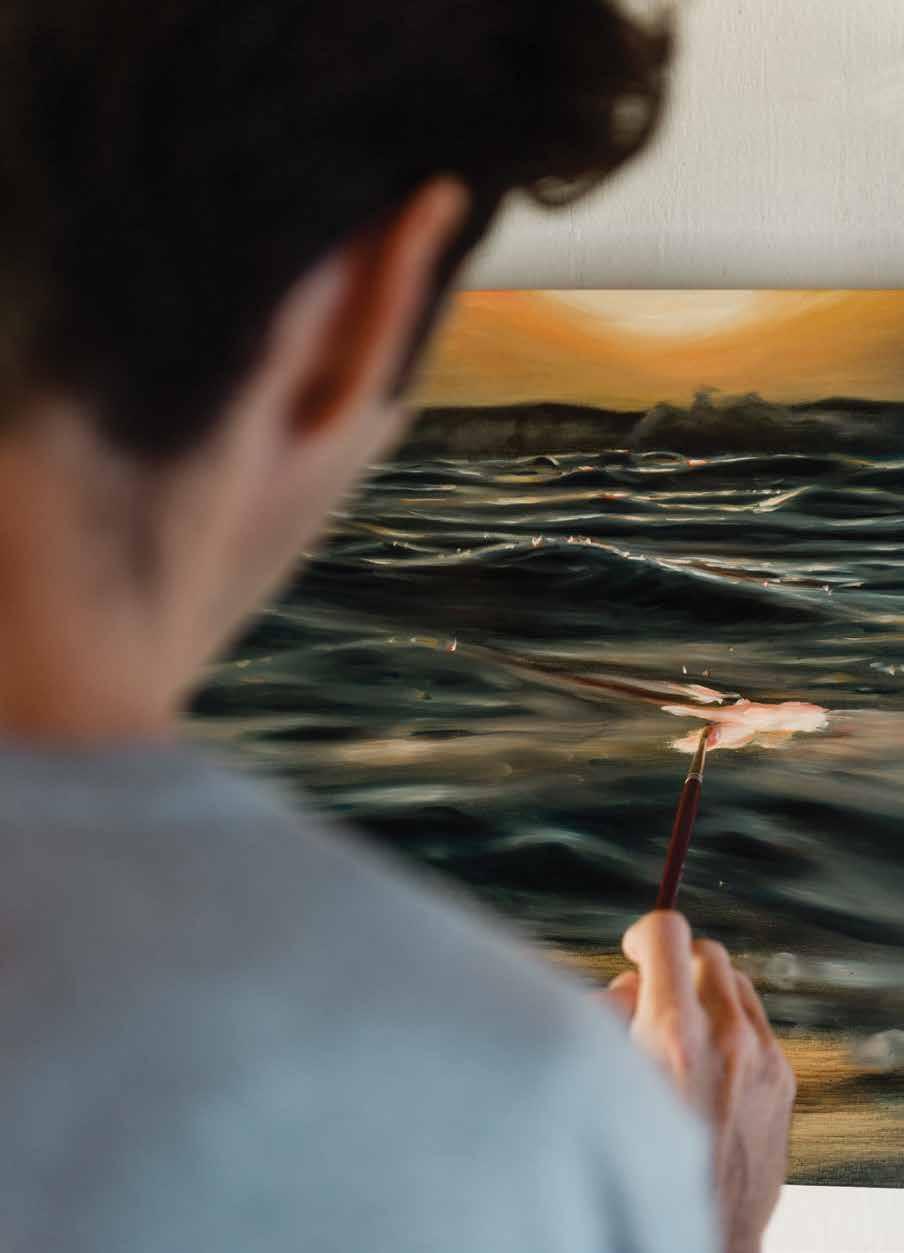

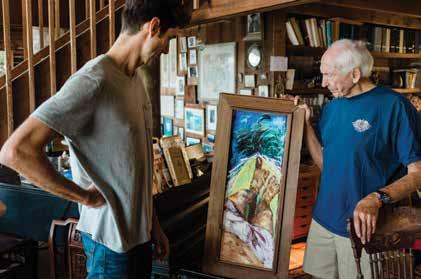
The Coles share a passion for painting and both draw inspiration from the North Shore’s vibrant coastline.
But depictions of idealized, balmy tropical waters hold little appeal for the younger Cole. They are inaccurate, too trite and too flat, he feels. Instead, he challenges himself to capture the true dynamism of the North Shore ocean through movement, mood, and color. It’s a slow, angst-ridden process. He’ll often paint for hours, painstakingly examining each stroke or color. “I wish I could paint like my dad sometimes,” Cole says. “He paints with ease and confidence and speed.”
The elder Cole chuckles at his son’s assessment. “I don’t have the patience to do what he does,” he says.
Inside the Cole family home, the walls are filled with art by both father and son. The subjects and styles are myriad—studies in ocean and harbors, mountains and forests, in oils, acrylics, and watercolors. The elder Cole holds a special fondness for autumnal landscapes, particularly the fiery reds and golds of a New England fall. “Those are the most beautiful scenes in the world,” he says. (His wife, Sally, hails from Connecticut.)
As the pair highlight some of each other’s favorite watermen pieces, their mutual admiration is evident. The younger Cole points to a painting of a surfer inching his way to a noseride and marvels over his father’s ability to capture action and point-of-view perspective. The elder Cole proudly holds out a framed print of a piece that his son painted of him with his quiver of boards. “Look how real that looks,” he says about the painting, shaking his head in amazement.
しかし、コールさん自身は理想化された穏やかな熱帯の海の風 景画にはあまり興味を惹かれなかった。それは本当のノースショアを 正確に伝えていないし、ありふれていて平板すぎると感じたのだ。そ れよりもコールさんは、ノースショアの海が持つ真のダイナミックな 力を、動きとムード、色を通して捉えようと試み始めた。そのプロセ スは遅々として苦悩に満ちている。絵筆のストロークや色の一つ一 つを丹念に確かめながら、何時間も描き続けることもしばしばだ。
「父のように描けたら、と思うこともあるんですよ」とコールさん。「父 はいとも簡単に、自信を持って素早く描くんです」。
父のコールさんは息子のそうした分析を聞いて笑い、「私には こいつみたいな忍耐力がありませんからね」と言う。
コール家の壁には父と息子の作品が所狭しと飾られている。
海と港、山々と森、油彩、アクリル、水彩など、絵の対象もスタイルも 多岐にわたる。父のコールさんは鮮やかな真紅と黄金色に彩られた ニューイングランドの秋の風景をことのほか気に入っている。「世界 で一番美しい景色だと思いますね」(彼の妻、サリーさんはコネチカ ット州の出身だ。)
お互いのお気に入り作品について語るコールさん親子は、互い の才能に抱く敬意を隠そうとしない。息子が、ノーズライドを狙って ボードの前方へじりじりと移動するサーファーを描いた父の作品を 取り上げ、動きを捉える父の手腕と視点のとり方を称賛すれば、父は 自分とサーフボードのコレクションを描いた息子の絵(額に入った印 刷版)を手に頭を振りながら、「どうです、すごくリアルでしょう」と、誇 らしげに語った。
PALM 38 A ARTS Creative Kinships


What began in Chicago in 1978 is now one of the most award-winning steakhouses around. For over 40 years, Morton’s The Steakhouse has been on a mission to provide “The Best Steak… Anywhere.” Focusing on quality, consistency and genuine hospitality, Morton’s seeks to provide not only memorable cuisine, but a memorable experience.
Phone: 808-949-1300
Fax: 808-947-9512
http://www.mortons.com/honolulu/
Blvd.
1450 Ala Moana
Honolulu, HI 96814
THE SMITHS
Even at 10 years old, Hawai‘i-born surf photographer
CJ Smith was all about the barrel. “My whole room was covered ceiling to floor with cut-outs from bodyboarding magazines,” Smith recalls with a sheepish grin. “I’d go out to Sandy’s with a disposable camera and try to get that perfect shot.” Two decades later, his barrel fever still runs high, though Smith has long since upgraded his Insta-matic to a Sony A9.
Most mornings find Smith at the beach during “golden hour,” that brief, dreamy window of time near dawn that photographers prize for its soft light. While Smith enjoys capturing images from shore, it’s actually being in the ocean where he excels. The pursuit of the perfect barrel requires a healthy vigilance of one’s surroundings, Smith explains. Shifting currents, incoming swells, and dangerous shore break can make or break a shot. Luckily for him, being in the water feels natural. A former standout water polo player for University of California Los Angeles, Smith puts to use the thousands of hours he spent swimming, sprinting, and honing his eggbeater kick—that infamous, legburning move water polo players master to keep vertically afloat.
“Being a water polo player has definitely helped,” Smith says. “You gotta swim out as fast as you can, otherwise you get slammed on the head, not just by the wave, but your camera, too.” He winces and smiles while rubbing his head in memory of a lesson learned.
According to Smith’s father, Ken, his son’s prowess in the water isn’t the only reason for his success as an athlete or professional surf photographer. It’s also his dedication to the craft. Ken should know, since he was CJ’s water polo coach growing up. “CJ put a lot of time and effort into the sport,” Ken says. “It paid off.”
A retired teacher and former UCLA water polo player himself, Ken is a beloved figure in the state’s water polo scene, having had a significant role in producing Hawai‘i water polo talent. His coaching advice to others, whether artist or athlete? “Stick with it,” he says. “Perseverance and determination will lead to talent.”
Ken extends that concept of persistence to his own creative endeavors in woodworking and stained glass. In his small workshop behind the family’s Mānoa home, he rummages through a dusty drawer and pulls
スミス親子
ハワイ生まれのサーフフォトグラファー、CJ.スミスさんは、10歳にし てバレル(きれいに丸く巻いた波)の魅力に取りつかれていたという。 「僕の部屋は天井から床まで、ボディーボードの雑誌からの切り抜 きで埋まっていました」と、はにかみながらスミスさんは語る。「使い 捨てカメラを持ってサンディービーチに行っては、完璧なショットを 撮ろうとしてたんです」。それから20年。カメラは使い捨てからソニ ーa9に変わったが、バレルへの情熱は変わらない。
ほとんど毎朝、スミスさんは「ゴールデンアワー」にビーチに通 う。夜明け前のほんの短い間、夢見るような柔らかな光に世界が包 まれるフォトグラファー垂涎の時間だ。陸から海を撮るのも好きだ が、スミスさんが本領を発揮するのは海の中からのショット。完璧な バレルを撮影するには、しっかりと周りに目を配ることが必須、とスミ スさんは説明する。潮の流れの変化、向かってくるうねり、危険なシ ョアブレイクなどの要素が撮影の成否を決めることもある。幸い、ス ミスさんにとって水の中にいるのはとても自然なことだった。カリフ ォルニア大学ロサンゼルス校(UCLA)のウォーターポロ選手として 活躍したスミスさんは、何千時間もの練習でつちかった、水泳、競泳、 そして「エッグビーターキック」と呼ばれる、脚が疲れることで有名な ポロ競技用の立ち泳ぎのスキルを充分に活用している。
「ウォーターポロをやっていたことは、間違いなく役に立って ます。出来るだけ速く泳げないと、波にたたきつけられるだけじゃな くて、カメラに頭をぶつけちゃうこともありますからね」とスミスさん。
過去の苦い経験を思い出して、スミスさんは頭をこすり、顔をしかめ て笑った。スミスさんの父、ケンさんは、選手として、またプロフォトグ ラファーとしての息子の成功は、優れた身体能力だけではなく、ひた むきな努力のたまものだという。ケンさんがそれを知るのも当然。な にしろウォーターポロのコーチとして息子を見守ってきたのだから。 「長い時間をかけて重ねた努力が実を結んだのです」とケンさん。元 教師のケンさん自身、かつてUCLAのウォーターポロ選手だった。ハ ワイの選手育成に大きく貢献してきたケンさんは、ウォーターポロ界 で広く愛される存在だ。アーティストにせよ、スポーツ選手にせよ、 コーチとしてのアドバイスは、「とにかく続けること。不屈の努力と決 意が才能につながるんです」と語る。
ケンさんは、その不屈の努力を木工とステンドグラス制作とい う創造的な仕事にも傾けている。マノアの自宅の裏手にある小さな
40 A ARTS Creative Kinships PALM



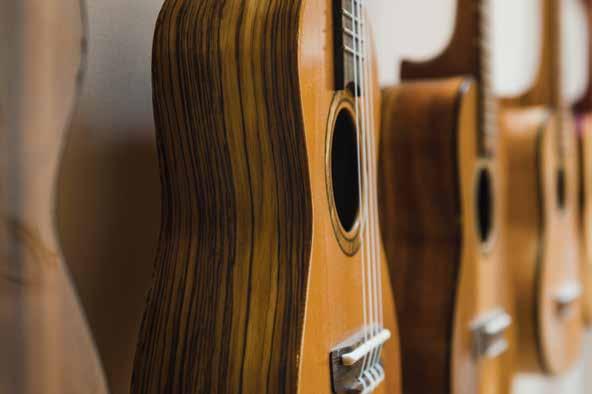
Whether its woodworking, stained glass, or photography, an eye for precision is key for each of the Smiths’ practices.
out an oblong, palm-sized blob of glass edged with lead. It’s a piece of stained glass, albeit rudimentary.
“Can you tell what this is?” Ken asks his son. CJ looks perplexed. “It’s a strawberry,” Ken says. “The first piece I ever did!” Father and son both laugh. Mere steps away in the house is more evidence of Ken’s artistic talent: a series of gorgeously crafted ‘ukulele, richly hued wooden treasure boxes inlaid with glass and seashells, and an intricate floral stained-glass trellis over the front door.
As Ken points out a few of his latest projects, a look of quiet pride flickers across his face, and it’s mirrored in his son’s face. “Anybody can do it,” Ken says humbly. “We might not do it as well as someone else at first, but we all can do it.”
作業場で、ケンさんは埃だらけの引き出しか ら鉛の縁取りがある手のひらサイズの丸い ガラスの板を引っ張りだした。ごく初歩的な ステンドグラスの習作だ。
「これが何だか分かるかい?」ケンさ んが尋ねると、息子は困った顔をした。「イチ ゴだよ。一番最初に作ったやつさ!」とケンさ ん。父と子はどちらも笑いだした。家の中に はケンさんの芸術的才能を示す作品がずら りと並んでいる。素晴らしい細工が施された ウクレレ、豊かな色の木材にガラスと貝を象 嵌した宝石箱、玄関の扉の上に設置された 緻密な花の模様のステンドグラス。
いくつかの最新作を紹介するケンさん の表情には静かな誇りが見て取れる。息子 のスミスさんの顔にも同じ表情が浮かんで いた。「誰にでも出来るんだよ」と、ケンさん は控えめに語る。「最初は人よりうまくいか ないかもしれない。でも、どんな人にだって 出来るんだ」。
42 A ARTS Creative Kinships PALM

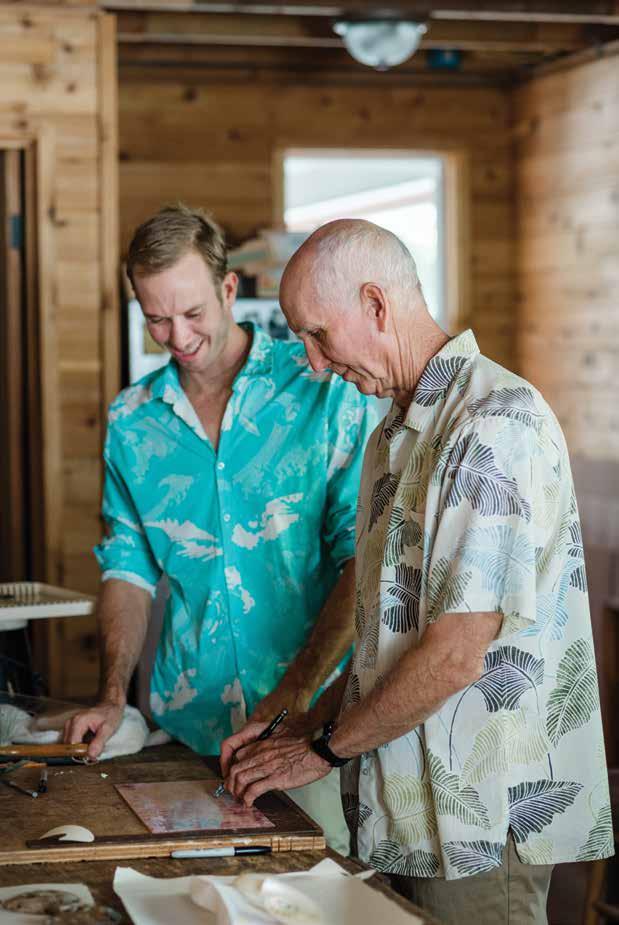
THE MIZUNOS
“Music is a powerful enhancer,” says Hawai‘i surfer Noa Mizuno, who for the past year has been honing his skills not only in the water but also in the sound room and DJ booth. A recent collaboration on a short surf film with Japanese record producer Shingo Annen required Mizuno, already a music aficionado, to become a quick study in musical scoring. Learning to lay tracks to his own surf footage proved an intense but wholly gratifying experience for the 20-year-old. It also illuminated a path away from the restrictions on selfexpression that corporate-sponsored professional surfers often face. “I don’t want to be defined as just as surfer,” Mizuno says. “What I do is different from who I am.”
A love for music, like his love for surfing, is a vibrant leitmotif of Mizuno’s life. Many of his childhood memories are gilded with sound: scribbling in his journal as a fourth grader listening to Kayne West; riding in the car to Waikīkī surf contests with his father, Jake, a retail entrepreneur, blasting AC/DC on the stereo; standing in the French seaside town Hossegor mesmerized by live music spilling from outdoor cafes. Years later, as a young adult, it was in Hossegor that Noa found himself moved anew by the revelatory effect of music. He took the experience as a sign to integrate music even more thoroughly into his life.
Fortunately for Noa and his father, their work provides platforms for their passions. As Noa finds ways to intertwine music and surfing, so too does Jake strike a balance between the corporate and collectiveminded aims of his retail shops Milo and Stoke House, both of which are in Kaka‘ako. Jake was drawn to that area, an urban mix of commercial, retail, and residential use, for its palpable, creative energy. “It’s a community with purpose,” Jake says. “The place has grown organically.” Noa believes the keystone of his father’s success is not only his business acumen but also his ability to build sincere relationships. “My dad is the most genuine person I know,” Noa says. “I admire how he wants to create a community and wants to bring everyone with him.”
When asked what kind of traits he and his father share, Noa pauses, then laughs a few moments later, having realized that he might have more in common with his father than he first suspected. They’re both drawn to culture and arts. They’re both stubborn and sometimes hard on themselves. But creative minds think alike, too. “His brain is always working, he’ll never retire,” Noa says. “Me, I always want to be pursuing something.”
ミズノ親子
「音楽には、力を高めるパワーがあります」と語るのは、サーファーで あり、最近は水の中だけでなくサウンドルームやDJブースでの腕も磨 いているノア・ミズノさん。音楽ファンだったノアさんは、日本のレコ ードプロデューサー安念真吾との短編ショートフィルムでのコラボレ ーションをきっかけに、楽曲の基礎をたちまち吸収した。20歳のノア さんにとって、自分のサーフィン映像に曲をつけていく方法を学ぶの は、困難だが満足感が得られる経験だった。そしてそれは企業スポン サーを得たプロサーファーがしばしば直面する自己表現の規制から 踏み出す道を照らしてもくれた。「サーファーというくくりだけで見られ たくないんです。僕がやってることと、僕自身とは別のものだから」。
音楽への愛はサーフィンへの愛と同様に、ノアさんの生活にエネルギ ーを注ぐテーマだ。子ども時代の思い出の多くは音楽に彩られてい る。小4の時に宿題をしながら聞いたカニエ・ウエスト。父のジェイク さんと一緒にワイキキでのサーフコンテストに向かう途中、大音量で 聞いたAC/DC。そして、フランスのオスゴール海岸で屋外のカフェか ら流れてきた、心奪われるライブ音楽。ノアさんはそのオスゴールで 天啓を与えるような音楽の効果に心打たれ、人生に音楽をもっと全 面的に取り込んでいくべきだと感じた。幸い、ノアさんと父ジェイクさ んの仕事にはその情熱を形にするための土台が備わっていた。ノア さんが音楽とサーフィンを結びあわせる方法を探っていたとき、ジェ イクさんも、企業という形態と、カカアコにある彼の店「ミロ」と「スト ーク・ハウス」が目指す共同体的なマインドとのバランスを見つけて いた。カカアコ地区のクリエイティブなエネルギーに惹きつけられ たジェイクさんは、そこは「目的を持ったコミュニティで、有機的に 成長している場所」だと語る。ノアさんは、父の成功の要はビジネス の才覚だけではなく、人との間に誠実な関係を結ぶ力だと考えてい る。「父は、僕が知る中でいちばん真摯な人です。コミュニティを作 ってみんなを引っぱって行きたいという父に敬服します」。
親子で共通する特徴を尋ねると、ノアさんは少し考えてから笑って、 実は多くの共通点があるのに気づいたと語る。二人とも文化とアー トに惹かれ、頑固で、時には自分に厳しい。クリエイティブな二人は 考え方も似ている。「父の頭はいつも回転してるんです。きっと引退 することはないでしょう。僕も、いつも何かを追求していたいです」。
44 A ARTS Creative Kinships PALM


 Jake and Noa Mizuno thrive on the creative energy found throughout Kaka‘ako, home to their hip retail surf shops Milo and Stoke House.
Jake and Noa Mizuno thrive on the creative energy found throughout Kaka‘ako, home to their hip retail surf shops Milo and Stoke House.
A sense
CUL TU RE
of place that
C PALM 文化
fosters the human spirit
PALM C 47
Where Sky Meets Stone
Text by Christine Hitt 文 = クリスティン·ヒット
Images by Michelle Mishina 写真 = ミシェル·ミーシナ


48 C CULTURE Kūkaniloko PALM
星と岩から学ぶ古代の教え
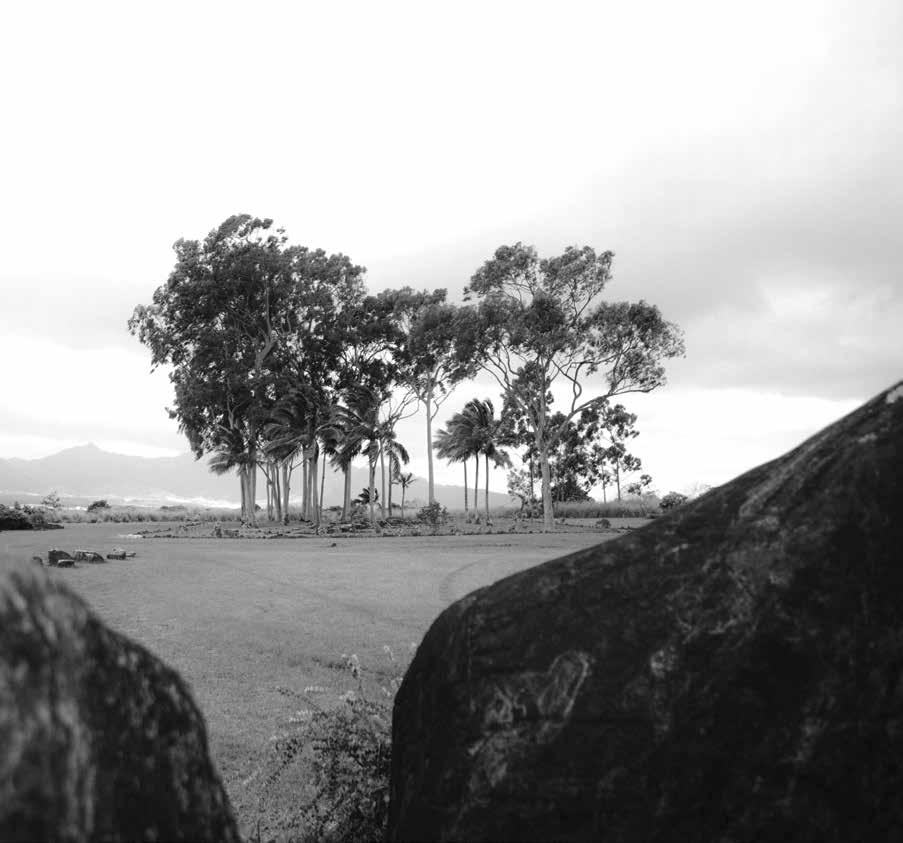
It is well known that celestial bodies play important roles in Hawaiian culture as confirmations of seasonal shifts and guides to farming, fishing, and sailing. A site on O‘ahu further illuminates the depths and complexities this traditional knowledge encompasses. ネイティブハワイアンの文化では、季節の移り変わりと農耕や漁の時期を示す目印と しても、遠く離れた陸地への航海の道しるべとしても、天体が重要な役割を果たして います。オアフ島の真ん中に、この深く複雑な知識を物語る遺跡があります。

One afternoon centuries ago, a star rose with the sun and created a sharp shadow, like a dagger, across a stone during the birth of a child. The rarity and significance of the celestial event was not lost on the many ali‘i (chiefs) and kāhuna (priests) present, who determined the child was henceforth destined to be the greatest chief of his or her generation. People across the island could hear the beating of the sacred pahu (drums) announcing the birth at Kūkaniloko, where O‘ahu’s great ali‘i were born for generations.
하와이의 첫 정착민들이 어떻게 토지 요소 와 천체 사이의 정렬을 이해했는지에 대한 지 식은 개발 연구의 한부분이다. 쿠카닐로코와 같은 특정한 섬 지역은 이 연구의 단계를 풍 요롭게 했다.
何世紀も昔のある午後、一人の赤ん坊がこの世に生まれ出でようとしていた時 に、一つの星が太陽とともに空に昇り、地面に横たわる岩の上に鋭い短剣のよ うなくっきりとした影を落としました。居合わせた大勢のアリイ(貴族)やカフ ナ(神官)たちは、この天文事象の珍しさと重大さを見逃さず、その子どもが将 来、その時代の同最も偉大な酋長となる運命にあると考えました。未来の大 酋長の誕生を告げる聖なるパフ(太鼓)が打ち鳴らされる音は、オアフ島一円 の住民の耳に届きました。その場所はクカニロコと呼ばれ、何世紀もの間オア フ島の偉大なアリイたちの誕生の地として選ばれてきました。
50 C CULTURE Kūkaniloko
PALM


Thomas Lenchanko, pictured previous, is a kahu (caretaker) and lineal descendant of the area.
The mission of the Hawaiian Civic Club of Wahiawā is “e kūka awe i nā kapu o Kūkaniloko no ka mea aloha nō ho i kākou iā lākou i nā kau a kau (to guard the kapu of Kūkaniloko because we love them for all time).”
Royal births at Kūkaniloko began in the 12th century, when it was believed to have been constructed for the birth of Kapawa, chief of Waialua. The last chiefly birth there was in the mid-1600s with the birth of Kākuhihewa, the 15th ruling chief of O‘ahu. Now a state monument, Kūkaniloko attracts only the occasional visitor and caretakers on the serene grassy plateau of Wahiawā where it lies between the Wai‘anae and Ko‘olau mountain ranges. In total, it is made up of 180 stones—some with petroglyphs, another scored with deep grooves, and still others with manmade basins carved into their surfaces. To this day, it remains an important Hawaiian cultural site.
Unbeknownst to many, however, is that Kūkaniloko was more than a royal birth site. It was also a place of learning for kāhuna, lua (martial art) practitioners, and kilo (astrologers), among others. Since Hawaiian culture is holistic in nature, there was no singular function of Kūkaniloko.
“Kūkaniloko taught navigation, it taught astronomy, it probably also taught ‘ōlelo (language) and the use of Hawaiian orality and its poetics, its way of naming things,” says author and researcher Martha Noyes, who holds a professional degree in cultural astronomy and studied Kūkaniloko for more than 12 years. “If you taught astronomy, then you’re teaching the sky, and if you’re teaching the sky, you’re teaching weather. Birth is associated with, of course, Mother Earth, but it’s also associated with the stars and with the plants that make birth more comfortable. Those plants may, not all of them, be associated with stars which are associated with deities. You can’t separate botany from medicine from astronomy.”
クカニロコで王族が出産する慣習が始まっ たのは12世紀で、最初はワイアルアの酋長である カパワの出生のために建設されたと考えられてい ます。最後にこの場所で生まれた酋長は15代目 のオアフ島大酋長カクヒヘヴァだったといわれてお り、時は17世紀中頃でした。現在ではハワイ州歴 史文化財のひとつに指定されているクカニロコは、 ワイアナエ山脈とコオラウ山脈に挟まれたワヒア ワ台地の静かな草原にあり、時折観光客や管理人 が訪れるほかは、あまりひと気がありません。遺跡 は合わせて180個の岩からなり、表面にペトログリ フ(絵文字)が刻まれた岩もあれば、深い溝が刻ま れたもの、人の手で彫られたたらい状の窪みがあ るものもあります。ここは今なおハワイの文化にと って重要な意味を持つ場所であり続けています。
しかし、クカニロコに王族の出産のほかにも 用途があったことを知る人は多くありません。ここ はカフナ、ルア(武術)の使い手、キロ(占星術師)な ど、さまざまな役割を担う人たちにとっての学びの 場でもありました。ネイティブハワイアンの文化は もともとあらゆるものを総合的に考えるホリスティ ックな性格を持つため、クカニロコの用途も一つに 限られたものではなかったのです。
クカニロコについて12年以上にわたり研究 を続けている著述家で文化天文学の修士号を持 つ研究者でもあるマーサ・ノイエスさんは、「クカニ ロコは、航海術と天文学の教習所であり、おそらく は、オレロ(言葉)やハワイの口頭伝承と詩の用法、 命名法を教授した場所でもあったと思われます」と 話します。「天文学を教えることは空について教え ることであり、空について教えることは気象につい て教えることでもあります。人の誕生は当然のごと く母なる地球と結びつけられ、星々や、そして安産 を助けてくれる植物とも関連づけられています。そ うした植物は、全部ではないにせよ、神々と結びつ
PALM 52 C CULTURE Kūkaniloko









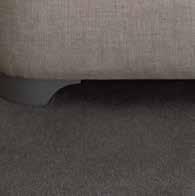


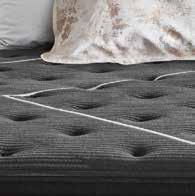




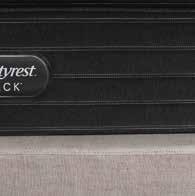


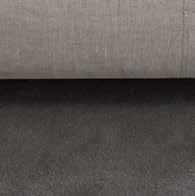



Beautyrest‰ Black‰ pairs the most advance sleep technology with luxurious Micro Diamond™ Memory Foam to bring you deeper, restorative sleep. Locations in Honolulu, Ward, Salt Lake, Pearlridge, Kapolei, Hilo, Kona, and Maui. slumberworldhawaii.com



Jo-Lin Lenchanko Kalimapau is the historian and treasurer of the Hawaiian Civic Club of Wahiawā.
Noyes has found Kūkaniloko to be like an encyclopedia of Hawaiian knowledge that can only be deciphered by connecting stones, markers, or objects on land to the sky. This is the very definition of archaeoastronomy, a subclassification of cultural astronomy, which requires archaeology, or physical objects, to be in the presence of astronomy. Many heiau (traditional temples of worship) and other historic sites across the Hawaiian Islands, including Kahikinui on Maui and upright stones on the top of Maunakea on Hawai‘i Island, have some unknown meaning associated with the stars.
Before Noyes began her research at Kūkaniloko, she asked friends of hers who were lineal descendants to the area if there was interest in learning more about the astronomy related to the site. It was already known that the equinoxes and solstices aligned with various stones at Kūkaniloko as well as with geological features, such as points on the two mountain ranges. It was also traditional knowledge that Kūkaniloko is the piko (the navel or center) of O‘ahu, geographically and culturally. “It’s a place of uniting relationships,” Noyes says. “It’s a place of mediation, where left meets right, north meets south—they meet at the center and the center is equilibrium. That’s why it’s a place of learning. It’s one of the reasons Kūkaniloko has an association with high ali‘i and high kāhuna, because the higher knowledges were restricted to the higher chiefs and kāhuna.”
When the equinox sun sets over Mount Ka‘ala in the Wai‘anae range, it aligns with the birthstone at Kūkaniloko, where mothers gave birth. The lineal descendants told Noyes that every stone had a meaning, though what they meant was not remembered, and shared
けられた星と関連づけられているかもしれません。 植物学は医学と切り離せず、医学は天文学と切り 離せないのです」。
ノイエスさんは、クカニロコが、地上にある 岩、目印または物体を空と結びつけることによって 初めて解き明かすことができる、ネイティブハワイ アンの知識が集積された百科事典のような場所で あることに気づいたと言います。これは文化天文 学の下位分類である「天文考古学」の定義そのも のであり、この学問では遺物や物体を天文学と合 わせて考察する必要があります。マウイ島のカヒキ ヌイや、ハワイ島のマウナケア山頂に立てられた岩 など、ハワイ諸島各地に存在するヘイアウ(古代の 祭祀場)やその他の史跡の多くには、現代人が知ら ない、星と結びつけられた意味があるそうです。
ノイエスさんは、クカニロコでの研究に着手 する前に、この地域に住んでいたネイティブハワイ アンの直系の子孫である友人たちに、この史跡に 関係する天文学に興味があるかどうか尋ねまし た。春分、秋分、夏至、冬至の太陽の位置が、クカ ニロコにあるさまざまな岩や、そこから見える2つ の山脈の峰々などの目立つ地形と一直線上に並ぶ ことはすでに知られていました。また、クカニロコ がオアフ島の地理的·文化的なピコ(「へそ」または 「中心」)であることも古くから知られていました。 「ここはさまざまな関係を統合する場所であり、 仲介の場でもあります。左が右と、北が南と合わさ る…つまり、合わさる場所は中心であり、中心とは 均衡点です。クカニロコが学びの場とされたのは そのためです。高度な知識の担い手が地位の高い アリイやカフナに限られていたことが、クカニロコ が地位の高いアリイやカフナに関連づけられてい る理由の一つです」とノイエスさんは説明します。 春分と秋分の太陽がワイアナエ山脈のカア ラ山の向こうに沈む時、その上で何人もの母親た ちが出産したといわれているクカニロコの「バース ストーン」と一直線上に並びます。ノイエスさんは、 直系の子孫たちから、それぞれの岩に意味がある
PALM 56 C CULTURE Kūkaniloko


HEMA
‘ĀKAU
KOMOHANA HIKINA

Martha Noyes, pictured opposite, has been studying the cultural astronomy at Kūkaniloko for more than 12 years.
the story of a birth when a star cast a dagger-like shadow. Which rock and where the shadow fell was still known. Using astronomy software, Noyes figured out it was the star Regulus. “It made sense,” she says, “because it’s a king maker,” referring to other cultures which also connect the star with kingship.
Over the years of visiting and studying the site, she discovered a treasure trove of information. In tracking the rising and setting of the sun and stars at Kūkaniloko, landscape markers around the island were named where these celestial events touch points on the land from the viewpoint of Kūkaniloko. This intentionally connects the sun and star rises and sets to the geography of the island. In that way, not only are the sun and stars centered at
が、その意味は忘れられていることと、星が短剣の ような影を岩の上に落とした時に誕生した酋長の 話を聞きました。それがどの岩でどこにその影が 落ちたのかも伝わっていたので、ノイエスさんは天 文学のソフトウェアを使って、その星が獅子座のレ グルスであることを突き止めたそうです。「納得しま した。王の星として知られている星ですからね」。
他にもこの星を王位と結びつけている文化の例を 挙げて、ノイエスさんは説明しました。
ノイエスさんは、何年にもわたってこの史跡 を訪れて研究するうちに、この場所が情報の宝庫 であることを発見したそうです。太陽と星々の出没 地点がクカニロコを中心点として把握されていた だけでなく(これは世界のどこでも起こり得る現象 ですが)オアフ島各地の目立つ地形の場所が、クカ ニロコから見たときにこうした天文現象が陸地に 接する地点から名付けられていることもわかりまし
58 C CULTURE Kūkaniloko PALM


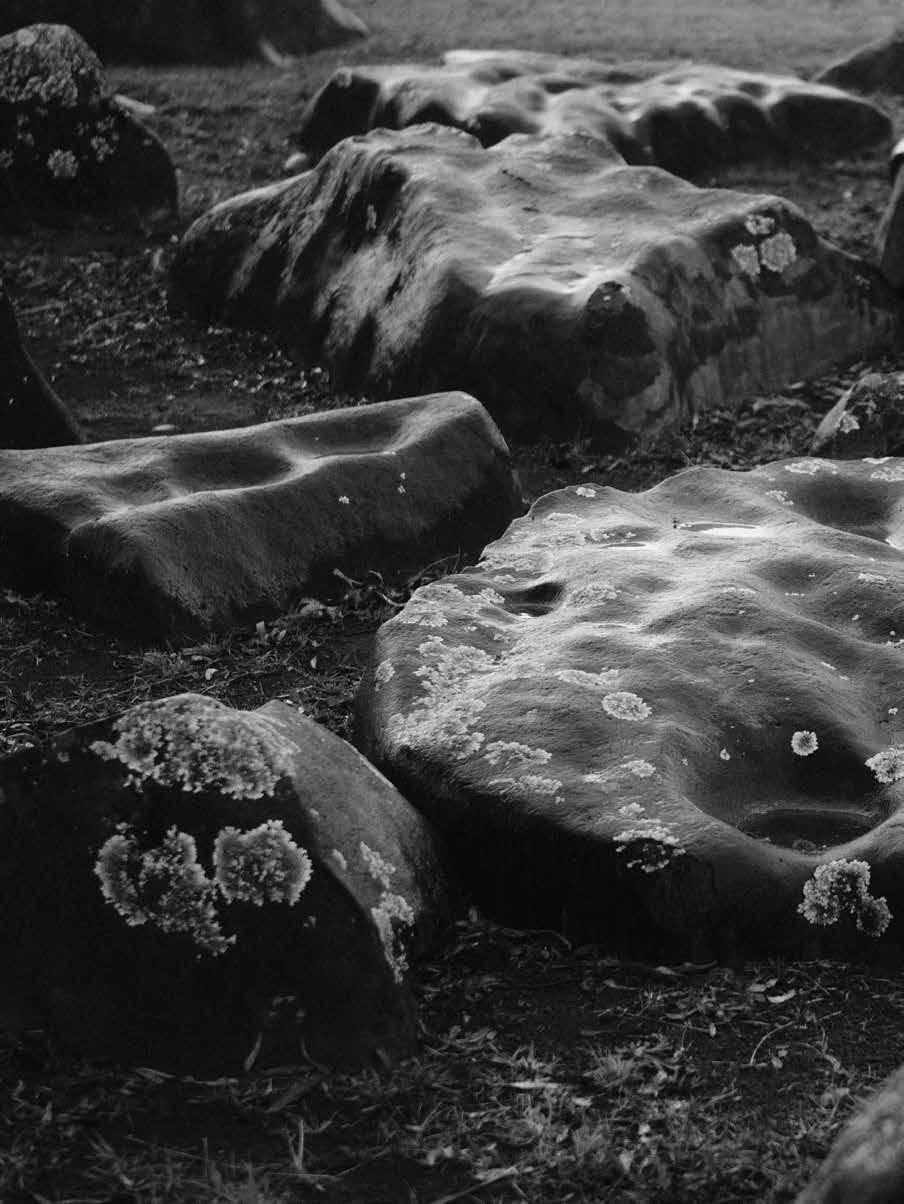


Kūkaniloko was named for the sacred stones near Wahiawā, and also the name of an ancient chief.
Kūkaniloko, but the geography is centered as well, enforcing the concept of it being the piko.
Furthermore, Hawaiians were so knowledgeable of the cycle of the stars that they named places they couldn’t see from Kūkaniloko, like those on the other side of the Ko‘olau or Wai‘anae ranges, based on the rising and setting of stars. Today, this aspect of astronomical knowledge is called celestial mechanics.
Noyes says she has been continually amazed by the depth and breadth of knowledge Hawaiians had of the sky, stars, and celestial motions, from her early days studying the site all the way to now, in her retirement. The stars’ metaphysical relationships are even intertwined with Hawaiian religion and philosophy. Through its alignments with the landscape of O‘ahu, Kūkaniloko perpetuates its importance to Hawaiian culture—and there’s still much more to learn from it.
た。つまり、太陽と星々の出没を島の地形と意図的 に結びつけてあるのです。そうすることによって、ク カニロコを中心点として太陽と星々の位置を把握 しているだけでなく、地形もクカニロコを中心点と して位置づけることで、この地が「ピコ」であるとい う概念をいっそう強めているのだそうです。 さらに、古代のハワイアンたちは、コオラウ山 脈やワイアナエ山脈の反対側にある地点などのク カニロコから見えない場所にも名前をつけるほど、 星の運動周期に精通していたそうです。これは現 在の天文学で天体力学と呼ばれる学問分野です。
ノイエスさんは、クカニロコ研究を始めた当初から 引退生活を送る現在までずっと、空と星と天体の 運動に関する古代ハワイアンの知識の深さと広さ に驚かされ続けてきたと言います。星たちの形而 上学的関係は古代ハワイアンの宗教と哲学にも密 接に結びついています。クカニロコは、オアフ島の 地形との位置づけにより、ハワイ文化にとって重要 な史跡であり続けています。この場所から学べる ことは、まだたくさん残っているのです。
62 C CULTURE Kūkaniloko PALM



AUG 7–SEP 1 BLAISDELL CENTER To place an order, or more information on season and group tickets, visit broadwayinhawaii.com
Quentin Oliver Lee as ‘The Phantom’ and Eva Tavares as ‘Christine Daaé’ in
The Phantom of the Opera. Photo: Matthew Murphy
Mana Wāhine
力あるワヒネ
Text by Noelani Goodyear-Ka‘ōpua
文 = ノエラニ・グッドイヤー=カオプア
Images by Ed Greevy and Franco Salmoiraghi and courtesy of the Ritte ‘ohana
写真 = エド・グリーヴィ、フランコ・サルモイラギ、およびリッテ家提供
The women in Nā Wāhine Koa, a look at history’s overlooked aloha ‘āina advocates, shares the journeys behind their boldest and most courageous actions.
『ナ·ワヒネ·コア』は、これまであまり顧みられてこなかった勇気あるハワイの女性活動家たちの軌跡を記 録するノンフィクション。コミュニティのための大胆なアクションからもっとも個人的な内省の瞬間まで、そ の旅路をたどる多彩な物語は、土地への深い愛を描き出しています。
CULTURE Nā Wāhine Koa 64 C
PALM
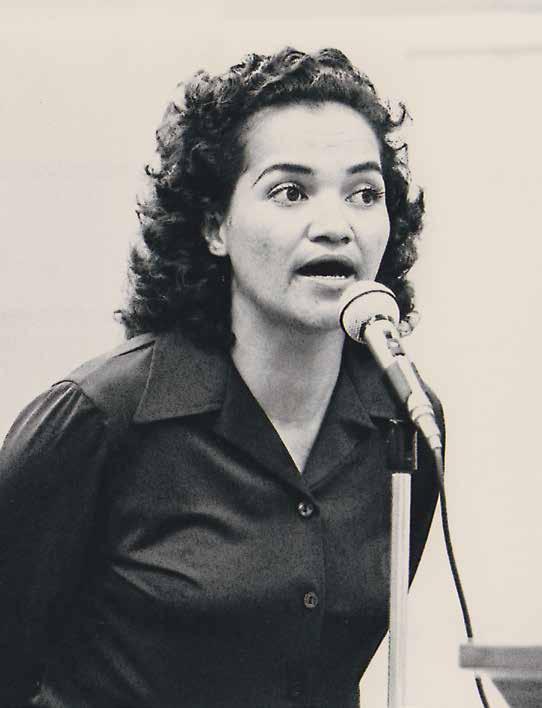 Maxine Kahaulelio, circa 1981.
Maxine Kahaulelio, circa 1981.
나 와힌 코아라는 책에 기록된 하와이 여성들은 그 들의 용기 있는 공동체의 지지와 행동으로 알 려져 있다. 작가 겸 편집자인 노엘라니 Goodyear-Ka'opua는 어떻게 그녀가 이 매력적인 이야 기들을 수집했는지에 대해이야기한다.
On January 13, 1976, Loretta Ritte kissed her two daughters and signed temporary power of attorney to her mother-in-law. “It was a good day to die,” she says. Loretta and three others were heading out to protect the sacred Hawaiian island of Kaho‘olawe, which the U.S. Navy had been using as a live-fire target since World War II. They aimed to stop the military’s weapons testing and training by placing their bodies between the earth and the bombs the military planned to detonate on it. The group described their actions as aloha ‘āina, love of the land.
1976年1月13日。ロレッタ・リッテさんは2人の娘 たちにキスをし、義理の母に署名済みの仮委任状 を手渡した。「死ぬには良い日だったわ」と、ロレッ タさんは振り返る。ロレッタさんを含む4人はその 日、ハワイの聖なる島であり、第二次大戦以降ずっ と米国海軍の実弾演習場となっていたカホオラヴ ェ島を守るために出かけたのだ。ロレッタさんたち は軍事演習や訓練を停止させるため、島の大地と、 軍がそこに落とそうとしていた爆弾との間にみずか らの身体を置くつもりでいた。彼らはその行動を 「アロハ・アイナ」つまり土地への愛だと説明した。
Loretta Ritte, her husband, Walter, and children, circa 1979.

Loretta left her home on Moloka‘i by boat with her husband, Walter, her sister-in-law, Scarlett, and their friend Emmett Aluli. They slipped onto Kaho‘olawe at dusk and laid low until the morning. Then they hiked to the top of the island. “It was just shattered rocks and red, open wounds,” Loretta writes in Nā Wāhine Koa: Hawaiian Women for Sovereignty and Demilitarization, published in 2018. “It was all bare at the top. And yet it was really beautiful too. We were able to see Maui and Lāna‘i, and there was a calming effect, because we had nothing else. Everything else was stripped away. It was just you and her. You and her, and everything that came with her.”
Loretta Ritte is one of many women who emerged as activists for aloha ‘āina in Hawai‘i in the 1970s. Yet far too often, their stories have gone untold and unrecognized. We sought to remedy this gap in popular memory with Nā Wāhine Koa , a book I edited featuring stories
ロレッタさんはモロカイ島の自宅を出て、夫 のウォルターさん、義理の妹のスカーレットさん、 そして友人のエメット・アルリさんとともにボート に乗り込み、夜明け前に密かにカホオラヴェ島に 上陸し、朝まで目につかないよう身を潜めた後で 島の最高地点へと徒歩で登っていった。「そこは砕 かれた岩だけが散らばる、赤いむき出しの傷口だ った」と、ロレッタさんは2018年に出版された書 籍『NāWāhineKoa:HawaiianWomenfor SovereigntyandDemilitarization(ナ・ワヒネ・ コア:主権と非軍事化を目指したハワイの女性た ち)』で語っている。「頂きには草木一本なかった が、それでも本当に美しかった。マウイ島とラナイ 島を望むことができ、周りに何一つないために、私 たちの心を落ち着かせる効果があった。ほかのす べては剥ぎ取られていた。そこにあるのは、自分と <彼女>だけ。自分と<彼女>、そして<彼女>が もたらすすべてがそこにあった」。
ロレッタ・リッテさんは、1970年代のハワイ でアロハ・アイナのために戦った多くの女性活動家 の一人だ。彼女たちの物語が語られることはあまり にも少なく、その多くは見過ごされてきた。私が編 集にあたり、ロレッタ・リッテさん、モアニケアラ・ア
PALM
66 C CULTURE Nā Wāhine Koa
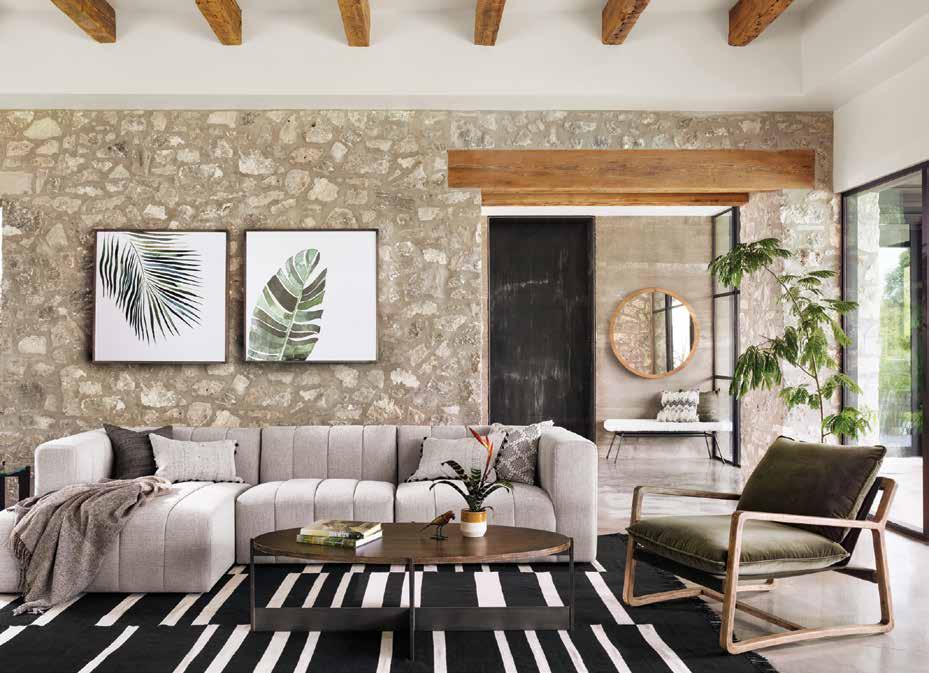
Hawaii’s premier source for interior and outdoor furniture. Exclusive luxury lines and large on-island in-stock inventory. Condominium packages and complimentary design services available.*
*See stores for details. Specialized services and design packages available for residents of: Park Lane, One Ala Moana, Hokua, and Capitol Place.
HONOLULU, O‘AHU
744 Ala Moana Blvd.
808-596-9338
Monday–Saturday: 9a–7p
Sunday: 10a–5p
KAHULUI, MAUI
221 Lalo St.
808-727-8300
Monday–Saturday: 9a–5p
PACIFIC-HOME.COM BUY LOCAL | BUY ECO | BUY BEAUTIFUL LET HOME BE YOUR ESCAPE...

by Loretta Ritte, Moanike‘ala Akaka, Maxine Kahaulelio, and Terrilee Keko‘olani-Raymond.
Maxine Kahaulelio made the fifth landing on Kaho‘olawe with 13 others from O‘ahu in August 1977. At the time, Kahaulelio was a single mother of five working in a public-school cafeteria. She had also organized with local communities fighting eviction by large landowners and with women fighting for the dignity of their families while on welfare. “I will never forget the feeling of walking through the gun shells,” Kahaulelio writes in her chapter of Nā Wāhine Koa. “You could hear them: shack-shack, shackshack. And every time I walk, my tears would fall, because every bullet was like, ‘Wow, can you imagine?’ We could have built beautiful schools. We could have restored beautiful fishponds and given our children food. Real food. Real education. Hospitals. We could break down the prisons and give restoration to our people, our brothers. Instead, millions and millions of dollars just to destroy the land. That’s what I saw on the ground. That’s what I was walking through.”
Nā Wāhine Koa features four Hawaiian women elders who participated in the early Kaho‘olawe movement and spent the better part of the next five decades working for the health and wellbeing of Hawai‘i’s lands and people. Maxine Kahaulelio, Loretta Ritte, Moanike‘ala Akaka, and Terrilee Keko‘olani-Raymond are wāhine koa, courageous women warriors. Each shares her story of coming into activism, of battles won and lost, of sustaining commitments to justice and aloha ‘āina. Between the four of them, they have protected freshwater
カカさん、マキシーン・カハウレリオさん、テリリー・ ケコオラニ=レイモンドさんという4人の女性の物 語を集めた書籍『NāWāhineKoa』は、そうした 空白を埋めようという試みだ。
マキシーン・カハウレリオさんは1977年8月 にオアフ島を出発し、他の13名とともにカホオラヴ ェ島への第5回目の上陸活動を果たした。当時カ ハウレリオさんは5人の子どもを持つシングルマザ ーで、公立校のカフェテリアで働いていた。彼女は そのほかにも、地元コミュニティで大地主による立 ち退き強要に反対する運動や、生活保護を受けな がらも家族の尊厳を保とうと戦う女性たちの運動 を率いた。「散らばった砲弾と薬莢の間を歩いた時 の感覚は今でも忘れられない」と、カハウレリオさ んは『NāWāhineKoa』の彼女の章で語っている。 「シャクシャクシャク、という音が耳に響いた。歩く たびに涙が流れた。砲弾の一つひとつを見るたび に、ああ、何ということだろう、と思わされたからだ。 素敵な学校を建てることもできたのに。美しいフィ ッシュポンド(ハワイの伝統的な養殖池)を再生し て、子どもたちに食糧をあげることだってできたの に。真の食糧を。真の教育を。病院を。刑務所を 取り壊して、同胞や兄弟たちに尊厳を取り戻しても らうこともできたのに。その代わりに何百万ドルも のお金が、この土地を破壊するためだけに注ぎ込 まれて来たのだ。それが、その大地に私が見たも のだった。その上を私は歩いていたのだ」。
『NāWāhineKoa』で紹介した4人のハワ イアン女性は、カホオラヴェ島での運動に参加した 後、半世紀にわたってハワイの土地と人びとの健康 と幸福のために尽力してきた。マキシーン・カハウレ リオさん、ロレッタ・リッテさん、モアニケアラ・アカ カさん、そしてテリリー・ケコオラニ=レイモンドさ んはいずれも「ワヒネ・コア」、勇気ある女性戦士た ちだ。4人の女性たちはそれぞれ、活動家となった きっかけ、勝利と敗北、そして正義とアロハ・アイナ
PALM 68 C CULTURE Nā Wāhine Koa
Terrilee Keko‘olani-Raymond, circa 1975.
 Moanike‘ala Akaka and artist Tomas Belsky in Hilo, 1976.
Moanike‘ala Akaka and artist Tomas Belsky in Hilo, 1976.
supplies, Hawaiian burial sites, pristine rainforests, traditional fishing access trails, and more. They have resisted the use of toxic pesticides and weapons on Hawaiian lands, the construction of telescopes on sacred summits, and the eviction of mutiethnic communities by wealthy developers. They have asserted the importance of Hawaiian independence, demilitarization, and nuclear-free zones in Hawai‘i and the Pacific. Each has offered visions of peaceful and sustainable ways of living that honor the self-determination of Hawaiians and the humanity of diverse but oppressed peoples in the islands.
When we began the process of co-creating this book, these four fierce aunties welcomed me into their circles of memory. At their kitchen tables, on lānai, in restaurants and grocery stores, at coffee shops and bars, they poured out oceans of love for ‘āina, for extended families, for people who struggle. They shared stories over suitcases filled with water-damaged photos in Ziploc bags. They entrusted me with folders full of newspaper clippings and event flyers. They shared memories and analyses over food flavored with laughter, heartache, hope, and kuleana. When Haunani-Kay Trask wrote of “fine baskets of resilience to carry our daughters in,” she must have known this kind of love. These four wāhine koa are not the only women to have fought such battles or led Hawaiian movements for justice. Rather they exemplify the powerful and diverse roles that Hawaiian women have played in ongoing expressions of aloha ‘āina.
When I asked Aunty Loretta why she continues to be active in her community on Moloka‘i, she talked about freedom, “the kine freedom when everyone takes care of each other, when everyone takes care of the ‘āina.” In the book, Loretta writes about experiencing an intensified version of this freedom when she and her family, along with four other couples, moved to the uninhabited northern valley of Pelekunu on Moloka‘i, where they lived off-grid for almost two years in the late 1970s.
のために戦い続ける決意について語っている。その活動を通して彼女たちは、 水資源、ハワイアンの埋葬地、原生の熱帯雨林、伝統的漁業のためのアクセス 路などを守ってきた。ハワイにおける有害な殺虫剤の使用や劣化ウラン弾の 使用、ハワイアンにとって聖なる山の頂きへの望遠鏡建設、裕福な開発業者に よる多民族コミュニティの立ち退き強要などにも抵抗してきた。さらにハワイ と太平洋地域でのハワイ民族の独立、非軍事化、非核地帯化の重要性も訴え 続けている。4人はそれぞれに、ハワイアンの自決権、そして多様だけれども抑 圧されているハワイの人々の人間性を尊重する、平和でサステイナブルな社会 のあり方を提示している。
私たちが共同執筆のプロセスを開始した時、この4人の恐るべき「アン ティー(おばさん)」たちは、私を暖かく迎え入れ、思い出話を分かち合ってく れた。キッチンのテーブルやラナイで、レストランや食料品店で、コーヒーショ ップやバーで、4人は「アイナ(土地・大地)」と親戚も含めた自分たちの大きな 家族、そして苦しんでいる人々への海のような愛情を惜しみなく語った。水に 濡れて傷んだ写真を入れたジップロックの袋がいっぱいに詰まったいくつも のスーツケースを開いてたくさんの話を聞かせてくれ、新聞の切り抜きやイベ ントのチラシをぎっしり挟んだフォルダーを託してくれた。思い出と洞察を分 かち合ってくれた彼女たちの食卓は、笑い、心の痛み、希望、そしてクレアナ( 責任)で彩られていた。『我が娘たちを運ぶ、美しくしなやかなバスケット』を書 いたハウナニ=ケイ・トラスクさんは、きっとこのような種類の愛情を知ってい たのに違いない。正義を求めるハワイアンの運動を率いた女性は、ここで紹 介した4人のワヒネ・コアだけではない。この4人は、今も続くアロハ・アイナの 運動のなかでハワイアン女性たちが果たしてきた、パワフルで多彩な役割の 見本というべき存在なのだ。
ロレッタさんにモロカイ島で今も活動を続けている理由を尋ねると、彼 女は自由について語ってくれた。それは「誰もが互いをいたわり、誰もがアイ ナをいたわる、そういう自由」だという。ロレッタさんは本の中で、そういった 自由をさらに強烈な形で体験した時のことを語っている。1970年代後半、 彼女の家族がほかの4組のカップルとともにモロカイ島北部のペレクヌにあ る無人の谷で2年間ほど、電気もない生活を送った時のことだ。
70 C CULTURE Nā Wāhine Koa
PALM
 Moanike‘ala Akaka, Honolulu, 1972.
Moanike‘ala Akaka, Honolulu, 1972.

Terrilee Keko‘olani-Raymond at Sandy Beach, O‘ahu, circa 1972.
One week, when she was alone with the kids in the valley, a huge storm engulfed them from sky and sea. Massive waves rolled into the beach. She and her children ran to the back of the valley. The heavens poured down heavy rains, thunder, and lightning. Roaring waterfalls lined the cliffs. And yet, Loretta felt empowered to protect her kids and survive the storm. “I don’t think I was ever afraid, because the valley was like a womb. A mama. A teacher. A protector,” she writes. “It was a good place, if you listened. It could be a bad place, if you nevah.”
Noelani Goodyear-Kaōpua is the author of Na Wāhine Koa: Hawaiian Women for Sovereignty and Demilitarization, published by University of Hawai’i Press. She’s an associate professor of political science at the University of Hawai’i at Mānoa.
その谷にロレッタさんと子どもたちしかいな かった時に空と海から大嵐がやってきて、まる1週 間吹き荒れたことがあった。巨大な波が浜辺に押 し寄せ、ロレッタさんと子どもたちは走って谷の奥 へと逃げた。天が裂けるような激しい雨が降り注 ぎ、雷が鳴り、稲妻が光った。崖には滝がいくつも 現れ、咆哮を上げた。その中でもロレッタさんは力 を感じ、子どもたちを守り、嵐を生き延びることが できたという。「一度も怖いとは感じなかったと思 う。なぜなら、その谷は子宮のようだったから。谷 は母であり、先生であり、守護者だった」とロレッタ さんは書いている。「耳を傾けている限り、谷は善 き場所だった。でも耳を傾けないなら、それは悪し き場所にもなるのだ」
ノエラニ・グッドイヤー=カオプアさんはハワイ大学 マノア校の政治学准教授。共著書『NāWāhine Koa』はハワイ大学出版局より発行。
72 C CULTURE Nā Wāhine Koa PALM
 Loretta and her three children in Pelekunu, Moloka‘i, circa 1979.
Loretta and her three children in Pelekunu, Moloka‘i, circa 1979.
DE SI GN
D デザイン flourishing
The of
creative
facilities
PALM D PALM
75

All Keyed Up
A vintage Hermes 3000 typewriter.
Text by Diane Ako 文 = ダイアン・エイコ
Images by John Hook 写真 = ジョン・フック

76 D DESIGN Typewriters PALM
タイプライターの復権
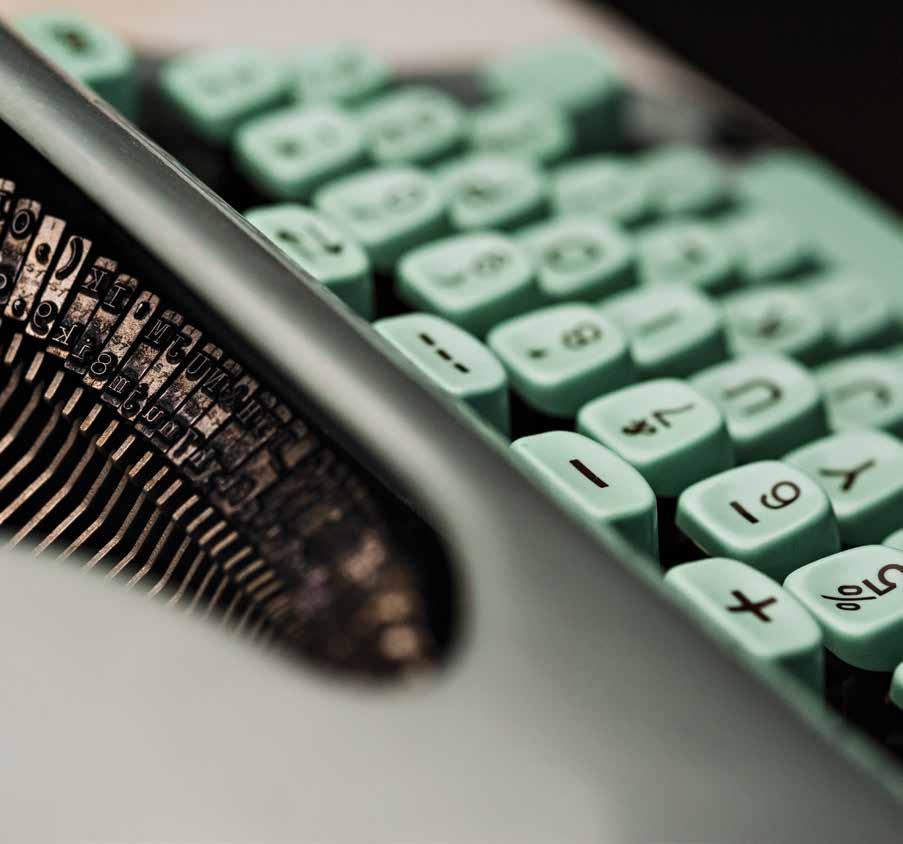
From the classic to the curious, the collection of a local reveals why there is growing appreciation for the anachronism that is the vintage typewriter.
クラシックなビンテージ・タイプライターを愛する人が増え ています。ハワイ在住の愛好家のコレクションを通して、そ の魅力を探りました。
고전부터 호기심까지, 한 지방의 수집품들
은 왜 빈티지 타자기인 시대착오에 대한 인식
이 커지고 있는지를드러낸다.

Compared to computers, typewriters are not efficient writing tools, but what they do offer is a welcome break from the high-speed digital age. The film California Typewriter , a documentary of celebrities who expound their loyalty to this machine, suggests as much. Featured in it is author Richard Polt’s “The Typewriter Manifesto,” which asserts: “We choose the real over representation, the physical over the digital, the durable over the unsustainable, the self-sufficient over the efficient.”
When Joshua Wisch, executive director of American Civil Liberties Union of Hawai‘i, saw the film and the famous typewriter aficionados it profiled, he was inspired to build his own collection. His personal inventory of vintage typewriters now numbers 12, which he keeps at his Kailua home. On a Sunday morning, he excitedly shows them off to me.
タイプライターはコンピュータほど効率的なツールとはいえないが、目まぐる しいデジタル時代の中でほっとひと息つかせてくれる存在だ。セレブリティた ちがタイプライターへの尽きせぬ愛を語るドキュメンタリー映画『California Typewriter(カリフォルニア・タイプライター)』は、その特質を良く描いてい る。映画の中で紹介されている哲学者リチャード・ポルトの文章「タイプライタ ー・マニフェスト」は、こう宣言する。「我々は表象よりもリアルを、デジタルより も身体性を、持続可能性よりも耐久性を、効率性よりも自足性を選ぶのだ」。
アメリカ人権協会ハワイ支部のエグゼクティブディレクター、ジョシュ・ ウィッシュさんはこの映画に登場するタイプライター愛好家たちに感化され て、自分でも蒐集してみる気になったという。現在までにウィッシュさんがカイ ルアの自宅に集めたビンテージのタイプライターは全部で12台。ある日曜日 の朝、その自慢のコレクションを見せてもらった。ウィッシュさんはそのうちの 1台を使って、『カリフォルニア・タイプライター』出演者の一人であるトム・ハン
78 D DESIGN Typewriters
PALM

He used one of them to write to actor Tom Hanks, who is featured in California Typewriter , to ask for a recommendation for a beginner’s typewriter. Unsure if he’d get an answer, Wisch went ahead and purchased a coal-black Royal Quiet De Luxe.
He sets it on the table. It’s a practical-looking machine that appeared on the market in the late 1930s. We feed paper into the carriage so I can test it. Its metal body has a sturdy quality, and its round keys are surprisingly resistant. The Royal makes me earn every word I type. I can understand why Ernest Hemingway was drawn to this model for producing his classic, minimalist prose.
Eventually, Wisch tells me, Hanks did respond to his letter, suggesting he buy any Sterling model of Smith-Corona. Hanks also recommended a pre-1960s Hermes (a 2000, 3000, Baby, or Rocket model) and an Ambassador—“if you have desk space,” Hanks wrote. So Wisch kept collecting.
“I bought this beauty in Bremerton, when I was visiting my father-in-law,” he says, pointing to a Hermes 3000. The pretty little device has soft lines, a seafoamgreen body and keys, and a curved silver carriage and return bar. “Look at the brilliant engineering!” he gushes about the typewriter’s design: The bottom of the machine has a lip into which the case neatly clicks and locks. “Also, you can reverse the direction of the ribbon in case you’re running out of ink, and this keyboard includes an exclamation point.” Wisch also marvels over the Hermes 3000’s dual-ink ribbon and molded keys, which fit to one’s fingers. Striking one of these keys has a buttery-smooth feel, with tension soft enough that Wisch’s hands never ache from typing on them.
Then there is his ultra-portable Olympia Splendid 33, which Wisch calls a “performer”—a small package with a big feel. It’s boxy and tan, rather forgettable in aesthetic. But what it lacks in charisma it makes up for with clever design and a workhorse attitude. To keep the machine’s profile low, its German designers made the entire carriage lift up when one hits the shift key. It has a handy snap-on shell, which makes it easy for Wisch to take this typewriter on his frequent work trips. “After the meetings, I have sat in my hotel room and typed over a dozen thank you cards,” he says.
Wisch claims to not have a favorite among his collection, rather choosing which model to use based on his mood. I decide to experience this for myself by writing to Hanks and asking what his favorite
クスに、タイプライター初心者へのおすすめを尋ねる手紙を書いたという。返 事が来るかどうか定かではなかったので、ウィッシュさんはまず石炭のように 黒いボディの「ロイヤル・クワイエット・デラックス」を購入したそうだ。
ウィッシュさんがその1台をテーブルにのせる。1920年代に登場した 実用的な外見のタイプライターだ。キャリッジに紙をセットして、試し打ちさせ てもらった。金属製のボディは重厚で、丸型のキーは驚くほど反発力が強い。 「ロイヤル」でタイプするには、一語ごとにかなりの力を要した。アーネスト・ヘ ミングウェイがあの簡潔な文体で文章を書くのにこのモデルを愛用したという のもわかる気がする。
トム・ハンクスからはしばらく後で返事が来たそうだ。ハンクスは、ス ミス・コロナ社の「スターリング」モデルならどれでもおすすめだといい、また 1960年以前のヘルメス社のモデル(「2000」「3000」「ベビー」「ロケット」)と 同社の「アンバサダー」も、「もしデスクの上にスペースの余裕があるなら」と推 薦してくれたという。そこでウィッシュさんは蒐集を続けた。
「これは、義理の父を訪ねてブレマートンに行った時に買ったんです」 と、ヘルメス社の「3000」を指さしてウィッシュさんは言う。小ぶりのマシンで、 ボディとキーは海の泡のようなグリーン。キャリッジリターンレバーはシルバー で曲線を描いている。「実に見事な技術でしょう!」と、ウィッシュさんは熱弁を ふるってそのデザインを讃えた。マシンの底部には、ケースにぴったりはまるよ うに縁取りがされている。「それに、インクがなくなった時にはリボンを反対向 きにして使うこともできるし、感嘆符のキーもついているんですよ」。「3000」モ デルのダブルリボン機構と指にフィットするように成形されたキーもウィッシ ュさんのお気に入りだ。このモデルのキーはとてもなめらかで、タッチが柔らか いのでタイプしていても手が痛くなることはないという。
一方、ウィッシュさんが「実力派」と呼ぶオリンピア社の「スプレンディド 33」モデルは持ち運びやすい小型サイズだが、どっしりした存在感がある。角 ばったかたちで、色はベージュ。外見はとくに魅惑的とはいえず、スター性はな いものの、優れたデザインとばりばりと仕事をこなす頼もしさがそれを補って いる。このモデルを設計したドイツのデザイナーたちは、ボディを低く保つた め、シフトキーを打つとキャリッジがそっくり持ち上がるように設計した。簡単 に取りはずしできるケースもついているので、このタイプライターは出張にも気 軽に持って行けるそうだ。「会議の後、ホテルの部屋でお礼状を1ダースくらい タイプすることもあります」とウィッシュさん。
コレクションの中で一番のお気に入りというのは特になく、そのときの気 分でどれを使うか決めるという。私もタイピングを体験してみようと、トム・ハ ンクス宛てに、お気に入りのタイプライターは何かと尋ねる手紙をタイプして みることにした。スミス・コロナ社の「サイレント」モデルに小さめのカードをセ
80 D DESIGN Typewriters PALM

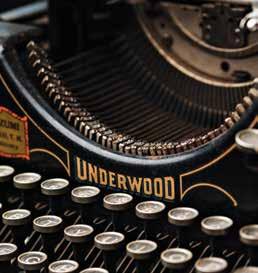
 The standard design of manual typewriters have become more chic and celebrated over time.
The standard design of manual typewriters have become more chic and celebrated over time.



Joshua Wisch, a vintage typewriter enthusiast, at his home.
typewriter is. I slide a notecard into the carriage of the Smith-Corona Silent. With some dismay, I find that I’m frustratingly slow. On a computer, I type 80 words per minute. But on the typewriter, if I type too fast, the typebars tangle, requiring me to gently flick them back into place. If I make a mistake, there is no correction ribbon, so have to I backspace and physically type an X over the error. I forgot to hit Shift, so I get an “8” instead of an apostrophe, causing “it’s” to read like this: “It8s.”
But by the end of the letter, rather than being frustrated, I’m surprised by how much thought I have put into this missive. It dawns on me that collectors who opt to use typewriters are seeking to enjoy the journey of writing rather than the destination. It’s about savoring the tactile sensations: the fingers striking keys, the staccato of typeslugs hitting the platen, the ding of the bell to indicate the end margin.
The designs vary from boxy desktop machines with bulbous metal bodies to sleek, angular plastic portables with pared-down features for travel. The results, however, are consistent. Through this medium, writing becomes a meditative exercise. “It’s slower, yes,” Wisch says, of using any typewriter. “Once I type anything, it’s there on the paper. I can’t take it back. But I like that it makes me think about what I’m going to say.”
ットしてタイプし始めて、自分のタイピング速度のあまりの遅さに呆然とし てしまった。コンピュータを使う時の私のタイピング速度は1分間に80ワ ードだ。でもこのタイプライターでは速く打ちすぎるとバーがからんでしま うので、そのたびにそっと元の位置に戻してやらねばならない。打ち間違っ ても修正テープはないので、一つ戻って間違った文字の上に「X」を打たね ばならない。シフトキーを押すのを忘れて、アポストロフィの代わりに「8」 を打ってしまい、「it’s」となるべきところが「It8s」になってしまった。
でも、この手紙をタイプし終わった時には、イライラする代わりに、そ の中に自分がどれだけの思いを込めたかに驚かされた。タイプライターの 蒐集家たちは、目的地に達することよりもその過程を楽しもうとしているの だ、ということがわかりかけてきた。手に触れる感覚を愉しむこと。指先が キーを打つ感触。ローラーの上をスタッカートで連打する活字。改行位 置を教えてくれるベルの音。
デスクに据えるための角ばった金属製の重厚なマシンから、携帯し やすいように機能を絞ったスマートなプラスチック製のポータブルマシンま でデザインはさまざまだが、その効果は共通している。タイプライターを使 うと、書くことがゆったりとした瞑想のような体験になるのだ。「もちろん、 ペースは遅くなりますよ」とウィッシュさんは語る。「いったんタイプした内 容は紙に印字されて、もうやり直すことができません。でも、自分が言おう としていたことについて考えることができる。そこが気に入っているんです」
84 D DESIGN Typewriters
PALM

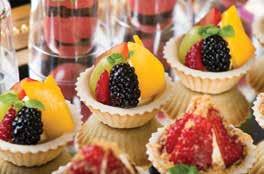

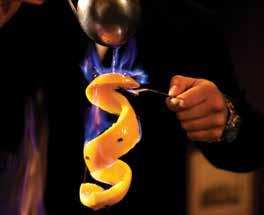
CATERING BY HY’S
A black tie experience, bringing our iconic table side preparation of salads and flambe desserts and our attention to detail to your next special gathering.

A “USDA PRIME BEEF” SPECIALTY HOUSE
A fine-dining tradition in Hawaii for 42 years. Experience the flavorful difference as the only steakhouse in Waikiki to broil over fragrant Hawaiian kiawe wood.
For catering inquiries, email catering@hyshawaii.com.
OPEN DAILY 5PM–10PM 808 922 5555 HYSWAIKIKI.COM 2440 KUHIO AVENUE HONOLULU, HI COMPLIMENTARY FOUR HOUR VALET PARKING
Floating in Space
余白の発見
Text by Natalie Schack
文 = ナタリー・シャック
Images by Skye Yonamine
写真 = スカイ・ヨナミネ
86 D DESIGN Ikebana PALM
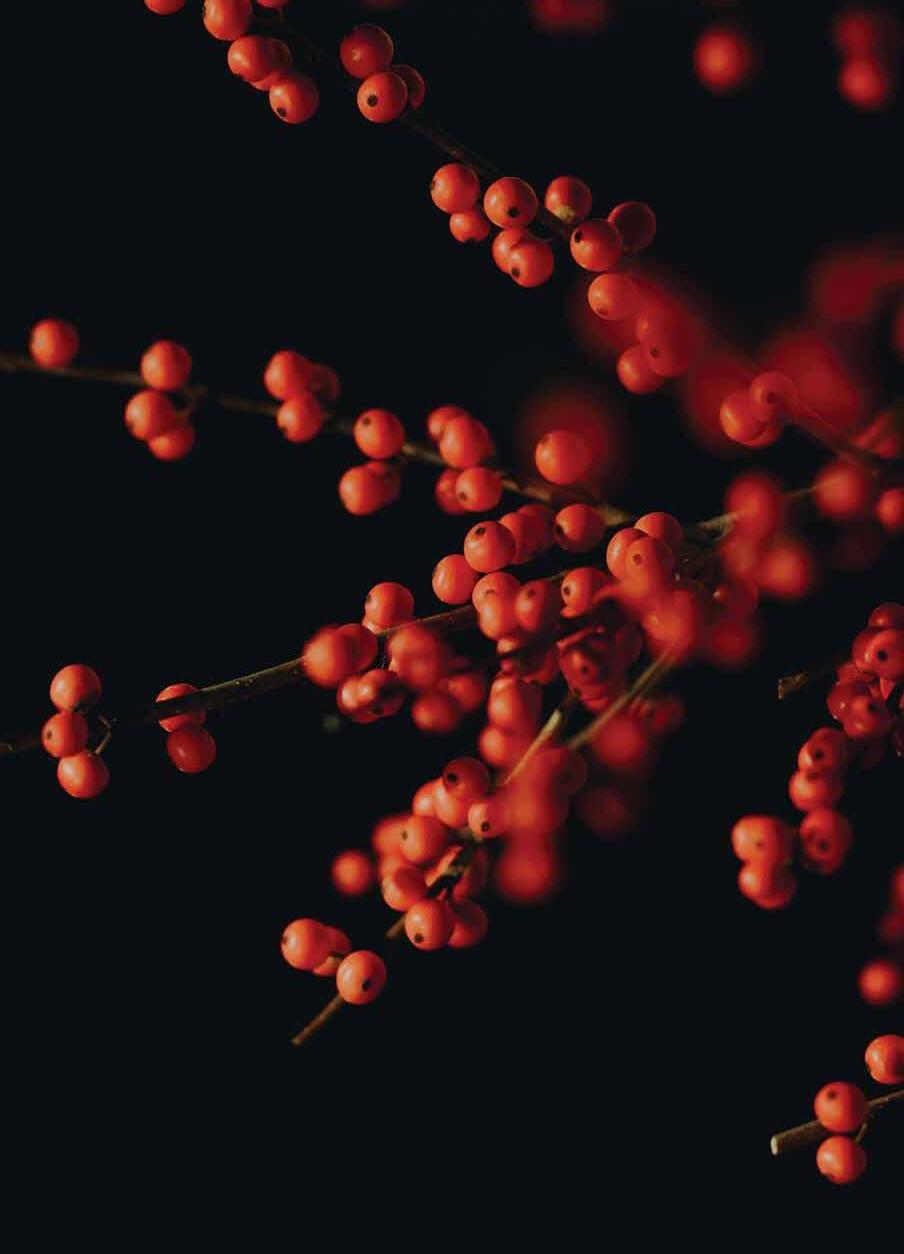

In ikebana, what is there and what is not hold equal importance. Master ikebana artist Carole Sakata has been striking this delicate balance for more than a quarter-century.
いけばなでは、そこに存在するものとしな いものが等しい重みを持ちます。熟練の いけばな作家キャロル・サカタさんは、そ の繊細なバランスを四半世紀にわたって 創り上げてきました。

There’s something unusual on display at Studio Becker. The interior of the showroom of high-end closet and cabinet installations is brightly lit as usual, revealing luxurious textures and gleaming marble. Tonight, however, there’s an added element—or rather, a duality of elements. The first is an array of botanicals, including gently arching branches, bursts of blossoms, undulating fronds, and swirling leaves. It’s an explosion of nature. This nature is set, unexpectedly, alongside the second element: recycled this-and-that including garden tubing, plastic netting, and cardboard egg boxes. The flotsam and jetsam of modern life act as dance partners for the graceful waltz of the floral arrangements.
This is the latest installation from ikebana artist Carole Sakata and her team of students, who create pieces for Studio Becker each year. For this presentation, Sakata decided to do something a little different and incorporate manmade components. The result is an ikebana exhibit that is a far cry from the typical pieces found in high-end hotels or shopping centers.
Sakata hails from the sogetsu school of ikebana, which cherishes such unconventionality. Unlike the staunchly traditional ikenobo, or the garden aesthetics of ohara, sogetsu stands out for its mold-breaking freedom and its departure from preestablished forms. Sogetsu founder Sofu Teshigahara was born in 1900
ハイエンドのクロゼットやキャビネットのショウル ーム、スタジオ・ベッカーには、いつもとは一風変 わったものが飾られていた。贅沢な素材やなめら かな大理石が明るい照明の下に輝いているのは いつも通りだが、今夜はそこに新しい要素が一つ 加わっている。重なった二つの要素、というべきか もしれない。第一の要素は、ひと群れの植物。優 雅に弧を描く枝、咲き誇る花々、ゆるやかにうねる シダ、渦をなす葉。自然の生命力がほとばしるこ の要素のかたわらに、思いがけない第二の要素が 並ぶ。庭用のビニールパイプ、プラスチックのネッ ト、卵の容器。再利用されたさまざまな廃物だ。現 代社会の中に漂う漂泊物とでもいうべき廃物たち が、植物たちとパートナーを組んで優雅なワルツを 踊っている。
これは、毎年スタジオ・ベッカーのために作 品を創っているいけばな作家、キャロル・サカタさ んとその生徒たちによる最新のインスタレーション だ。サカタさんはこの展示でいつもと少し違うこと をしようと決め、人工物を取り入れた。そして出来 上がったいけばな作品は、ハイエンドのホテルやシ ョッピングセンターでよく目にするフラワーアレン ジメントとはまったく趣を異にしたものだった。
サカタさんは、型にとらわれないのびやかさ を尊重する草月流でいけばなを学んだ。伝統に忠 実な池坊や庭の美学を反映する小原流とは異な り、草月流は型破りな自由さと既存の形式からの逸 脱という点で異彩を放つ。草月流の初代家元、勅使 河原蒼風は伝統的な華道家を父に持ち、1900年 に生まれた。「勅使河原蒼風は常に何か違うことを やろうとしましたが、彼の父は『それは駄目だ』と反
광활함과 충만 함의 차이점은 이케 바나 예술가에게 설명 할 수 없습니다. 일본어 Ikebana
34 년간의 연습을 설명합니다. 88 D DESIGN Ikebana
sensei Carole Sakata는
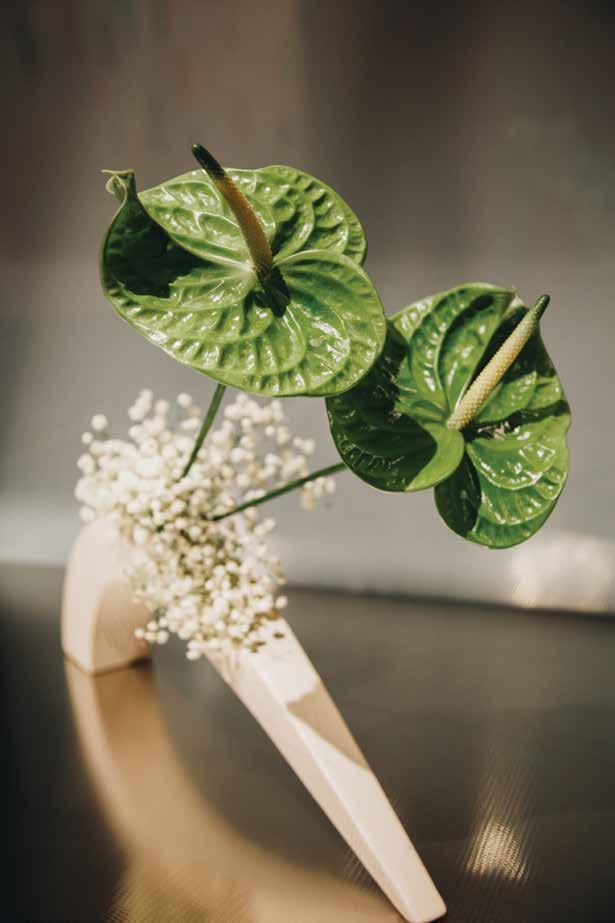

Carole Sakata, an ikebana artist, has been studying sogetsu for more than three decades.
under a father who was a follower of old-school ikebana. “Teshigahara always wanted to do something different. And the father would tell him, ‘No, you can’t,’” Sakata says. “But I think, looking at art, he said: You can do with the paint whatever you want to do with the paint. I’m sure you can do with the flower anything you want to do.”
In the past, sogetsu artists have used whatever was medium was available, whatever medium made sense. With World War II and the ensuing exchange of cultures, the school gained heightened interest. The looseness and freedom for creative expression appealed to foreigners.
It also appealed to Sakata. She traces her interest in the art to the early 1980s, when she moved back to Japan with her husband for his work. She had been born in Japan but had relocated to Hawai‘i at age 13. Back in the country of her birth as a mother of two school-age boys, she needed something to throw herself into.
Today, she walks through the showroom explaining work by her and her master students. She points out the strength of one fixture—“I like to get a very strong feeling,” she says, “not putting lots of things to make it strong, but that one line that
対しました」と、サカタさんは説明する。「しかし蒼風 は言いました。絵画なら絵の具を使って何でも自分 のしたいことが出来る。花を素材にしても、したいこ とが何だってできるはずだ、と」。
草月流の作家たちは、それが作品にとって 意味をなすものであれば何でも、ありとあらゆる 素材を使って制作してきた。第二次大戦後に文 化交流が盛んになると、草月流は一躍注目を集め る。のびやかさと創造的表現の自由が外国人に もアピールしたのだ。
サカタさんもそれに魅了された一人だった。 1980年代初め、サカタさんは夫の転勤で日本に 移り住み、いけばなに興味を持った。サカタさんは 日本で生まれ、13歳の時にハワイに移住した経 歴を持つ。生まれた国に戻り、学齢期の男の子を 2人抱えたサカタさんは、何か夢中になれるもの を必要としていた。
サカタさんはショウルームを歩きながら、自 分と生徒たちの作品について、その力強さやひたむ きさを説明してくれた。「私はとても強い印象を作 るのが好きです。多くのものを足していった強さで はなく、一つの線が持つ強さです」。ある作品の前 では、サカタさんは物理法則を無視してその空間 に花が浮いているかのような浮遊感をその作家が どのように演出しているかを解説した。別の作品 では「無」がいかに重要な役割を果たしているかに
PALM 90 D DESIGN Ikebana



watanabefloral.com | 808.832.9360 | toll free 888.832.9360 Voted Hawai‘i’s Best Florist since 2003

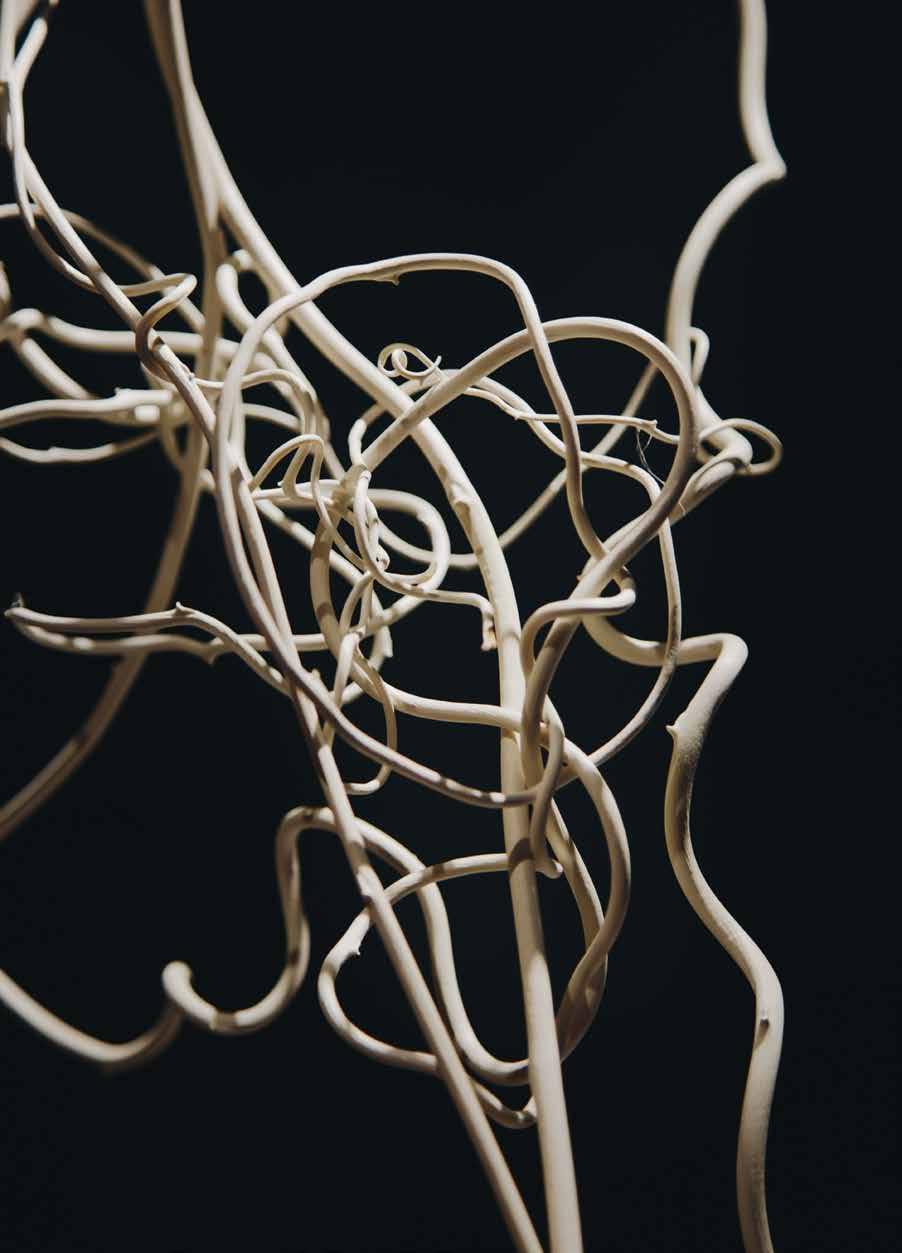
has that strength”—and the forwardness of another. In one arrangement, she explains how the artist achieved the feeling of floating, of a flower hovering in its place, defying the rules of physics. In another, she highlights the essential role played by absence, how the popcorn orchids and the emptiness around them create an interplay of form and negative space.
It has been 34 years since Sakata started studying that balance through the art of ikebana. Today, she is a renowned and respected teacher and practitioner of ikebana in Hawai‘i. Most of her 50 students have been with her for more than a decade, and some of them for two decades. They’re a community now, friends who get together every week to create beauty out of the popcorn orchid, mock orange, or tropical ferns that Sakata amasses from her yard, her neighbors’ yards, and Watanabe Floral.
“Ikebana is a way of life. It’s not something that you start and you finish,” she says. “You will practice once every day, or once every week, or whatever, and it’s with you all your life. That’s how the Japanese look at art.”
注目し、オンシジュームの花とその周りの何もない空間が、フォルムと余白の相 互作用を生み出していると指摘する。
サカタさんがいけばなを通して形と無のバランスを学び始めてから34 年。現在ではいけばなの指導者としても華道家としてもハワイでよく知られ、 尊敬を受けている。50名の生徒の多くは10年以上続けている人ばかりで、中 には20年も続けているベテランもいる。教室は今では小コミュニティに成長 し、親しい人々が毎週集まっては、サカタさんが自宅や隣人の庭から集めたり、 「ワタナベフローラル」から仕入れたオンシジュームやバイカウツギ、または熱 帯のシダといった植物の中から美を紡ぎ出している。
「いけばなは、生き方です。ある時に始めてどこかで完了するというもの ではないのです。毎日、または毎週一度でも、またはいつでも好きなときに活 けていくと、生涯を通していつもいけばなと共にいられます。それが、日本人の 芸術に対する見方なのです」とサカタさんは語った。
94 D DESIGN Ikebana
PALM

How to Enhance an Ikebana Arrangement
いけばなのヒント
by carole sakata
文 = キャロル·サカタ
Here are a few vital elements to consider in order to successfully incorporate ikebana into any living space.
あらゆる住空間にいけばなを上手に取 り入れるために欠かせない要素をいく つかご紹介します。
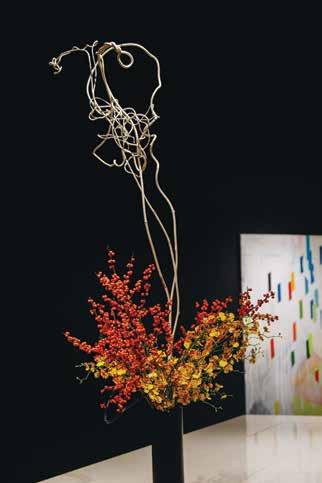
Placement
Ikebana arrangement can be arranged and placed anywhere but it will look better against a wall, especially by the entrance to your home.
Volume
Unlike Western flower arrangement, ikebana uses less plant materials emphasizing every flower and branch. Negative space in an Ikebana arrangement is very important.
Vases
Ikebana can be arranged in various vases such as a flat vase with a frog ( kenzan ) or in a tall vase. When arranging in a flat vase, be sure to feature water as one of the main elements in the arrangement. With a tall vase, materials used should not cover the entire mouth (top) of the container. Use half of its mouth to one side, then the arrangement will look light and airy.
Color
In any art, coordinating colors is important. Using color in contrast or associated color (same tone) will enhance an ikebana arrangement. Ikebana is art, so treat it as art, not as decoration.
飾る場所
いけばなはどんな場所にでも飾ることができます が、壁を背景にするとよく映えます。ことに玄関が おすすめです。
ボリューム
西洋式のフラワーアレンジメントとは違い、いけば なは少ない花材を用いてすべての花や枝を際立た せます。いけばなでは、余白がとても重要です。 器 いけばなはさまざまな器に活けることができます。 剣山を使って平らな器に、または背の高い花瓶に も活けられます。
平らな器を使うときは、水も大切な要素の一つと なるのを覚えておきましょう。背の高い花瓶を使う ときは、花材が器の口を完全にふさがないように 気をつけてください。器の口の片側半分に花材を 収めれば、全体が軽やかになります。
色
どんなアート作品でも、色彩の調和は重要です。
対比色や関連色(同じトーンの色)を選ぶと、いけ ばながより映えます。いけばなはアート。単なる飾 りではなく、芸術品として扱いましょう。
96 D DESIGN Ikebana PALM
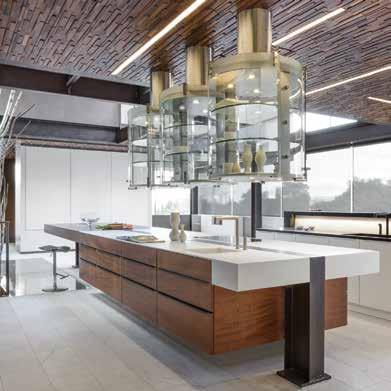


Customize your lifestyle. Kitchens • Media Centers • Wardrobes • Bed and Bath • Libraries • Dining Rooms • Wine Cellars • Custom Furniture StudioBecker Hawaii • 560 N. Nimitz Hwy., Suite 109 • Honolulu, HI 96817 808.949.1700 • info@hi.studiobecker.com • studiobecker.com
Sound & Vision
音楽のビジョン
Text and images by Roger Bong 文/写真 = ロジャー・ボング
98 D DESIGN Album Art PALM

Every great album cover reveals a story beyond the music. Looking at the most iconic records from Hawai‘i’s golden age of music showcases the dreams of their musicians, the skill of its designer, and the hopes of the album’s producer. 優れたアルバムジャケットは、音楽の向こうにある物語を表現します。
ハワイの音楽シーンの黄金期を象徴するレコードたちは、作り手の夢、技 術、そして希望を伝えてくれるのです。

Step into a record shop or antique store and you’ll encounter an artform now 80 years old: the album cover. To spend an hour at Hungry Ear Records or Idea’s Music and Books in Kaka‘ako is to dive into a rich landscape of visual stimuli designed for decades to pique your interest and, ultimately, convince you to buy the music behind the artwork.
Album cover design began with a desire to increase sales. In 1939, Columbia Records’ art director Alex Steinweiss convinced the vice president of sales to let him personally design covers to accompany records. Soon, records with covers sold ninefold better than those without. The industry was changed forever.
하와이의 사운드의 비닐 앨범 아트는 이 섬 의 문화와 개성의 영혼을 상징한다. 각 음 악 앨범은 제작자들의 이야기를 들려주기 위 해 디자인된 재킷을 입고 있다. 1960년대부 터 1980년대까지 섬 음악계가 제공해야 했 던시각자료와 시간을 보내며 디자인 트렌드 의 흥망성쇠에 대해 알아본다.
レコード店、あるいはアンティークの店に一歩足を踏み入れれば、80年の歴史 を持つ芸術ジャンルとの出会いが待っている。そう、アルバムのジャケットだ。 カカアコの「ハングリー・イヤー・レコーズ」や「アイデアズ・ミュージック・アン ド・ブックス」で1時間を費やすということは、つまり、過去何十年かにわたって 人々の興味をそそり、その作品に包まれた音楽を買う気にさせるために作られ てきた視覚的刺激あふれる豊かな景色に身を投じるということなのだ。
アルバムのカバーデザインは、アルバムの売り上げを増やしたいという 思いから生まれた。1939年、コロンビアレコードのアートディレクター、アレッ クス・スタインワイズは、レコードジャケットを自分にデザインさせてくれと営業 副部長を説得した。まもなくカバーデザインのあるレコードはデザインなしのレ コードの9倍を売り上げ、以来レコード業界の常識は変わった。
100 D DESIGN Album Art
PALM

Hawai‘i-based record companies began popping up after the Second World War in tandem with increased tourism to the islands. These new local labels, including Hula Records, Waikiki Records, and 49th State Records, competed with the national labels that had been recording Hawaiian music since the early 20th century, like Columbia and Victor. At first, they pressed music to fragile 10-inch shellac discs that held one song per side. Then, in the 1950s, the introduction of the 12-inch vinyl LP attracted a greater record-buying audience, providing the convenience and affordability of unbreakable discs that held 20 minutes of music per side. Local labels welcomed this era by transforming music they had already recorded into countless albums and then putting on the covers romantic phrases and idyllic images of Hawai‘i. The label 49th State compiled a series of albums titled “Authentic Hawaiian Melodies Recorded In Hawai‘i” and used stock photos like hula dancers entertaining malihini or a lone surfer at Hana Bay for artwork. Album titles like Enchanting Hawaiian Holiday unabashedly marketed to visitors.
This generic formula subsided in the 1960s when artists like Gabby Pahinui and Sonny Chillingworth released albums with down-to-earth images of themselves on the covers. Chillingworth’s first album, Waimea Cowboy, shows the guitarist standing in a forest with the words “Hawaiian Slack-Key.” His 1967 eponymous album used a photo from the same shoot and omitted any text about Hawai‘i. Was it from Hawai‘i? It didn’t matter, at least for the album cover. Finally, musicians and art directors had the creative freedom to design covers rather than adhering to the often restrictive, well-worn marketing approach of attracting listeners by depicting Hawai‘i as an idyllic place of surf, sand, and enchanting sound.
The 1970s saw contemporary groups adopt custombranded insignia and reinvent Hawai‘i’s marketing appeal. The most recognizable logo of the era is that of Kalapana, which features an all-lowercase, rolling typeface reminiscent of the ocean. The band has used it almost exclusively from its 1975 debut to its most recent 2018 Best Of collection. Fabulous Krush’s selftitled album featured aloha-shirted band members jumping above the horizon at sunset. Others wanted not to market Hawai‘i but rather to pay tribute to Hawaiian cultural values or heritage. ‘Āina chose an illustration of
ハワイを拠点とするレコード会社は第二次世界大戦後、観光産業の台 頭と時を同じくして生まれた。「フラ・レコード」「ワイキキ・レコード」「フォーテ ィーナインス・ステイト(49番目の州)・レコード」といったハワイの新レコード 会社が、20世紀初頭からハワイアンミュージックの録音を手がけてきたコロ ンビアやビクターなど全米規模の大手と競い合った。当初作られていたのは 割れやすいシェラック製の10インチSP盤で、片面に一曲ずつしか収録されて いなかった。1950年代に入り、片面20分の楽曲を収録でき、しかも割れにく い12インチのビニール製LP盤が登場すると、その便利さと値段の手頃さから レコードの購買人口が増えた。ハワイのレコード会社は時代の変化に飛びつ き、すでに録音していた楽曲を使って数知れないアルバムを作り、ロマンチック なフレーズとハワイらしくのどかで美しい写真でジャケットを飾った。フォーテ ィーナインス・ステイト社は「ハワイで録音された本物のハワイの調べ」と銘打 ち、観光客を魅了するフラダンサーやハナ・ベイでひとり波に乗るサーファーの 写真などを使ったアルバムシリーズを発売。『魅惑のハワイの休日』などと銘打 ったアルバムを観光客向けに次々に送り出した。
こうした紋切り型の傾向は1960年代に入り、次第におさまっていく。ギ ャビー・パヒヌイやサニー・チリングワースといったアーティストたちが、自分た ちの写真をカバーにした、もっと地に足のついたアルバムをリリースしはじめた のだ。チリングワースの初アルバム『ワイメア・カウボーイ』には、ギタリストで あるチリングワース自身が森の中に立っている写真と「ハワイアン・スラックキ ー」の文字がある。1967年発売のアルバム「ソニー・チリングワース」でも同じ 時に撮影された写真が使われているが、「ハワイ」の文字はない。ハワイ産の 音楽かどうかということは、少なくともアルバムのジャケットに関しては重要で はなくなったのだ。 ミュージシャンやアートディレクターたちはようやく、「ハ ワイといえば波と砂浜、そして魅惑的な音楽が流れるのどかなところ」という使 い古されたマーケティングイメージに縛られることなく、自由な発想でアルバム のジャケットをデザインできるようになった。
1970年代にはコンテンポラリー系のグループがそれぞれ独自のロゴを 用いるようになり、ハワイの魅力を新しい形でアピールした。 この時代でもっ とも目立ったのは、海の波をイメージさせるような丸みのあるフォントで小文 字だけを使った「カラパナ」のロゴだろう。1975年のデビュー時から2018年 のベスト盤まで、カラパナはずっとこのフォントを使っている。ファビュラス・ク ラッシュのアルバムでは、アロハシャツを着たメンバーたちが夕暮れどきの水 平線をバックにジャンプする写真が起用された。ハワイのイメージで売り出す のではなく、ハワイ文化や伝統に寄り添おうとしたアーティストたちもいる。 アイナは天と地との調和の中にいるハワイアン男性のイラストを使用した。
102 D DESIGN Album Art
PALM



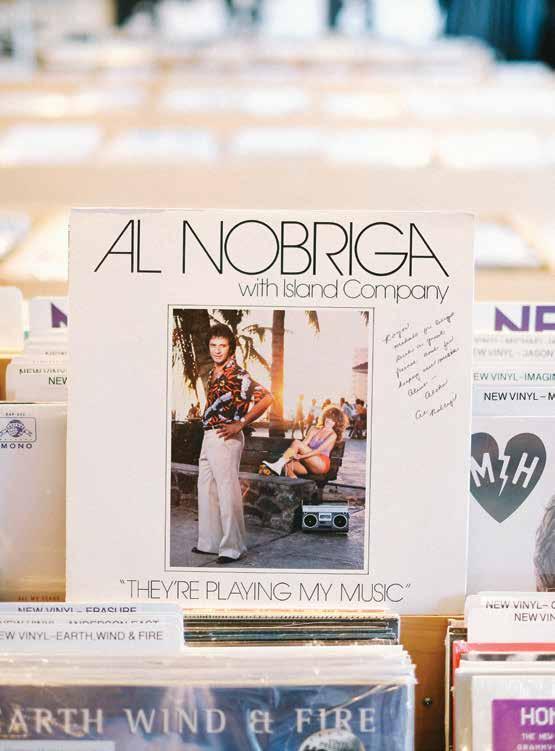

a Hawaiian man existing in harmony with the land and sky. Momi, a Native Hawaiian harpist and singer, posed in a stunning portrait wearing a haku lei.
Many local artists during the 1970s and 1980s made original music not to satisfy Hawai‘i’s visitor economy but to participate in the global music scene where R&B, rock, jazz, disco, and soul music topped charts. The album covers often reflected this, void of any visual cues indicating the music was “Hawaiian.” Kalapana’s lead singer, Mackey Feary, debuted his solo album with a photograph of Honolulu’s city lights. You couldn’t guess the city unless you knew the view. Jazzfusion group Music Magic went wild with a psychedelic illustration of the members (or their spirit animals) jamming in a futuristic landscape. Lil Albert appeared in a soulful, subdued
ネイティブハワイアンのハープ奏者で歌手でもあ るモミは、ハクレイ(花冠)をつけた美しいポートレ イトをカバー写真にした。
1970年代と1980年代、ハワイのアーティ ストたちは観光業のためではない彼ら独自の音楽 を追求し、トップチャートにR&Bやロック、ジャズ、 ディスコ、ソウルミュージックが並ぶ世界のミュー ジックシーンへと進出していく。アルバムのジャケ ットもそれを反映し、「ハワイアン」を示す視覚的ヒ ントがまったくないものが増えた。カラパナのリー ドシンガー、マッキー・フェアリーの初ソロアルバム には、ホノルルの夜景の写真が使われた。景色を 知らない限り、それがホノルルだと気づく手がかり はない。ジャズフュージョンのグループ、ミュージッ ク・マジックは、未来的な景色を背景に演奏するメ ンバーとその守護動物をサイケデリックなイラスト で描いた大胆なジャケットを起用した。リル・アル バートが用いたのは、光を抑えたソウルフルなポー トレイト。ハワイを思わせるものは花柄のテーブル
106 D DESIGN Album Art PALM
Graphic album covers color the shelves of record stores across the island.
5,000 YEARS OF CIVILIZATION REBORN

May 4–5, 2019 BLAISDELL CONCERT HALL, HONOLULU
Saturday, May 4: 2pm & 7:30pm Sunday, May 5: 2pm
ENTIRELY NEW 2019 PRODUCTION WITH LIVE ORCHESTRA
SHENYUN.COM 808 792-3919
portrait in which the only hint of Hawai‘i was a floralpattern tablecloth. Loyal Garner’s 1981 self-titled release avoided any island reference, opting to glamourize the singer’s likeness in a simple monochromatic illustration.
Even for album covers that did show off some island flair, global music culture remained a strong influence on local album design. Al Nobriga’s They’re Playing My Music placed the singer-songwriter in a decidedly disco setting on Kalakaua Avenue wearing flared pants next to an attractive, rollerskating woman. Bart Bascone’s 1979 Blue Hawaii Disco followed the genre’s format of placing big, bold letters on the jacket (“HA•NA•Ī•I•A DISCO”) to tell customers it was a dance record. Mackey Feary and Nohelani Cypriano released a bold-texted dance single, too: Let’s Do It!
Album covers act as windows into the souls of artists and their music. As the founder of Hawai‘i record label Aloha Got Soul, I also attempt to create covers that best represent the music. In doing so, I ask the same questions other designers have asked since the album cover’s inception: What does the record sound like? What kind of person is the artist? How can the artwork attract the most listeners?
For Nick Kurosawa, a soul singer on the Aloha Got Soul label, his childhood played an important part in his musical upbringing. For the cover of his self-named album released in 2018, I photographed him at his family home in Mānoa Valley. Reggae producer Ryan “Jah Gumby” Murakami, who prefers to keep a low profile, makes music as rich and deep as his record collection. To represent the organic, multi-layered music of his release Humility: The Vibes of Jah G, I made a complex collage of hundreds of photographs of his home studio that showcased not only his instruments and recording gear but also his prized collection of more than 10,000 LPs.
Each album cover tells a story beyond the music—the dreams of the musicians, the skill of the designer, and the hopes of the album’s producer. It is meant to best represent the soul of the sound a person will hear, even if the listener has yet to place the needle on the record or press play on a phone.
Roger Bong is the founder of Aloha Got Soul, a music label inspired by record digging culture with a focus on Hawai‘i’s music from the 1970s and ’80s.
クロスだけだ。ロイヤル・ガーナーが1981年に発表したアルバムも、本人の 顔立ちを大胆に強調したシンプルなモノクロのイラストを使い、ハワイらしさは いっさい省かれている。
多少のハワイらしさを取り入れたアルバムジャケットにも、音楽シーン の世界的な傾向が大きな影響を与えているのが伺える。『ゼイ・アー・プレイ ング・マイ・ミュージック』のジャケットは、カラカウア・アベニューを背景にシ ンガーのアル・ノブリガがフレアパンツ姿でローラースケートを履いた美女の 隣に立つディスコ調の演出だ。また、バート・バスコーンが1979年に発表し た、『ブルー・ハワイ・ディスコ』も、このジャンル特有の大きな太字のフォント 「HA•NA•Ī•I•ADISCO」がジャケットを飾り、ダンスミュージックのレコード だと伝えている。マッキー・フェアリーとノヘラニ・サイプリアノもまた太文字フ ォントを使ってダンスシングル『レッツ・ドゥ・イット!』を発表した。
アルバムのジャケットはアーティストとその音楽の魂につながる窓の役 割を果たす。ハワイのレコードレーベル「アロハ・ガット・ソウル」の創立者とし て、私はそのアルバムの音楽性をもっとも的確に表すジャケットをつくることを 心がけている。そのために、アルバムカバーの黎明期からデザイナーたちが抱 いていた質問を、自分に問いかけるようにしている。これはどんな音楽のレコ ードなのか?アーティストはどういう人がらなのか?どんなデザインがより多 くのリスナーを惹きつけるのか?
アロハ・ガット・ソウル・レーベルのソウルシンガー、ニック・クロサワの場 合、その子ども時代が音楽性に大きな影響を与えている。2018年にリリース された彼のセルフタイトルアルバムのジャケットには、マノアバレーの実家で撮 った本人の写真を起用した。レゲエプロデューサーのライアン・「ジャー・ガン ビー」・ムラカミはあまり表舞台に出ることを好まないが、生み出す音楽は彼の レコードコレクションと同じくらい豊かで奥深い。アルバム『ヒューミリティ: ザ・バイブス・オブ・ジャー・G』では、有機的に幾重もの層を織りなす彼の音楽 を表現するために、彼のホームスタジオを撮った何百枚もの写真を使って複 雑なコラージュをつくった。楽器や録音機材はもちろん、一万枚以上におよぶ 貴重なLPコレクションも披露している。
ミュージシャンの夢。デザイナーの技術。アルバムプロデューサーの希 望。それぞれのアルバムジャケットは、音楽を超えた物語を伝えてくれる。レコ ードに針を落とす前に、あるいはスマートフォンのプレイボタンを押す前に、こ れから聴く音楽の魂を感じてもらいたい。アルバムのジャケットはそんな思い で作られているのだ。
ロジャー・ボングは、1970年代、1980年代のハワイの音楽を中心とするレコ ード収集カルチャーに触発されて生まれたレコード会社、アロハ・ガット・ソウ ルの創業者。
108 D DESIGN Album Art
PALM
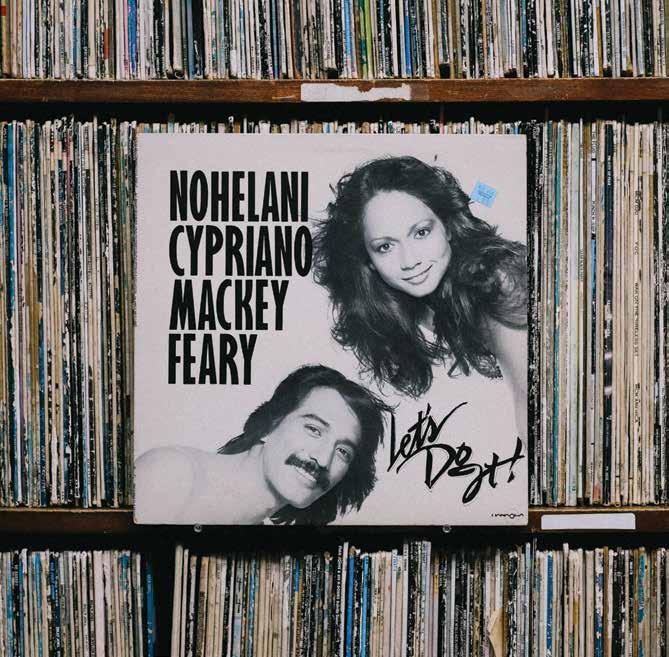

In Praise of Shadows
陰翳礼讃
Moody, but subdued in texture, this season’s penchant for classical colors and gem-toned hues contain an opulent richness.
Images by Mark Kushimi
Styled by Ara Laylo
Hair & makeup by Bailee Nakaahiki,
Holly Tomita, Jonah Dela Cruz, HMB Studios
Modeled by Nalani Sato
Top by ATM Anthony Thomas Melillo; Blazer & pants by Theory; Tiffany HardWear link earrings in 18k gold, from Tiffany & Co.


 Jacket & pants by Brunello Cucinelli; Bag by Loeffler Randall; Slide by Nicholas Kirkwood; Tiffany HardWear link earrings in 18k gold,
Atlas
2-hand
29 mm women’s watch in stainless steel and 18k rose gold, both from Tiffany & Co.
Blazer & pants by Brunello Cucinelli; Slide by Gianvito Rossi; Sunglasses by Gucci; Tiffany HardWear ball hook earrings in 18k gold, Tiffany T chain necklace in 18k gold, Tiffany T smile pendant in 18k gold, Tiffany T wire bracelet in 18k gold, all from Tiffany & Co.
Jacket & pants by Brunello Cucinelli; Bag by Loeffler Randall; Slide by Nicholas Kirkwood; Tiffany HardWear link earrings in 18k gold,
Atlas
2-hand
29 mm women’s watch in stainless steel and 18k rose gold, both from Tiffany & Co.
Blazer & pants by Brunello Cucinelli; Slide by Gianvito Rossi; Sunglasses by Gucci; Tiffany HardWear ball hook earrings in 18k gold, Tiffany T chain necklace in 18k gold, Tiffany T smile pendant in 18k gold, Tiffany T wire bracelet in 18k gold, all from Tiffany & Co.
 Top by ATM Anthony Thomas Melillo; Blazer & pants by Theory; Tiffany HardWear link earrings in 18k gold, all from Tiffany & Co.
Top by ATM Anthony Thomas Melillo; Blazer & pants by Theory; Tiffany HardWear link earrings in 18k gold, all from Tiffany & Co.


Blazer & pants by
by
HardWear ball hook earrings in 18k gold, Tiffany T chain necklace in 18k gold, Tiffany T smile pendant in 18k gold, Tiffany T wire bracelet in 18k gold, Tiffany East West mini 2-hand 37 x 22 mm watch in 18k gold, all from Tiffany & Co.
Brunello Cucinelli; Sunglasses
Gucci; Tiffany
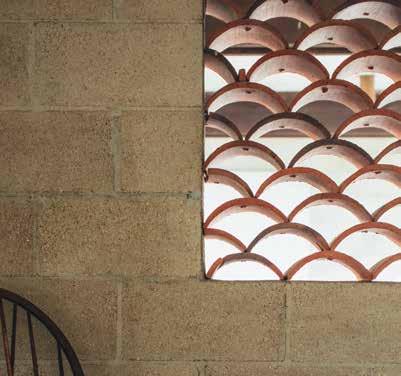
 Coat, top & pants by Brunello Cucinelli; Bag by Chloé; Shoes by Joie; Sunglasses by Fendi; Tiffany HardWear link earrings in 18k gold, Tiffany East West mini 2-hand
37 x 22 mm watch in 18k gold, from Tiffany & Co.
Coat, top & pants by Brunello Cucinelli; Bag by Chloé; Shoes by Joie; Sunglasses by Fendi; Tiffany HardWear link earrings in 18k gold, Tiffany East West mini 2-hand
37 x 22 mm watch in 18k gold, from Tiffany & Co.
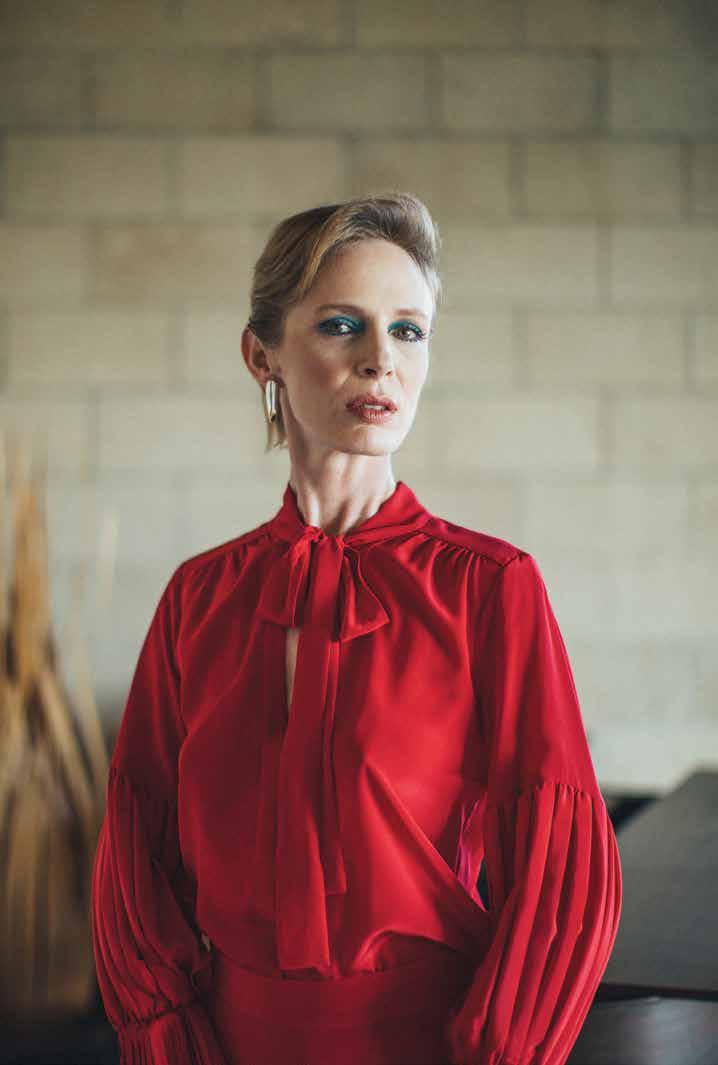
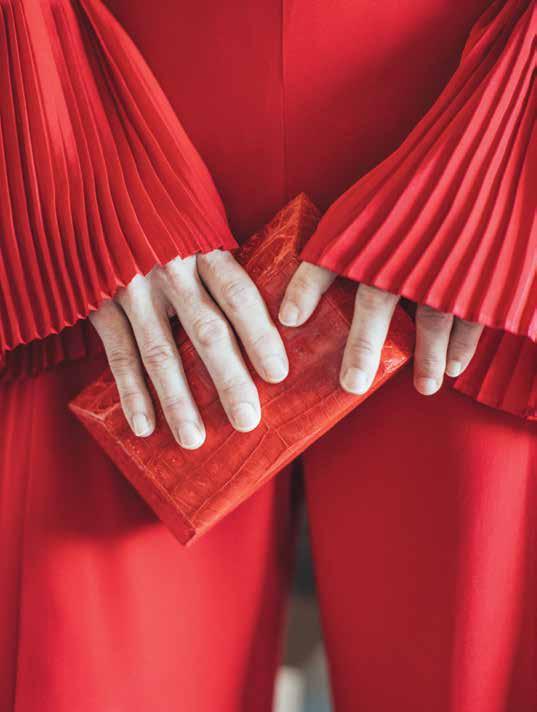 Top & pants by Alexis; Clutch by Nancy Gonzalez; Earrings by M33MS Designs
Top & pants by Alexis; Clutch by Nancy Gonzalez; Earrings by M33MS Designs
Jacket & pants by Brunello Cucinelli; Bag by Loeffler Randall; Slide by Nicholas Kirkwood; Tiffany HardWear link earrings in 18k gold, Atlas 2-hand 29 mm women’s watch in stainless steel and 18k rose gold, both from Tiffany & Co.
Top by Etro; Tiffany Metro 2-hand 28 mm women’s watch in 18k rose gold with diamonds, from Tiffany & Co.
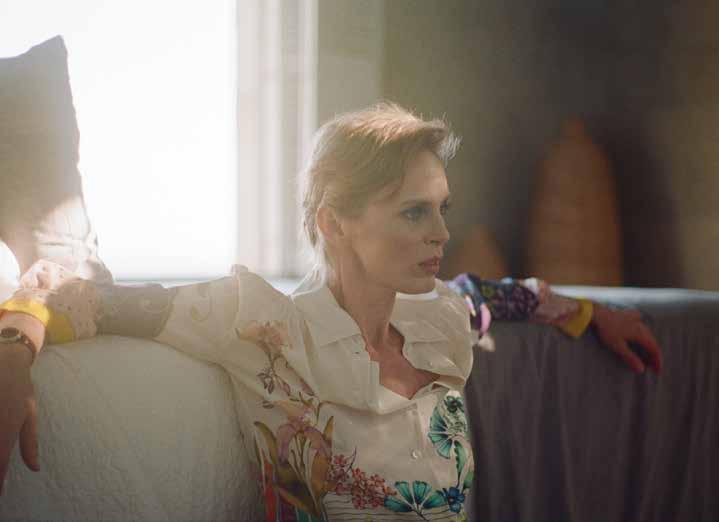

 Dress by Alexis; Tiffany HardWear ball hook earrings in 18k gold, Tiffany T chain necklace in 18k gold, Tiffany HardWear ball wire bracelet in 18k gold, Tiffany HardWear link bracelet in 18k gold, all from Tiffany & Co.
Dress by Alexis; Tiffany HardWear ball hook earrings in 18k gold, Tiffany T chain necklace in 18k gold, Tiffany HardWear ball wire bracelet in 18k gold, Tiffany HardWear link bracelet in 18k gold, all from Tiffany & Co.
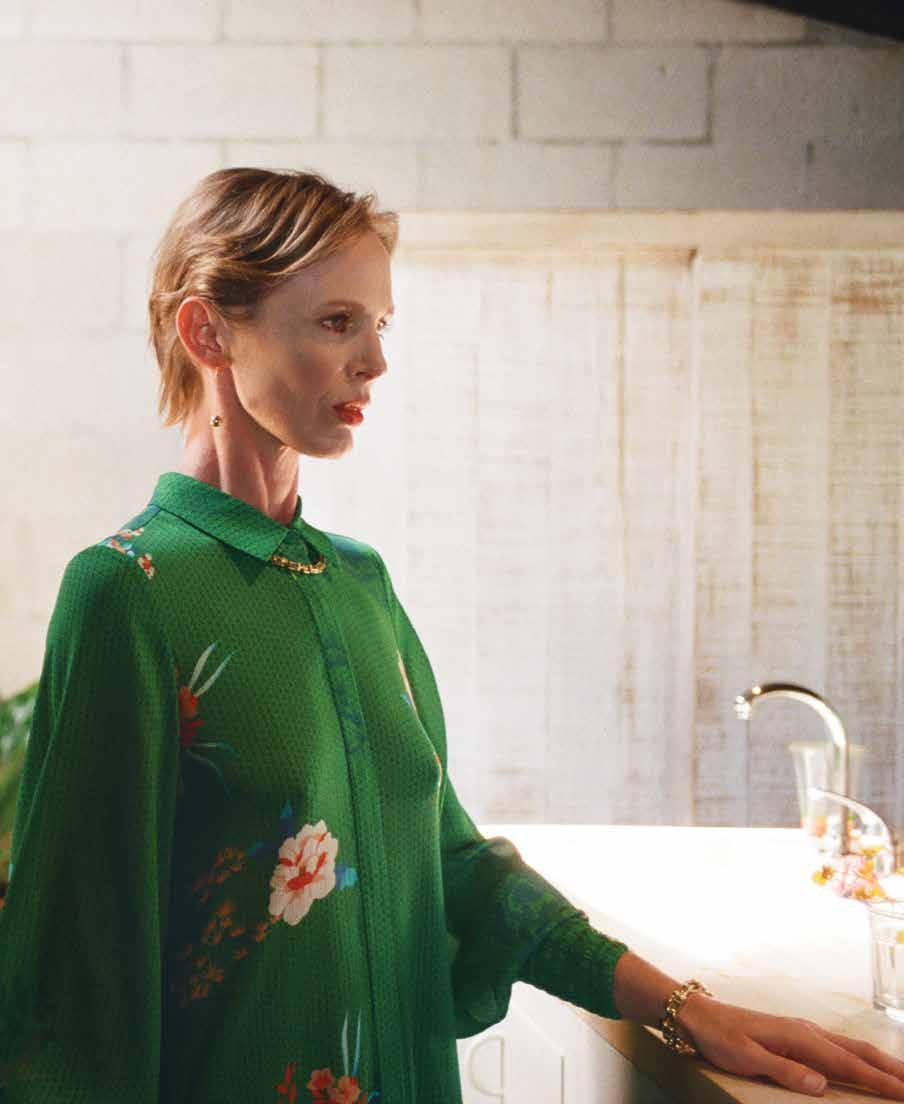
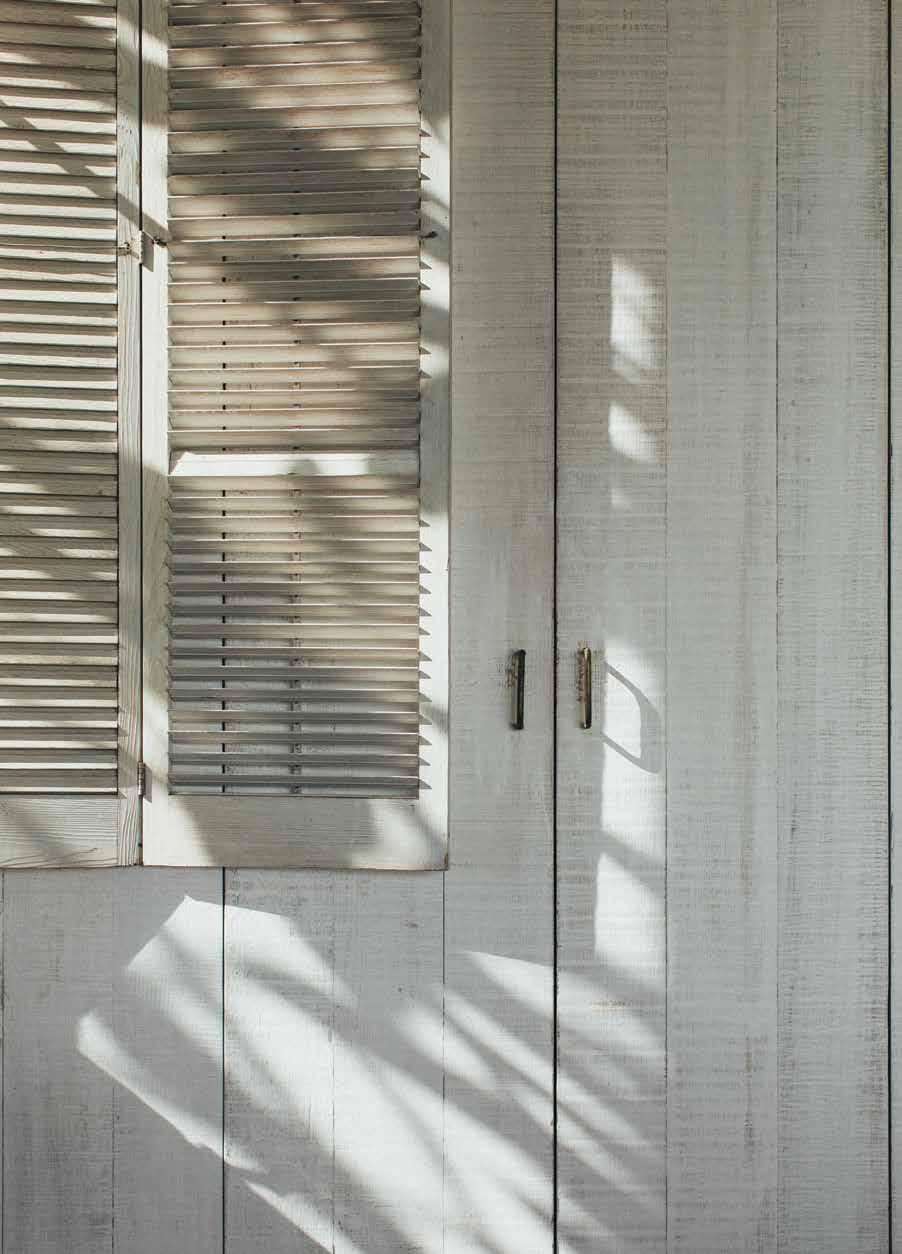
 Top & pants by Etro
Top & pants by Etro
 Top and pants by Alexis; Earrings by M33MS Designs
Top and pants by Alexis; Earrings by M33MS Designs
Travel
ES CA PES
experiences
both
E PALM エスケープ
of place that
CUL TU RE
A sense fosters the human spirit
faraway and familiar
PALM PALM E
127
Among the Mesas
メサに囲まれて
Text by Anna Harmon
Images by IJfke Ridgley
128 E ESCAPES Ghost Ranch PALM
文=アンナ・ハーモン
写真提供=アイフク・リッジリー



A trip to northern New Mexico reveals the wide-open skies and colorful landscapes among which legendary artist Georgia O’Keeffe felt most like herself.
広大な空の下、鮮やかな色彩の風景が待つ ニューメキシコ州北部。伝説的な画家、ジョ ージア・オキーフは、この土地を最も自分らし くいられる場所として愛していました。
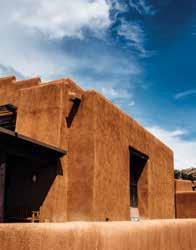
Northern New Mexico was dry as a bone in early July. The hiking paths at Ghost Ranch were closed in case the juniper, cedar, cholla, piñon pine, and sagebrush that swelled and scattered across the landscape were to catch fire. Families there for a retreat buzzed around the campus’s main building as I looked for signs of Georgia O’Keeffe. Where had she walked? What had she painted? Just to the left, a guide pointed out, was the tiny house where O’Keeffe first stayed at the ranch in 1936 after traveling to Taos for several summers. Now you could pay a surprisingly affordable amount to sleep there. Nearby, a bleached cow skull hung on an adobe wall. In the distance was a mountain with a sheared top that I later learned was Cerro Pedernal, a consistent muse of O’Keeffe’s. After she died at the age of 98, her ashes were spread atop it on a windy day.
Soon I boarded a small bus to see spots around the ranch that O’Keeffe had immortalized in oil on canvas. With multicolored mesas surrounding us and junipers twisting up from the earth in all directions, it was hard to narrow down what qualified for painting. O’Keeffe’s choices were even more difficult to predict. While other Western artists who came to New Mexico before the 1930s, and those who came well after, often tried to capture the entirety of the overwhelming vistas, O’Keeffe instead relished the
7月初旬。ニューメキシコ北部は骨のようにからか らに乾いていた。あたり一帯に点々と茂みをなして いるジュニパー(セイヨウネズ)、シダー、チョーヤ カクタス、ピニョンマツ、セージブラッシュといった 草木からいつ山火事が始まるとも限らないので、ゴ ースト・ランチのハイキングトレイルは閉鎖されて いた。リトリートに来ている家族連れがランチの中 心ある建物の回りに集まっているのを横目に、私は ジョージア・オキーフの足あとを探そうとしていた。 オキーフはどこを歩き、何を描いたのだろう?ガイ ドがすぐ左手にある小さな家を指さした。何度も タオスへの夏の旅をしていたオキーフが、1936年 に初めてこのランチを訪れた時に滞在した家だ。 現在では驚くほどリーズナブルな価格でこの家に 宿泊することができる。すぐそばの日干し煉瓦の 壁に、風雨にさらされて真っ白になった牛の頭蓋骨 がかけられている。遠くには、平らな山頂を持つ山 (メサ)が見える。後からこの山がオキーフに常に インスピレーションをもたらしたセロ・ペダナルだ と知った。98歳で亡くなったオキーフの遺灰は、あ る風の強い日にこの山の頂上に撒かれたという。
私は小さなバスに乗り込み、オキーフがキャ ンバスの上にその姿を捉えて永遠のものとした風 景を、ランチ内で見て回った。さまざまな色彩を帯 びたメサに囲まれ、あちこちでジュニパーの樹が大 地から生えだしてあらゆる方向に身を捻っている。 ここでは絵画の題材にふさわしいものが多すぎ て、絞り込むのが難しい。オキーフが選んだ対象 を予想するのは、さらに困難だ。1930年代にニュ ーメキシコに来た他の画家たち、さらにはその後に やってきた多くの画家たちがここの圧倒されるよ
만약 여러분이 뉴멕시코 주가 무엇을 제공해야 하는지 궁금해한 적이 있다면, 한 가지 하이라이트는 화가 조지아 오키프가 살았던 곳이고 땅과 자연의 아름다움을 그녀의 전설적인 예술 작품과 연결시켜주었다. 130 E ESCAPES Ghost Ranch
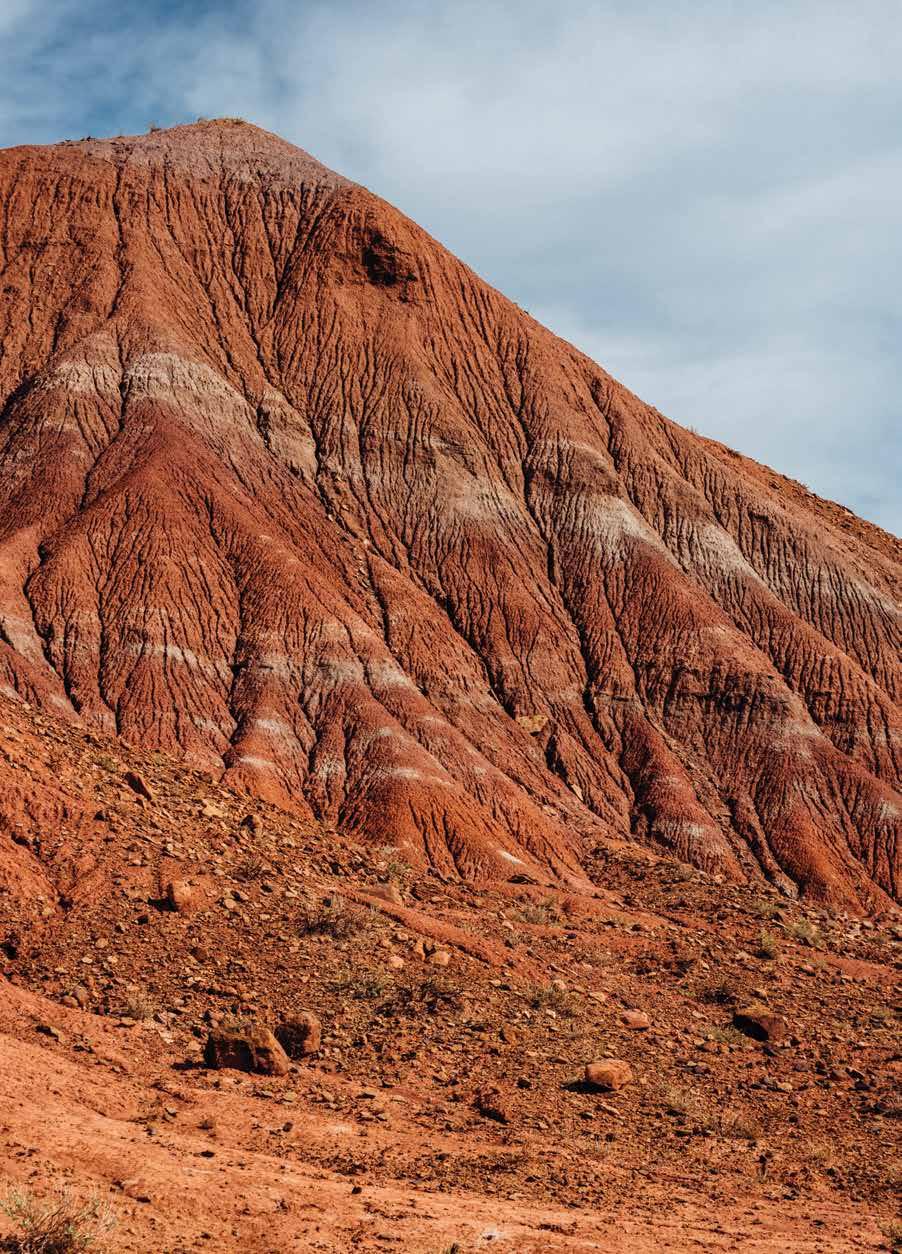


Inside Georgia O’Keeffe’s home and studio in the village of Abiquiú.
details. She enlarged small mesas, centered the crevasses and mounds and skylines that gave rise to shapes in her mind. She did not paint cowboys or young Native women or reverent worshippers in packed Catholic churches, as some of her contemporaries did. Nor did she make portraits of fellow independent white women who were heading southwest. Instead, she looked to the skeletons of the earth.
O’Keeffe spent her childhood in Wisconsin and Virginia and then studied art in Chicago and New York. After brief stints teaching and painting in Virginia, South Carolina, and Texas—where she soaked up the open sky and moods of the plains—she moved to New York in 1918. Beforehand she took a trip to Colorado with her sister, during which she first fell for Santa Fe. Then, in 1929, wealthy art patron
うな風景の全体を捉えようとしたのに対し、オキー フは細部を好んだ。小さなメサを巨大に捉え、そ の裂け目、山塊、心の中に立ち現れる稜線のかた ちを中心に据えた。同時代の画家たちの一部が 好んで描いたカウボーイ、ネイティブ・アメリカンの 若い娘たち、カソリック教会に集まる熱心な信者 たちといった題材をオキーフは取り上げなかった。
自分と同じようにこの米国南西部にやって来た独 立心の強い白人女性の同胞たちの肖像も描かな かった。その代わりにオキーフが見つめたのは、大 地の骨格だった。
オキーフはウィスコンシンとヴァージニアで 幼少時代を送り、シカゴとニューヨークでアートを 学んだ。ヴァージニア、サウスカロライナ、テキサス (ここでオキーフは広々した空と大平原の風情に 親しんだ)で、それぞれ短期間ずつ教職に携わった り絵画を制作した後、1918年にニューヨークに移 住したが、それ以前に一度、妹と共にコロラドに旅
132 E ESCAPES Ghost Ranch PALM



Mabel Dodge Luhan invited the increasingly renowned modernist artist to her property in Taos.
Just as the Southwest had been painted as new territory to be claimed—willfully erasing or exoticizing the Native peoples and Mexicans thriving there—the region held a similar new-world promise for Western artists: The sky unrolled in New Mexico; the earth proffered fresh colors. It seemed raw and dangerous and overwhelming and quiet and pure. Already averse to the rich green and wetness back east, O’Keeffe increasingly favored this setting. She turned a Model A Ford into a traveling studio and bought a house in a more remote area of Ghost Ranch. She spent decades of summers there. Looking at her paintings alongside the landmarks, I got the sense that she was both exposing their bones and giving the land fluidity. She infused crumbly grey hills with deep reds and lavenders that she observed in different moments of the day. “I wish you could see what I see out the window,” she wrote to friend and fellow painter Arthur Dove in September 1942, “the earth pink and yellow cliffs to the north—the full pale moon about to go down in the early morning lavender sky behind a very long beautiful tree covered mesa to the west—pink and purple hills in front and the scrubby fine dull green cedars—and a feeling of much space. It is a very beautiful world.”
In 1945, she purchased a second property in the nearby town of Abiquiú at which to winter. The day after my tour of Ghost Ranch, which is now owned and operated by the Presbyterian Church, I headed to this house. In 1949, it became her permanent residence when she was not summering at Ghost Ranch, travelling the globe, or setting out with friends like nature photographers Ansel Adams and Eliot Porter.
Getting to the home required another ride in a small shuttle, as the village of Abiquiú was protected by a historic land grant and therefore not open to an increasing rush of visitors. Now managed by the Georgia O’Keeffe Museum in Santa Fe, this house was largely how the artist left it before she died in 1986. Dozens of rocks she had collected rested on a boulder outside the expansive windows of her workspace and bedroom. A makeshift ladder to the rooftop leaned against the adobe wall, just as a ladder was still propped up at her house on Ghost Ranch. Even the clothes she made for herself hung in the closet. For a moment, on the tour, you could pretend you were the rare guest taking a quiet moment to soak up her essence.
し、サンタフェに心を惹かれていた。1929年、モダニズムの画家として名を上 げつつあったオキーフを、富裕な芸術の庇護者だったメイベル・ドッジ・ルーハ ンがニューメキシコのタオスに招待する。
米国南西部が新しいフロンティアとして(そしてその地に大昔から住んで いたネイティブ・アメリカンやメキシカンの人々の存在は完全に無視するか、で なければエキゾチックに脚色して)描かれていたのと同様に、ニューメキシコの 土地は画家たちにある種の新世界を約束していた。広々とした大空、新鮮な 色彩を提供する大地。むき出しで、危険で、圧倒的な力を持ち、静謐で、純粋な 土地。東海岸の濃い緑と湿気に飽き飽きしていたオキーフは、ますますニュー メキシコに惹きつけられるようになる。フォードのモデルAをいわば動くアトリ エとして乗り回し、より人里離れたゴースト・ランチに家を購入し、そこで何十 年もの間、夏を過ごした。オキーフの絵画を実際の風景と並べて見てみると、 オキーフは土地の骨格を露わに描くのと同時に、なめらかさを与えているよう に感じる。ほろほろに乾ききった灰色の丘陵を、オキーフは深い赤とラベンダ ー色で描いた。それは1日の中の異なる時間に目にした色彩だった。「私が窓 から見ている風景を貴方も見ることが出来たら良いのに」。画家のアーサー・ダ ブに宛てた1942年9月の手紙で、オキーフはそう語っている。「北の方には鈍 いピンク色と黄色の崖があり、青白い満月がラベンダー色の早朝の空に沈んで 行きます。とても背の高い美しい樹が一本、西側のメサを隠して立ち、メサの 手前にはピンクと紫に染まった丘陵と、鈍い緑のシダーの灌木が見えます。空 間の広さが感じられます。とても美しい世界です」 1945年、オキーフは近郊の村アビキューに、冬を過ごすための第二の 家を購入した。ゴースト・ランチ(現在、ランチは長老派教会が所有·運営してい る)でのツアーの後、私はその家を訪ねてみた。オキーフは1949年以降この 家に定住した。夏の間はゴースト・ランチで過ごし、世界各地を旅し、自然写真 家のアンセル・アダムスやエリオット・ポーターといった友人たちと共に出かけ たが、それ以外の時間をこの家で過ごした。
アビキューの家へは小さなシャトルバスに乗っていかねばならない。ア ビキュー村は歴史的景観保存のために保護されており、観光客が大挙して押 し寄せるのを防いでいる。アビキューの家はサンタフェにあるジョージア·オキ ーフ美術館が管理していて、1986年にオキーフが亡くなる前の状態をほぼ完 全にとどめている。仕事場と寝室の大きな窓から見える巨岩の上には、オキー フが集めたいくつもの岩が並ぶ。屋上に上がるための梯子が日干し煉瓦の壁 に立てかけられている。ゴースト・ランチの家にも同じように梯子が立てかけて あった。オキーフ自作の服までもがクロゼットの中にかけられていて、ツアーの 間のひととき、彼女の家に招かれた数少ない客の一人になったつもりで、オキ
136 E ESCAPES Ghost Ranch PALM


The earthen landscape of New Mexico inspired much of O’Keeffe’s later works.
In 1965, when O’Keeffe was nearly 80 years old, she painted a mural-size cloudscape in her garage at Ghost Ranch. Seven years earlier, she had made her last known painting of Cerro Pedernal, a sacred place to several indigenous peoples. In it, the mountain is a tiny speck among a dark range along the bottom of the canvas. Between this and a half moon, a yellow ladder floats in the open blue.
O’Keeffe became a common sight around Ghost Ranch and Abiquiú, where she took long walks, according to the tour guide. Now anyone can watch a livestream of her garden at the Abiquiú house. On Mondays, during the growing season, it gets its weekly allotment of water from the acequia system. The trenches flood and then the water subsides. It’s as if nothing has changed, except O’Keeffe is both not there, and she is everywhere.
ーフのエッセンスを静かに感じ取ることができる。 1965年、78歳のオキーフは、ゴースト・ランチの自 宅ガレージで壁画サイズの空の絵を描いた。その 7年前にはネイティブ・アメリカンのいくつもの部族 の聖地であるセロ・ペダナルを題材とした最後の 絵を制作している。この絵の中のセロ・ペダナルは キャンバスの一番下に並ぶ暗い丘陵の中の小さな 突起として描かれ、山陵と半月の間には、広い青空 の真ん中に黄色い梯子が浮かんでいる。
ガイドによると、ゴースト・ランチでもアビキ ューでも、長い散歩を日課としていたオキーフの姿 がよく見られたという。現在、アビキューの家の庭 の様子は、ライブストリーミングで世界のどこから でも見ることができる。植物の生育シーズンには、 毎週月曜日、灌漑システムから1週間分の配水が ある。水は溝いっぱいに溢れ、やがておさまってい く。まるで、オキーフの生前と何も変わっていない かのように。オキーフはもうそこにはいないが、そ の場所のすべてに存在しているのだ。
138 E ESCAPES Ghost Ranch PALM

Ala Moana Center, the world’s largest open-air shopping center is home to over 350 stores, including more than 100 dining options.
Ala Moana Center features one of the best collections of luxury brands in the world including Cartier, Chanel, Dior, Gucci, Harry Winston, Hermès, LOUIS VUITTON, Prada, TIFFANY & CO. & many more.
Mon–Sat
• Sun 10am to 7pm 808.955.9517 • FREE WI-FI • AlaMoanaCenter.com 1450 Ala Moana Blvd., Honolulu, HI 96814 Download the Ala Moana Center App from the App Store for iPhone
9:30am to 9pm
An Island Unto Itself
自然体の島
Text by Brittany Lyte
文 = ブリッタニー・ライト
Images by PF Bentley
写真 = PF. ベントレー
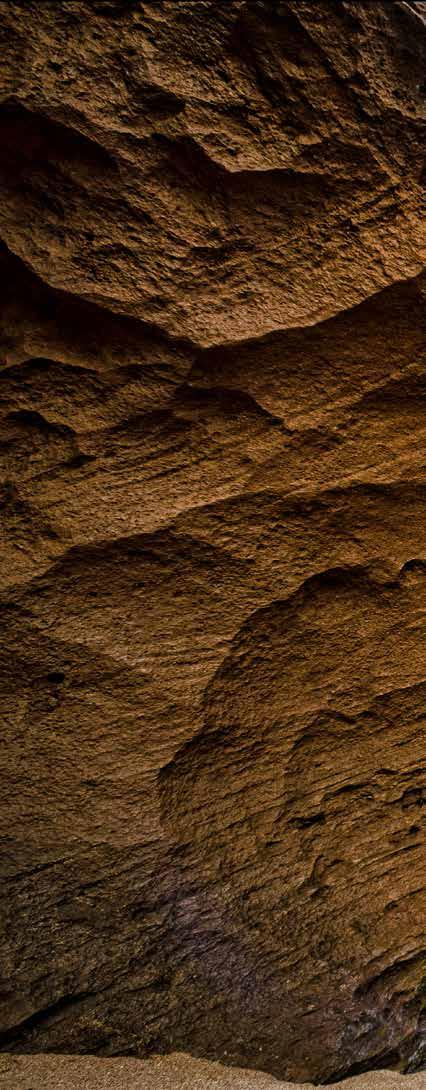
140 E ESCAPES Moloka‘i PALM

The present-day version of Moloka‘i is Old Hawai‘i’s purest residual.
木々に囲まれた海岸線、肩に力が入らない場所。モロカイ島はハワイ の中の魅力的な辺境であり続けています。
그것의 서쪽 끝에서 발견된 Moloka'i의 열
린 공간을 가로질러 여행하고, 요즈음 대부
분의 하와이 섬에서 찾는데 시간이 걸리는 자
유로운 고독에 몸을 담근다. 그 섬에서 아직
도 발견되고 있는 태연한 걸음걸이에 놀라
도록 하라.

On Moloka‘i, where its few thousand residents live closely in sync with indigenous ways, the lei are handmade, lū‘au aren’t mythic ticketed events, and the aloha spirit doesn’t betray a trace of fantasia.
Floating at the midpoint of Waikīkī and west Maui, this island with such a languorous pace is buoyed not by tourism dollars but by the palpable cultural freight steeped in unrehearsed greetings of aloha.
All of this is perhaps clearest on Moloka‘i’s west end, where wide, dusty roads traverse vast ranch lands, then tumble down through ghost towns and out onto empty fringes of sand.
モロカイ島。数千人の島民が昔ながらの親密な生活を守るこの島では、レイ は手作りされ、ルアウはチケットを買って入場する謎めいたイベントではなく、 アロハ・スピリットはいつも変わらずそこにある。ワイキキとウエストマウイの間 に浮かぶこの島では生活のペースはいつもゆったりとしていて、観光客の落と していくお金ではなく、しっかりとした手触りのある文化をその活力の源として いる。演技ではない「アロハ」の挨拶が常に自然に交わされている場所なのだ。
おそらくそれが一番はっきり分かるのは、モロカイ島の西端だろう。幅 広く埃っぽい道路が広大な牧用地を横切り、ゴーストタウンをいくつか通り抜 けると、何もない砂の原に行き当たる。先日モロカイ島に滞在した時、私は一人
142 E ESCAPES Moloka‘i
PALM
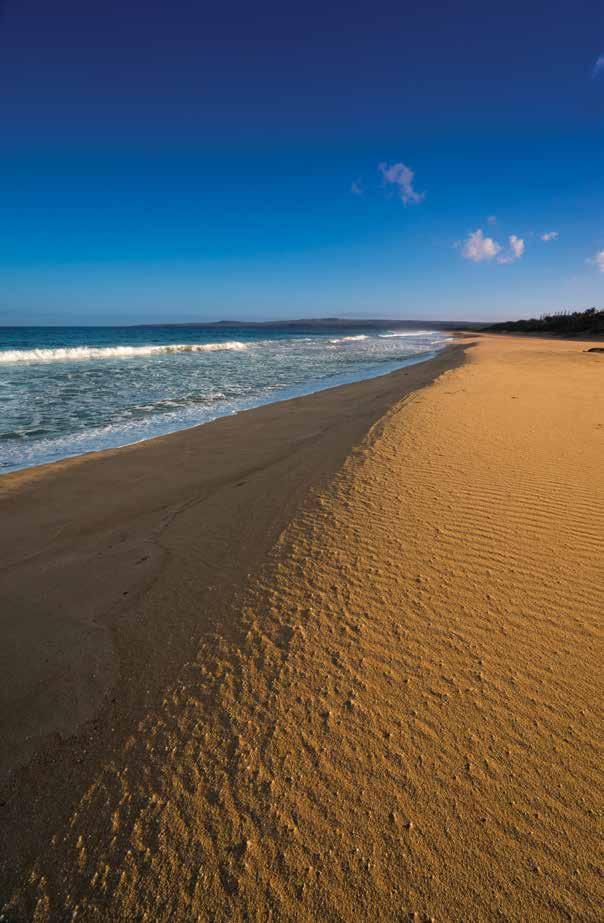



On a recent sojourn, I find myself alone on a hot beach with no marker to tell me its name. It’s a place without parking stalls, with footprints that belong to seabirds and sand crabs.
In awe of the wide-open space around me, I trek across deep sand, hopscotching lava-rock boulders scattered in my path. The nature here is as familiar as an old friend, yet I can’t think of a time I’ve encountered a landscape that seems so unknown to man.
At the beach’s far end, I scurry up and over a sea cliff, landing back down in a new bay of sand. I repeat this process over and over again until I lose count of the number of coves I have entered. Each little bay conceals itself from the next with a scrubby little hillside or a jagged rock ledge. And each bay has its hallmark: a backwall cave;
きりで灼けた砂浜にいた。ビーチの名前を示す看 板もなく、区画割りされた駐車場もない。砂の上に は海鳥と蟹たちの足あとが点々とついていた。
ひらけた空間に心打たれて、私は深い砂の 上を歩いてみた。ところどころに大きな溶岩が散ら ばっていた。自然はまるで旧友のような親しみ深さ を感じさせてくれたが、同時に、これほど人間の世 界からかけ離れたような風景を前にしたことはな いという気持ちにも打たれた。
ビーチの端は小高い丘になっていた。その 丘を乗り越えると、砂浜に縁取られた入り江がも う一つあった。私はいくつも同じように丘を乗り越 えて次の入り江へ下りて行き、そのうち、その入り 江が何番目だったのか数えるのもやめてしまった。 それぞれの小さな入り江は、灌木の生えた丘やご つごつした岩の丘の陰から次々に姿を現した。そ して、入り江は一つ一つ、特徴を持っていた。背後 に洞窟があったり、潮だまりに小さな魚がたくさん
146 E ESCAPES Moloka‘i PALM
Moloka‘i is home to some of the longest and widest beaches in the Hawaiian Islands.
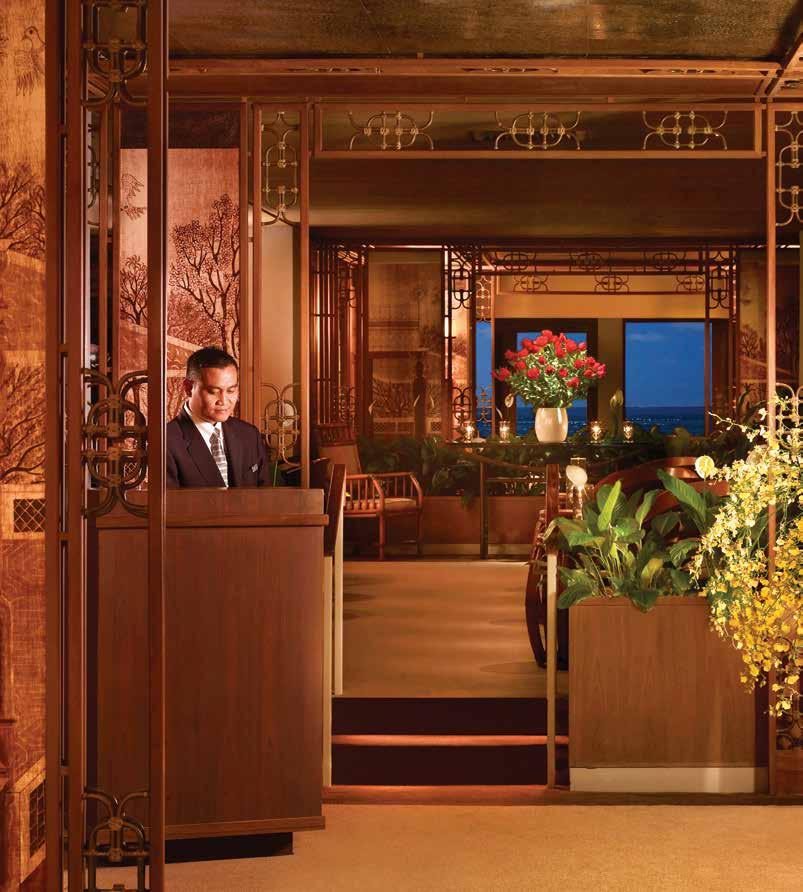
Elevated and Exceptional TRANQUIL, GRACEFUL AND REFINED. FINE DINING AT ITS BEST. RESERVATIONS RECOMMENDED 855.738.4966 www.halekulani.com | 2199 Kalia Road, Honolulu | Complimentary Parking 2018

On the island’s west end, vast ranch lands tumble down and out onto empty fringes of sand.
a tidepool teeming with small, slippery fish; a fresh haul of polychrome shells. There seems no way of knowing when this succession of buttery white beaches will end. Scrapping the guidebook, I let this sylvan coastline’s bare joys reveal themselves to me in their own time. An orange butterfly flits past my nose and I follow it, at first with my eye and then with a sprint, trailing its flight path over the next crag that cleaves one little beach from the next.
Discovery, once an intrinsic aspect of travel, is diminishing in the generation of social media and overtourism. Free of crowds, traffic, and formulaic tourism, Moloka‘i as always been the great outlier. Here, I go without care for the passing hours, embracing the role of solitary witness to the percussive waves soothing the old volcano’s rib under my callused tread.
Then, at last, I meet a rock wall steeper than the rest. I want to dip my sweat-soaked body in the ocean, but jagged rocks clog the waters where it is calm enough to swim. I think about turning back. But, sidestepping the stab of a kiawe thorn, I hoist myself over this final barrier. When was the last time I met the peak of an adventure without any expectation and with no researched picture of what awaits me seared in my head?
いたり、色々な色彩の貝殻がたくさん落ちていたり。バターのようになめらか な白砂のビーチがいったいどこまで続いているのか、私にはまるでわからなか った。ガイドブックなど忘れて、私はこの牧歌的な海岸線がおのずと姿を現す のに任せた。オレンジ色の蝶が鼻先をかすめて飛んでいくのを、最初は目で追 い、次には走って追いかけて、次の小さな砂浜との間を隔てている岩の丘によ じ登った。
かつては何かを発見するということが旅の本質的な部分だったのに、今 ではそれはソーシャルメディアと観光の過熱のせいで得難いものになって来て いる。混雑や交通渋滞、型にはまったツーリズムとは無縁のモロカイ島は、常 に素敵な辺境でありつづけてきた。私はこの場所で、時間も気にせず、自分が 歩く丘の下、古い火山のふところに打ち寄せる波を一人でただ眺めることに満 ち足りていた。
そして最後に、行く手にそれまでよりもずっと険しい岩の壁が現れた。汗 をかいたので海に身体を沈めたかったが、静かな入り江の水の中には尖った 岩が邪魔をしていた。戻ろうかとも考えたが、棘のあるキアヴェの茂みを避け て、私は岩壁に取りかかった。こんな冒険に最後に出会ったのは、一体いつの ことだっただろうか。あらかじめ検索した画像を頭に入れたりもせず、予想も しなかった道をたどったのは?
PALM 148 E ESCAPES Moloka‘i

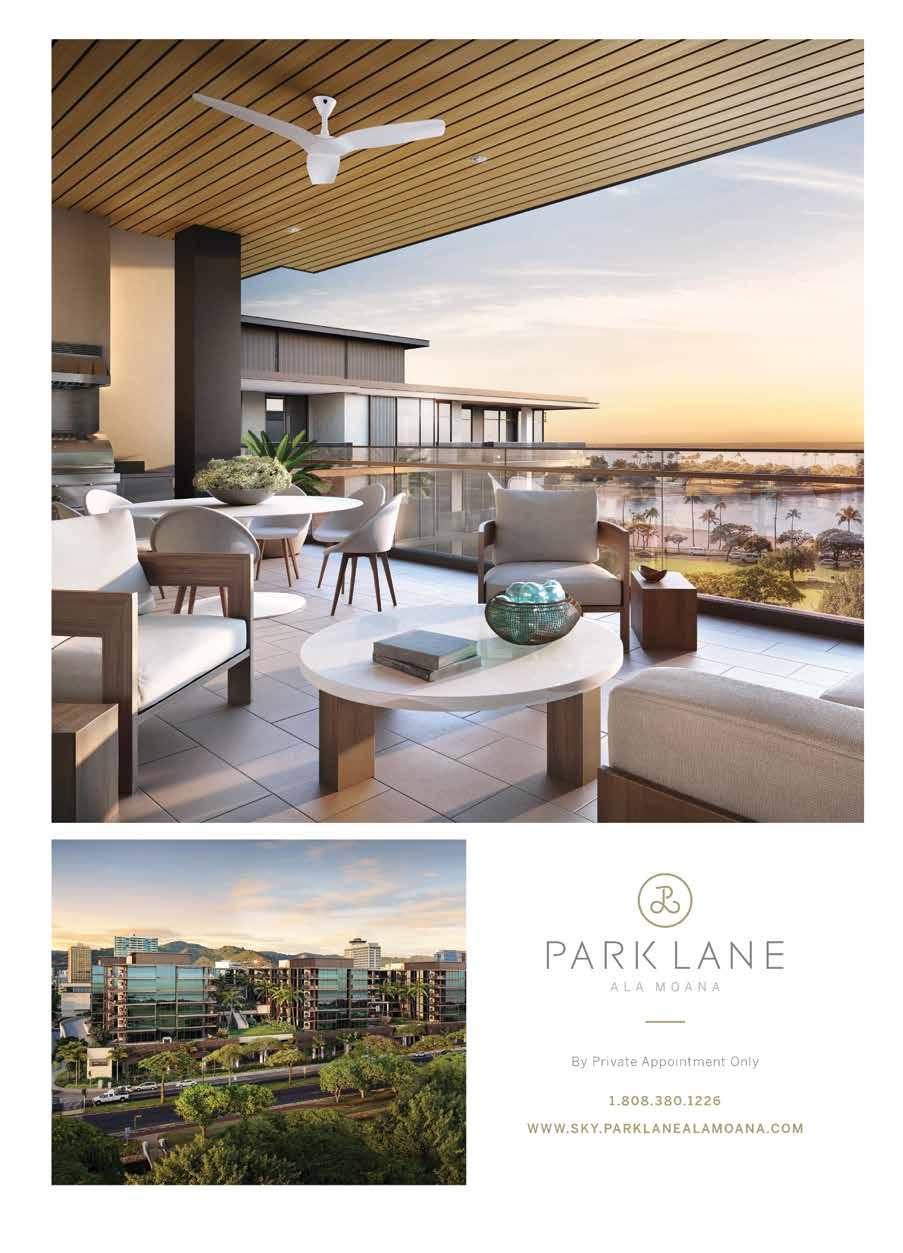



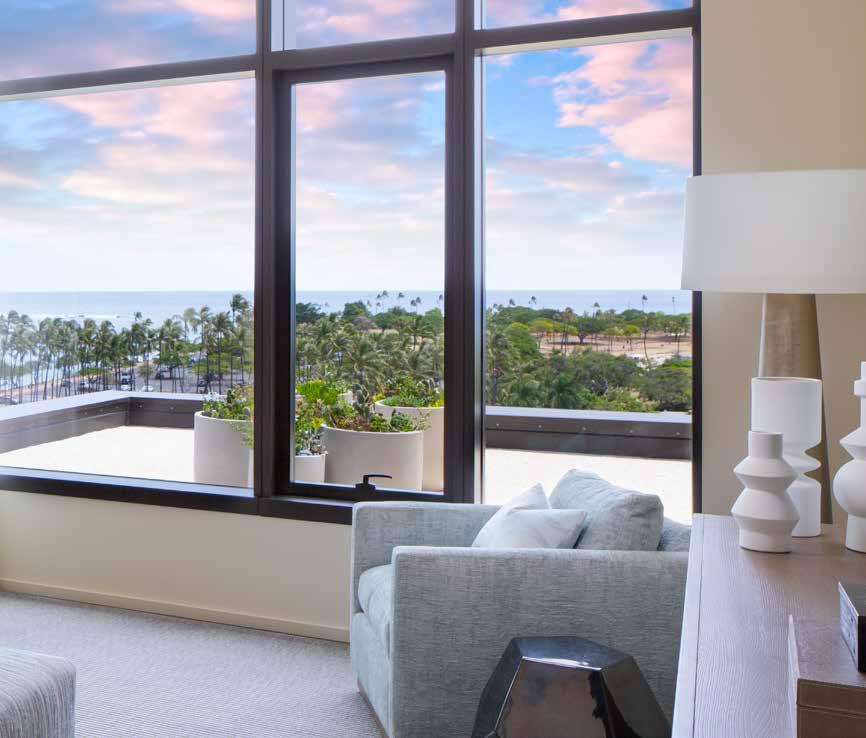
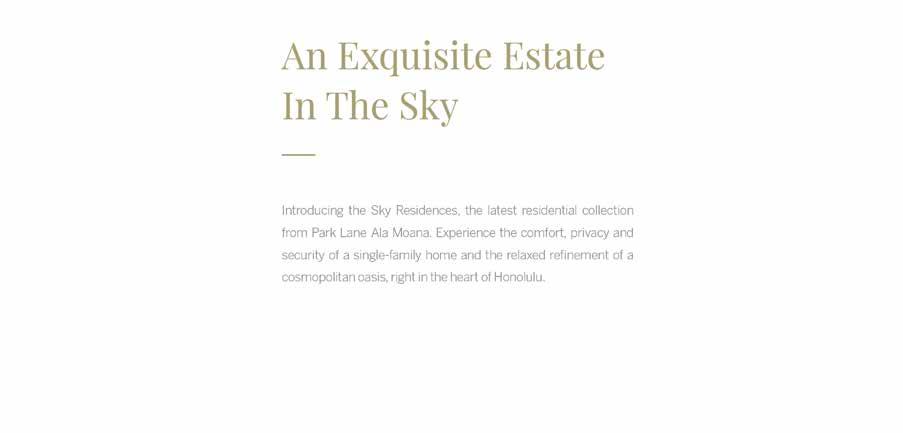

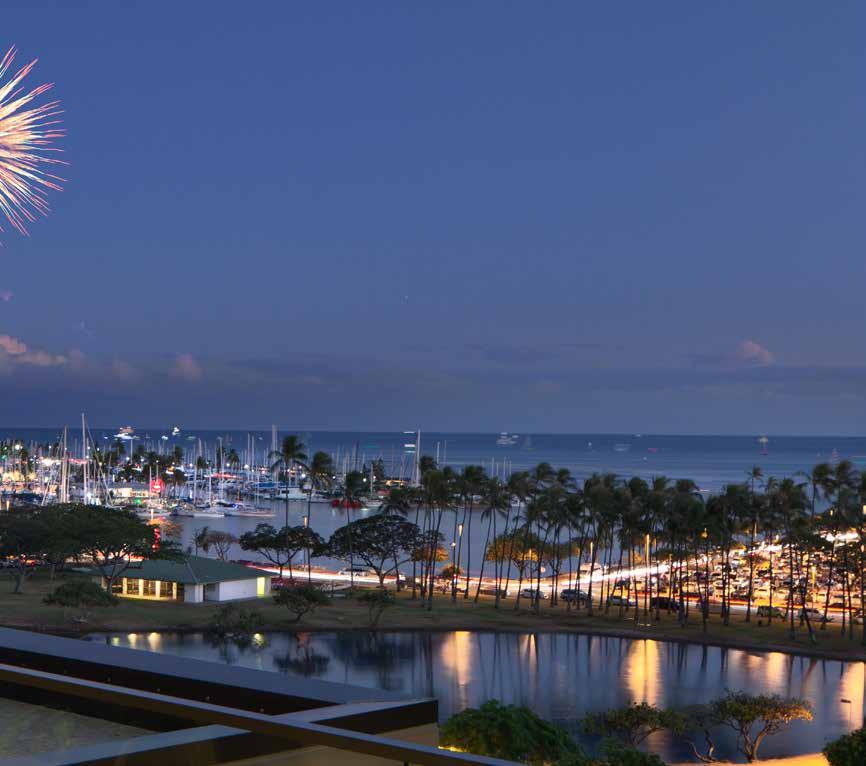


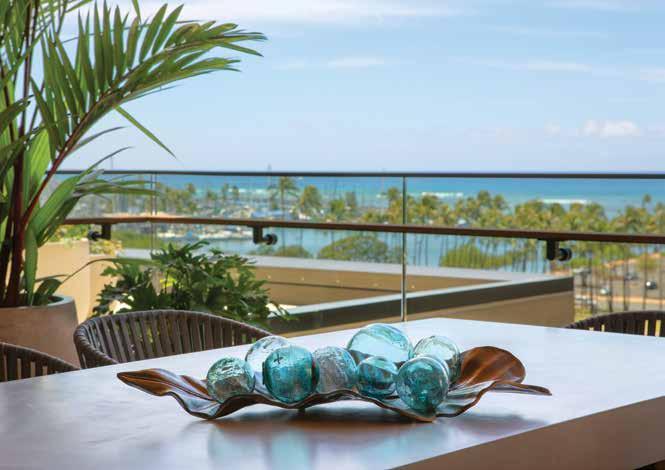




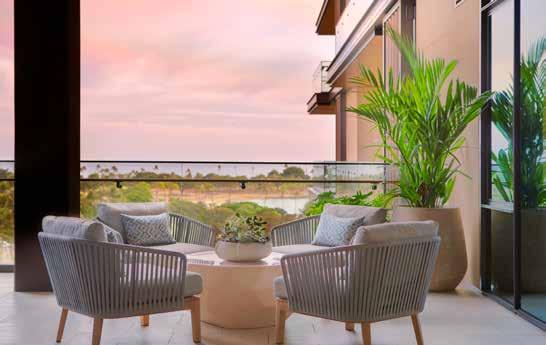





Personalized Service, Elegantly Presented
To Park Your Car or Arrange Transportation PARCEL DELIVERY And Acceptance. All Day / Every Day CONCIERGE
For Daily Needs, Large or Small
SECURE STORAGE
For Beach Gear, Seasonal Items and Everything Else
BEACH SERVICES
Transportation, Setup and Takedown of Beach Gear
GLOBAL COMMUNITY
Multilingual Residential Services Team
EXPERT PLANNING
Special-Event Coordination and Barbecue-Cabana Preparation
24-HOUR SECURITY
For Real Peace — and Peace of Mind
RESIDENCE CARE
Monthly Monitoring and Inspection for Offshore Owners
VALET
Disclaimer: Park Lane Ala Moana (the “Project”) is a proposed project that does not yet exist. It is estimated that the Project will be completed in December of 2017. All figures, facts, information and prices are approximate and subject to change at any time. All renderings, maps, site plans, photos, simulated views, floor plans, graphic images, drawings and all other information depicted in this brochure are illustrative only, and are provided to assist the purchaser in visualizing the residences and the Project and may not be accurately depicted and may be changed at any time. Photos and drawings and other visual depictions of the Project and residences contained in this brochure are artist renderings and should not be relied upon in deciding to purchase a residence. The Developer makes no guarantee, representation or warranty whatsoever that the residences depicted in this brochure will ultimately appear as shown. To the extent permitted by law, the Developer disclaims all liability that may arise out of errors or omissions in the content of this brochure, including any claims for actual or consequential damages. This is not intended to be an offering or solicitation of sale in any jurisdiction where the Project is not registered in accordance with applicable law or where such offering or solicitation would otherwise be prohibited by law. Exclusive Project Broker: Heyer & Associates, LLC. RBO-17416 | Courtesy to qualifying brokers; see project broker for details. 1288 Ala Moana Blvd. Suite 206 | Honolulu, HI 96814. Renderings by Steelblue and Matsma.


162
































 Jules Tavernier. The Volcano at Night , c. 1885-1889. Oil on canvas.
Image: 19 ¾ x 36 ⅝ in. (50.2 x 93 cm). Frame: 25 ¼ x 41 ¼ in. (64.1 x 104.8 cm). Gift of Mrs. E. Faxon Bishop, 1959.
Jules Tavernier. The Volcano at Night , c. 1885-1889. Oil on canvas.
Image: 19 ¾ x 36 ⅝ in. (50.2 x 93 cm). Frame: 25 ¼ x 41 ¼ in. (64.1 x 104.8 cm). Gift of Mrs. E. Faxon Bishop, 1959.




 D. Howard Hitchcock. Halemaumau Eruption at Night , 1917. Oil on canvas Image: 18 x 40 in. (45.7 x 101.6 cm). Frame: 23 ½ x 45 ¼ in. (59.7 x 114.9 cm). Gift of Aaron G. Marcus, 1978.
D. Howard Hitchcock. Halemaumau Eruption at Night , 1917. Oil on canvas Image: 18 x 40 in. (45.7 x 101.6 cm). Frame: 23 ½ x 45 ¼ in. (59.7 x 114.9 cm). Gift of Aaron G. Marcus, 1978.

















 Jake and Noa Mizuno thrive on the creative energy found throughout Kaka‘ako, home to their hip retail surf shops Milo and Stoke House.
Jake and Noa Mizuno thrive on the creative energy found throughout Kaka‘ako, home to their hip retail surf shops Milo and Stoke House.










































 Maxine Kahaulelio, circa 1981.
Maxine Kahaulelio, circa 1981.



 Moanike‘ala Akaka and artist Tomas Belsky in Hilo, 1976.
Moanike‘ala Akaka and artist Tomas Belsky in Hilo, 1976.
 Moanike‘ala Akaka, Honolulu, 1972.
Moanike‘ala Akaka, Honolulu, 1972.

 Loretta and her three children in Pelekunu, Moloka‘i, circa 1979.
Loretta and her three children in Pelekunu, Moloka‘i, circa 1979.







 The standard design of manual typewriters have become more chic and celebrated over time.
The standard design of manual typewriters have become more chic and celebrated over time.




































 Jacket & pants by Brunello Cucinelli; Bag by Loeffler Randall; Slide by Nicholas Kirkwood; Tiffany HardWear link earrings in 18k gold,
Atlas
2-hand
29 mm women’s watch in stainless steel and 18k rose gold, both from Tiffany & Co.
Blazer & pants by Brunello Cucinelli; Slide by Gianvito Rossi; Sunglasses by Gucci; Tiffany HardWear ball hook earrings in 18k gold, Tiffany T chain necklace in 18k gold, Tiffany T smile pendant in 18k gold, Tiffany T wire bracelet in 18k gold, all from Tiffany & Co.
Jacket & pants by Brunello Cucinelli; Bag by Loeffler Randall; Slide by Nicholas Kirkwood; Tiffany HardWear link earrings in 18k gold,
Atlas
2-hand
29 mm women’s watch in stainless steel and 18k rose gold, both from Tiffany & Co.
Blazer & pants by Brunello Cucinelli; Slide by Gianvito Rossi; Sunglasses by Gucci; Tiffany HardWear ball hook earrings in 18k gold, Tiffany T chain necklace in 18k gold, Tiffany T smile pendant in 18k gold, Tiffany T wire bracelet in 18k gold, all from Tiffany & Co.
 Top by ATM Anthony Thomas Melillo; Blazer & pants by Theory; Tiffany HardWear link earrings in 18k gold, all from Tiffany & Co.
Top by ATM Anthony Thomas Melillo; Blazer & pants by Theory; Tiffany HardWear link earrings in 18k gold, all from Tiffany & Co.



 Coat, top & pants by Brunello Cucinelli; Bag by Chloé; Shoes by Joie; Sunglasses by Fendi; Tiffany HardWear link earrings in 18k gold, Tiffany East West mini 2-hand
37 x 22 mm watch in 18k gold, from Tiffany & Co.
Coat, top & pants by Brunello Cucinelli; Bag by Chloé; Shoes by Joie; Sunglasses by Fendi; Tiffany HardWear link earrings in 18k gold, Tiffany East West mini 2-hand
37 x 22 mm watch in 18k gold, from Tiffany & Co.

 Top & pants by Alexis; Clutch by Nancy Gonzalez; Earrings by M33MS Designs
Top & pants by Alexis; Clutch by Nancy Gonzalez; Earrings by M33MS Designs


 Dress by Alexis; Tiffany HardWear ball hook earrings in 18k gold, Tiffany T chain necklace in 18k gold, Tiffany HardWear ball wire bracelet in 18k gold, Tiffany HardWear link bracelet in 18k gold, all from Tiffany & Co.
Dress by Alexis; Tiffany HardWear ball hook earrings in 18k gold, Tiffany T chain necklace in 18k gold, Tiffany HardWear ball wire bracelet in 18k gold, Tiffany HardWear link bracelet in 18k gold, all from Tiffany & Co.


 Top & pants by Etro
Top & pants by Etro
 Top and pants by Alexis; Earrings by M33MS Designs
Top and pants by Alexis; Earrings by M33MS Designs













































